9.1: The Production Function
9.1.1: Defining the Production Function
The production function relates the maximum amount of output that can be obtained from a given number of inputs.
Learning Objective
Define the production function
Key Points
- The production function describes a boundary or frontier representing the limit of output obtainable from each feasible combination of inputs.
- Firms use the production function to determine how much output they should produce given the price of a good, and what combination of inputs they should use to produce given the price of capital and labor.
- The production function also gives information about increasing or decreasing returns to scale and the marginal products of labor and capital.
Key Terms
- marginal cost
-
The increase in cost that accompanies a unit increase in output; the partial derivative of the cost function with respect to output. Additional cost associated with producing one more unit of output.
- Production function
-
Relates physical output of a production process to physical inputs or factors of production.
- output
-
Production; quantity produced, created, or completed.
In economics, a production function relates physical output of a production process to physical inputs or factors of production. It is a mathematical function that relates the maximum amount of output that can be obtained from a given number of inputs – generally capital and labor. The production function, therefore, describes a boundary or frontier representing the limit of output obtainable from each feasible combination of inputs.
Firms use the production function to determine how much output they should produce given the price of a good, and what combination of inputs they should use to produce given the price of capital and labor (). When firms are deciding how much to produce they typically find that at high levels of production, their marginal costs begin increasing. This is also known as diminishing returns to scale – increasing the quantity of inputs creates a less-than-proportional increase in the quantity of output. If it weren’t for diminishing returns to scale, supply could expand without limits without increasing the price of a good.
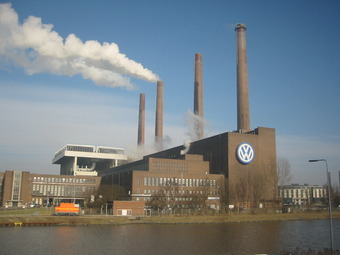
Factory Production
Manufacturing companies use their production function to determine the optimal combination of labor and capital to produce a certain amount of output.
Increasing marginal costs can be identified using the production function. If a firm has a production function Q=F(K,L) (that is, the quantity of output (Q) is some function of capital (K) and labor (L)), then if 2Q<F(2K,2L), the production function has increasing marginal costs and diminishing returns to scale. Similarly, if 2Q>F(2K,2L), there are increasing returns to scale, and if 2Q=F(2K,2L), there are constant returns to scale.
Examples of Common Production Functions
One very simple example of a production function might be Q=K+L, where Q is the quantity of output, K is the amount of capital, and L is the amount of labor used in production. This production function says that a firm can produce one unit of output for every unit of capital or labor it employs. From this production function we can see that this industry has constant returns to scale – that is, the amount of output will increase proportionally to any increase in the amount of inputs.
Another common production function is the Cobb-Douglas production function. One example of this type of function is Q=K0.5L0.5. This describes a firm that requires the least total number of inputs when the combination of inputs is relatively equal. For example, the firm could produce 25 units of output by using 25 units of capital and 25 of labor, or it could produce the same 25 units of output with 125 units of labor and only one unit of capital.
Finally, the Leontief production function applies to situations in which inputs must be used in fixed proportions; starting from those proportions, if usage of one input is increased without another being increased, output will not change. This production function is given by Q=Min(K,L). For example, a firm with five employees will produce five units of output as long as it has at least five units of capital.
9.1.2: The Law of Diminishing Returns
The law of diminishing returns states that adding more of one factor of production will at some point yield lower per-unit returns.
Learning Objective
Explain the Law of Diminishing Returns
Key Points
- One consequence of the law of diminishing returns is that producing one more unit of output will eventually cost increasingly more, due to inputs being used less and less effectively.
- The marginal cost curve will initially be downward sloping, representing added efficiency as production increases. If the law of diminishing returns holds, however, the marginal cost curve will eventually slope upward and continue to rise.
- The SRAC is typically U-shaped with its minimum at the point where it intersect the marginal cost curve. This is caused by the first increasing, and then decreasing, marginal returns to labor.
- The typical LRAC curve is also U-shaped, reflecting increasing returns of scale where negatively-sloped, constant returns to scale where horizontal and decreasing returns where positively sloped.
Key Terms
- returns to scale
-
A term referring to changes in output resulting from a proportional change in all inputs (where all inputs increase by a constant factor).
- marginal cost
-
The increase in cost that accompanies a unit increase in output; the partial derivative of the cost function with respect to output. Additional cost associated with producing one more unit of output.
In economics, diminishing returns (also called diminishing marginal returns) is the decrease in the marginal output of a production process as the amount of a single factor of production is increased, while the amounts of all other factors of production stay constant. The law of diminishing returns states that in all productive processes, adding more of one factor of production, while holding all others constant (“ceteris paribus”), will at some point yield lower per-unit returns . The law of diminishing returns does not imply that adding more of a factor will decrease the total production, a condition known as negative returns, though in fact this is common.
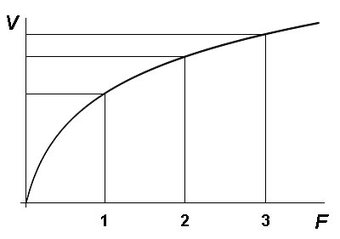
Diminishing Returns
As a factor of production (F) increases, the resulting gain in the volume of output (V) gets smaller and smaller.
For example, the use of fertilizer improves crop production on farms and in gardens; but at some point, adding more and more fertilizer improves the yield less per unit of fertilizer, and excessive quantities can even reduce the yield. A common sort of example is adding more workers to a job, such as assembling a car on a factory floor. At some point, adding more workers causes problems such as workers getting in each other’s way or frequently finding themselves waiting for access to a part. In all of these processes, producing one more unit of output will eventually cost increasingly more, due to inputs being used less and less effectively.
This increase in the marginal cost of output as production increases can be graphed as the marginal cost curve, with quantity of output on the x axis and marginal cost on the y axis. For many firms, the marginal cost curve will initially be downward sloping, representing added efficiency as production increases. If the law of diminishing returns holds, however, the marginal cost curve will eventually slope upward and continue to rise, representing the higher and higher marginal costs associated with additional output.
The Law of Diminishing Returns and Average Cost
The average total cost of production is the total cost of producing all output divided by the number of units produced. For example, if the car factory can produce 20 cars at a total cost of $200,000, the average cost of production is $10,000. Average total cost is interpreted as the the cost of a typical unit of production. So in our example each of the 20 cars produced had a typical cost per unit of $10,000. Average total cost can also be graphed with quantity of output on the x axis and average cost on the y-axis.
What will this average total cost curve look like? In the short run, a firm has a set amount of capital and can only increase or decrease production by hiring more or less labor. The fixed costs of capital are high, but the variable costs of labor are low, so costs increase more slowly than output as production increases. As long as the marginal cost of production is lower than the average total cost of production, the average cost is decreasing. However, as marginal costs increase due to the law of diminishing returns, the marginal cost of production will eventually be higher than the average total cost and the average cost will begin to increase. The short run average total cost curve (SRAC) will therefore be U-shaped for most firms .

Cost Curves in the Short Run
Both marginal cost and average cost are U-shaped due to first increasing, and then diminishing, returns. Average cost begins to increase where it intersects the marginal cost curve.
The long-run average cost curve (LRAC) depicts the cost per unit of output in the long run—that is, when all productive inputs’ usage levels can be varied. The typical LRAC curve is also U-shaped but for different reasons: it reflects increasing returns to scale where negatively-sloped, constant returns to scale where horizontal, and decreasing returns (due to increases in factor prices) where positively sloped.
9.1.3: Inputs and Outputs of the Function
In the basic production function, inputs are typically capital and labor and output is whatever good the firm produces.
Learning Objective
Describe the inputs and outputs in a generalized production function
Key Points
- Capital refers to the material objects necessary for production. In the short run, economists assume that the level of capital is fixed.
- Labor refers to the human work that goes into production. Typically economists assume that labor is a variable factor of production.
- The marginal product of an input is the amount of output that is gained by using one additional unit of that input. It can be found by taking the derivative of the production function in terms of the relevant input.
Key Terms
- rental rate
-
The price of capital.
- capital
-
Already-produced durable goods available for use as a factor of production, such as steam shovels (equipment) and office buildings (structures).
- marginal product
-
The extra output that can be produced by using one more unit of the input.
A production function relates the input of factors of production to the output of goods. In the basic production function inputs are typically capital and labor, though more expansive and complex production functions may include other variables such as land or natural resources. Output may be any consumer good produced by a firm. Cars, clothing, sandwiches, and toys are all examples of output.
Capital refers to the material objects necessary for production. Machinery, factory space, and tools are all types of capital. In the short run, economists assume that the level of capital is fixed – firms can’t sell machinery the moment it’s no longer needed, nor can they build a new factory and start producing goods there immediately. When looking at the production function in the short run, therefore, capital will be a constant rather than a variable. Although in reality a firm may own the capital that it uses, economists typically refer to the ongoing cost of employing capital as the rental rate because the opportunity cost of employing capital is the income that a firm could receive by renting it out. Thus, the price of capital is the rental rate.

Capital Goods
Capital equipment, like these motor graders, can vary in the long run but are fixed in the short run.
Labor refers to the human work that goes into production. Typically economists assume that labor is a variable factor of production; it can be increased or decreased in the short run in order to produce more or less output. The price of labor is the prevailing wage rate, since wages are the cost of hiring an additional unit of capital.
The marginal product of an input is the amount of output that is gained by using one additional unit of that input. It can be found by taking the derivative of the production function in terms of the relevant input. For example, if the production function is Q=3K+2L (where K represents units of capital and L represents units of labor), then the marginal product of capital is simply three; every additional unit of capital will produce an additional three units of output. Inputs are typically subject to the law of diminishing returns: as the amount of one factor of production increases, after a certain point the marginal product of that factor declines.
9.2: Production Cost
9.2.1: Types of Costs
Variable costs change according to the quantity of goods produced; fixed costs are independent of the quantity of goods being produced.
Learning Objective
Differentiate fixed costs and variable costs
Key Points
- Total cost is the sum of fixed and variable costs.
- Variable costs change according to the quantity of a good or service being produced. The amount of materials and labor that is needed for to make a good increases in direct proportion to the number of goods produced. The cost “varies” according to production.
- Fixed costs are independent of the quality of goods or services produced. Fixed costs (also referred to as overhead costs) tend to be time related costs including salaries or monthly rental fees.
- Fixed costs are only short term and do change over time. The long run is sufficient time of all short-run inputs that are fixed to become variable.
Key Terms
- fixed cost
-
Business expenses that are not dependent on the level of goods or services produced by the business.
- variable cost
-
A cost that changes with the change in volume of activity of an organization.
Total Cost
In economics, the total cost (TC) is the total economic cost of production. It consists of variable costs and fixed costs. Total cost is the total opportunity cost of each factor of production as part of its fixed or variable costs .

Calculating total cost
This graphs shows the relationship between fixed cost and variable cost. The sum of the two equal the total cost.
Variable Costs
Variable cost (VC) changes according to the quantity of a good or service being produced. It includes inputs like labor and raw materials. Variable costs are also the sum of marginal costs over all of the units produced (referred to as normal costs). For example, in the case of a clothing manufacturer, the variable costs would be the cost of the direct material (cloth) and the direct labor. The amount of materials and labor that is needed for each shirt increases in direct proportion to the number of shirts produced. The cost “varies” according to production.
Fixed Costs
Fixed costs (FC) are incurred independent of the quality of goods or services produced. They include inputs (capital) that cannot be adjusted in the short term, such as buildings and machinery. Fixed costs (also referred to as overhead costs) tend to be time related costs, including salaries or monthly rental fees. An example of a fixed cost would be the cost of renting a warehouse for a specific lease period. However, fixed costs are not permanent. They are only fixed in relation to the quantity of production for a certain time period. In the long run, the cost of all inputs is variable.
Economic Cost
The economic cost of a decision that a firm makes depends on the cost of the alternative chosen and the benefit that the best alternative would have provided if chosen. Economic cost is the sum of all the variable and fixed costs (also called accounting cost) plus opportunity costs.
9.2.2: Average and Marginal Cost
Marginal cost is the change in total cost when another unit is produced; average cost is the total cost divided by the number of goods produced.
Learning Objective
Distinguish between marginal and average costs
Key Points
- The marginal cost is the cost of producing one more unit of a good.
- Marginal cost includes all of the costs that vary with the level of production. For example, if a company needs to build a new factory in order to produce more goods, the cost of building the factory is a marginal cost.
- Economists analyze both short run and long run average cost. Short run average costs vary in relation to the quantity of goods being produced. Long run average cost includes the variation of quantities used for all inputs necessary for production.
- When the average cost declines, the marginal cost is less than the average cost. When the average cost increases, the marginal cost is greater than the average cost. When the average cost stays the same (is at a minimum or maximum), the marginal cost equals the average cost.
Key Terms
- marginal cost
-
The increase in cost that accompanies a unit increase in output; the partial derivative of the cost function with respect to output. Additional cost associated with producing one more unit of output.
- average cost
-
In economics, average cost or unit cost is equal to total cost divided by the number of goods produced.
Marginal Cost
In economics, marginal cost is the change in the total cost when the quantity produced changes by one unit. It is the cost of producing one more unit of a good. Marginal cost includes all of the costs that vary with the level of production. For example, if a company needs to build a new factory in order to produce more goods, the cost of building the factory is a marginal cost. The amount of marginal cost varies according to the volume of the good being produced. Economic factors that impact the marginal cost include information asymmetries, positive and negative externalities, transaction costs, and price discrimination. Marginal cost is not related to fixed costs. An example of calculating marginal cost is: the production of one pair of shoes is $30. The total cost for making two pairs of shoes is $40. The marginal cost of producing the second pair of shoes is $10.
Average Cost
The average cost is the total cost divided by the number of goods produced. It is also equal to the sum of average variable costs and average fixed costs. Average cost can be influenced by the time period for production (increasing production may be expensive or impossible in the short run). Average costs are the driving factor of supply and demand within a market. Economists analyze both short run and long run average cost. Short run average costs vary in relation to the quantity of goods being produced. Long run average cost includes the variation of quantities used for all inputs necessary for production.
Relationship Between Average and Marginal Cost
Average cost and marginal cost impact one another as production fluctuate :

Cost curve
This graph is a cost curve that shows the average total cost, marginal cost, and marginal revenue. The curves show how each cost changes with an increase in product price and quantity produced.
- When the average cost declines, the marginal cost is less than the average cost.
- When the average cost increases, the marginal cost is greater than the average cost.
- When the average cost stays the same (is at a minimum or maximum), the marginal cost equals the average cost.
9.2.3: Short Run and Long Run Costs
Long run costs have no fixed factors of production, while short run costs have fixed factors and variables that impact production.
Learning Objective
Explain the differences between short and long run costs
Key Points
- In the short run, there are both fixed and variable costs.
- In the long run, there are no fixed costs.
- Efficient long run costs are sustained when the combination of outputs that a firm produces results in the desired quantity of the goods at the lowest possible cost.
- Variable costs change with the output. Examples of variable costs include employee wages and costs of raw materials.
- The short run costs increase or decrease based on variable cost as well as the rate of production. If a firm manages its short run costs well over time, it will be more likely to succeed in reaching the desired long run costs and goals.
Key Terms
- fixed cost
-
Business expenses that are not dependent on the level of goods or services produced by the business.
- variable cost
-
A cost that changes with the change in volume of activity of an organization.
In economics, “short run” and “long run” are not broadly defined as a rest of time. Rather, they are unique to each firm.
Long Run Costs
Long run costs are accumulated when firms change production levels over time in response to expected economic profits or losses. In the long run there are no fixed factors of production. The land, labor, capital goods, and entrepreneurship all vary to reach the the long run cost of producing a good or service. The long run is a planning and implementation stage for producers. They analyze the current and projected state of the market in order to make production decisions. Efficient long run costs are sustained when the combination of outputs that a firm produces results in the desired quantity of the goods at the lowest possible cost. Examples of long run decisions that impact a firm’s costs include changing the quantity of production, decreasing or expanding a company, and entering or leaving a market.
Short Run Costs
Short run costs are accumulated in real time throughout the production process. Fixed costs have no impact of short run costs, only variable costs and revenues affect the short run production. Variable costs change with the output. Examples of variable costs include employee wages and costs of raw materials. The short run costs increase or decrease based on variable cost as well as the rate of production. If a firm manages its short run costs well over time, it will be more likely to succeed in reaching the desired long run costs and goals.
Differences
The main difference between long run and short run costs is that there are no fixed factors in the long run; there are both fixed and variable factors in the short run . In the long run the general price level, contractual wages, and expectations adjust fully to the state of the economy. In the short run these variables do not always adjust due to the condensed time period. In order to be successful a firm must set realistic long run cost expectations. How the short run costs are handled determines whether the firm will meet its future production and financial goals.

Cost curve
This graph shows the relationship between long run and short run costs.
9.2.4: Economies and Diseconomies of Scale
Increasing, constant, and diminishing returns to scale describe how quickly output rises as inputs increase.
Learning Objective
Identify the three types of returns to scale and describe how they occur
Key Points
- In economics, returns to scale describes what happens when the scale of production increases over the long run when all input levels are variable (chosen by the firm).
- Increasing returns to scale (IRS) refers to a production process where an increase in the number of units produced causes a decrease in the average cost of each unit.
- Constant returns to scale (CRS) refers to a production process where an increase in the number of units produced causes no change in the average cost of each unit.
- Diminishing returns to scale (DRS) refers to production where the costs for production do not decrease as a result of increased production. The DRS is the opposite of the IRS.
Key Terms
- average cost
-
In economics, average cost or unit cost is equal to total cost divided by the number of goods produced.
- return to scale
-
A term referring to changes in output resulting from a proportional change in all inputs (where all inputs increase by a constant factor).
In economics, returns to scale describes what happens when the scale of production increases over the long run when all input levels are variable (chosen by the firm). Returns to scale explains how the rate of increase in production is related to the increase in inputs in the long run. There are three stages in the returns to scale: increasing returns to scale (IRS), constant returns to scale (CRS), and diminishing returns to scale (DRS). Returns to scale vary between industries, but typically a firm will have increasing returns to scale at low levels of production, decreasing returns to scale at high levels of production, and constant returns to scale at some point in the middle .
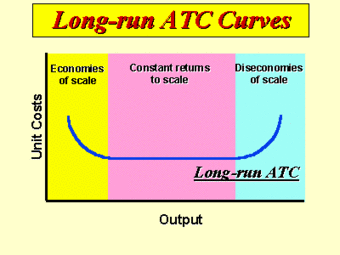
Long Run ATC Curves
This graph shows that as the output (production) increases, long run average total cost curve decreases in economies of scale, constant in constant returns to scale, and increases in diseconomies of scale.
Increasing Returns to Scale
The first stage, increasing returns to scale (IRS) refers to a production process where an increase in the number of units produced causes a decrease in the average cost of each unit. In other words, a firm is experiencing IRS when the cost of producing an additional unit of output decreases as the volume of its production increases. IRS may take place, for example, if the cost of production of a manufactured good would decrease with the increase in quantity produced due to the production materials being obtained at a cheaper price.
Constant Return to Scale
The second stage, constant returns to scale (CRS) refers to a production process where an increase in the number of units produced causes no change in the average cost of each unit. If output changes proportionally with all the inputs, then there are constant returns to scale.
Diminishing Return to Scale
The final stage, diminishing returns to scale (DRS) refers to production for which the average costs of output increase as the level of production increases. The DRS is the opposite of the IRS. DRS might occur if, for example, a furniture company was forced to import wood from further and further away as its operations increased.
9.2.5: Economic Costs
The economic cost is based on the cost of the alternative chosen and the benefit that the best alternative would have provided if chosen.
Learning Objective
Break down the components of a firm’s economic costs
Key Points
- Economic cost takes into account costs attributed to the alternative chosen and costs specific to the forgone opportunity.
- Components of economic cost include total cost, variable cost, fixed cost, average cost, and marginal cost.
- Cost curves – a graph of the costs of production as a function of total quantity produced. In a free market economy, firms use cost curves to find the optimal point of production (to minimize cost). Maximizing firms use the curves to decide output quantities to achieve production goals.
- Average cost (AC) – total costs divided by output (AC = TFC/q + TVC/q).
- Marginal cost (MC) – the change in the total cost when the quantity produced changes by one unit.
- Cost curves – a graph of the costs of production as a function of total quantity produced. In a free market economy, firms use cost curves to find the optimal point of production (to minimize cost). Maximizing firms use the curves to decide output quantities to achieve production goals.
Key Terms
- economic cost
-
The accounting cost plus opportunity cost.
- cost
-
A negative consequence or loss that occurs or is required to occur.
- Opportunity cost
-
The cost of any activity measured in terms of the value of the next best alternative forgone (that is not chosen).
Example
- An example of economic cost would be the cost of attending college. The accounting cost includes all charges such as tuition, books, food, housing, and other expenditures. The opportunity cost includes the salary or wage the individual could be earning if he was employed during his college years instead of being in school. So, the economic cost of college is the accounting cost plus the opportunity cost.
Economic Cost
Throughout the production of a good or service, a firm must make decisions based on economic cost. The economic cost of a decision is based on both the cost of the alternative chosen and the benefit that the best alternative would have provided if chosen. Economic cost includes opportunity cost when analyzing economic decisions.
An example of economic cost would be the cost of attending college. The accounting cost includes all charges such as tuition, books, food, housing, and other expenditures. The opportunity cost includes the salary or wage the individual could be earning if he was employed during his college years instead of being in school. So, the economic cost of college is the accounting cost plus the opportunity cost.
Components of Economic Costs
Economic cost takes into account costs attributed to the alternative chosen and costs specific to the forgone opportunity. Before making economic decisions, there are a series of components of economic costs that a firm will take into consideration. These components include:
- Total cost (TC): total cost equals total fixed cost plus total variable costs (TC = TFC + TVC) .
- Variable cost (VC): the cost paid to the variable input. Inputs include labor, capital, materials, power, land, and buildings. Variable input is traditionally assumed to be labor.
- Total variable cost (TVC): same as variable costs.
- Fixed cost (FC): the costs of the fixed assets (those that do not vary with production).
- Total fixed cost (TFC): same as fixed cost.
- Average cost (AC): total costs divided by output (AC = TFC/q + TVC/q).
- Average fixed cost (AFC): the fixed costs divided by output (AFC = TFC/q). The average fixed cost function continuously declines as production increases.
- Average variable cost (AVC): variable costs divided by output (AVC = TVC/q). The average variable cost curve is normally U-shaped. It lies below the average cost curve, starting to the right of the y axis.
- Marginal cost (MC): the change in the total cost when the quantity produced changes by one unit.
- Cost curves: a graph of the costs of production as a function of total quantity produced. In a free market economy, firms use cost curves to find the optimal point of production (to minimize cost). Maximizing firms use the curves to decide output quantities to achieve production goals.
9.3: Economic Profit
9.3.1: Difference Between Economic and Accounting Profit
Economic profit consists of revenue minus implicit (opportunity) and explicit (monetary) costs; accounting profit consists of revenue minus explicit costs.
Learning Objective
Distinguish between economic profit and accounting profit
Key Points
- Explicit costs are monetary costs a firm has. Implicit costs are the opportunity costs of a firm’s resources.
- Accounting profit is the monetary costs a firm pays out and the revenue a firm receives. It is the bookkeeping profit, and it is higher than economic profit. Accounting profit = total monetary revenue- total costs.
- Economic profit is the monetary costs and opportunity costs a firm pays and the revenue a firm receives. Economic profit = total revenue – (explicit costs + implicit costs).
Key Terms
- explicit cost
-
A direct payment made to others in the course of running a business, such as wages, rent, and materials, as opposed to implicit costs, which are those where no actual payment is made.
- implicit cost
-
The opportunity cost equal to what a firm must give up in order to use factors which it neither purchases nor hires.
- economic profit
-
The difference between the total revenue received by the firm from its sales and the total opportunity costs of all the resources used by the firm.
- accounting profit
-
The total revenue minus costs, properly chargeable against goods sold.
Example
- Consider a simplified example of a firm. In one year, it cost $60,000 to maintain production, but earned $100,000 in revenue. The accounting profit would be $40,000 ($100,000 in revenue – $60,000 in explicit costs). However, if the firm could have made $50,000 by renting its land and capital, its economic profit would be a loss of $10,000 ($100,000 in revenue – $60,000 in explicit costs – $50,000 in opportunity costs).
The term “profit” may bring images of money to mind, but to economists, profit encompasses more than just cash. In general, profit is the difference between costs and revenue, but there is a difference between accounting profit and economic profit. The biggest difference between accounting and economic profit is that economic profit reflects explicit and implicit costs, while accounting profit considers only explicit costs.
Explicit and Implicit Costs
Explicit costs are costs that involve direct monetary payment. Wages paid to workers, rent paid to a landowner, and material costs paid to a supplier are all examples of explicit costs.
In contrast, implicit costs are the opportunity costs of factors of production that a producer already owns. The implicit cost is what the firm must give up in order to use its resources; in other words, an implicit cost is any cost that results from using an asset instead of renting, selling, or lending it. For example, a paper production firm may own a grove of trees. The implicit cost of that natural resource is the potential market price the firm could receive if it sold it as lumber instead of using it for paper production.
Accounting Profit
Accounting profit is the difference between total monetary revenue and total monetary costs, and is computed by using generally accepted accounting principles (GAAP). Put another way, accounting profit is the same as bookkeeping costs and consists of credits and debits on a firm’s balance sheet. These consist of the explicit costs a firm has to maintain production (for example, wages, rent, and material costs). The monetary revenue is what a firm receives after selling its product in the market.
Accounting profit is also limited in its time scope; generally, accounting profit only considers the costs and revenue of a single period of time, such as a fiscal quarter or year.
Economic Profit
Economic profit is the difference between total monetary revenue and total costs, but total costs include both explicit and implicit costs. Economic profit includes the opportunity costs associated with production and is therefore lower than accounting profit. Economic profit also accounts for a longer span of time than accounting profit. Economists often consider long-term economic profit to decide if a firm should enter or exit a market.
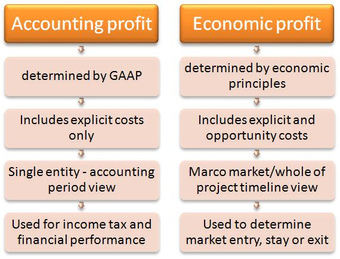
Economic vs. Accounting Profit
The biggest difference between economic and accounting profit is that economic profit takes implicit, or opportunity, costs into consideration.
9.3.2: Sources and Determinants of Profit
Whether economic profit exists or not depends how competitive the market is, and the time horizon that is being considered.
Learning Objective
Describe sources of economic profit
Key Points
- Economic profit = total revenue – (explicit costs + implicit costs). Accounting profit = total revenue – explicit costs.
- Economic profit can be positive, negative, or zero. If economic profit is positive, there is incentive for firms to enter the market. If profit is negative, there is incentive for firms to exit the market. If profit is zero, there is no incentive to enter or exit.
- For a competitive market, economic profit can be positive in the short run. In the long run, economic profit must be zero, which is also known as normal profit. Economic profit is zero in the long run because of the entry of new firms, which drives down the market price.
- For an uncompetitive market, economic profit can be positive. Uncompetitive markets can earn positive profits due to barriers to entry, market power of the firms, and a general lack of competition.
Key Term
- normal profit
-
The opportunity cost of an entrepreneur to operate a firm; the next best amount the entrepreneur could earn doing another job.
Example
- Consider a shoe production firm that is in a competitive market. In one year, the firm earns a total revenue of $50,000, while spending $15,000 on production (explicit costs) and having $10,000 in foregone wages, rent, and interest (opportunity costs). Consequently, the firm earns $25,000 in economic profit. Attracted by the potential to earn profit, other firms enter the market. Eventually, the firm’s revenue will fall as market price decreases, until the total revenue just covers production costs and opportunity costs, and economic profit equals zero.
Economic profit is total revenue minus explicit and implicit (opportunity) costs. In contrast, accounting profit is the difference between total revenue and explicit costs- it does not take opportunity costs into consideration, and is generally higher than economic profit.
Economic profits may be positive, zero, or negative. If economic profit is positive, other firms have an incentive to enter the market. If profit is zero, other firms have no incentive to enter or exit. When economic profit is zero, a firm is earning the same as it would if its resources were employed in the next best alternative. If the economic profit is negative, firms have the incentive to leave the market because their resources would be more profitable elsewhere. The amount of economic profit a firm earns is largely dependent on the degree of market competition and the time span under consideration.
Competitive Markets
In competitive markets, where there are many firms and no single firm can affect the price of a good or service, economic profit can differ in the short-run and in the long-run.
In the short run, a firm can make an economic profit. However, if there is economic profit, other firms will want to enter the market. If the market has no barriers to entry, new firms will enter, increase the supply of the commodity, and decrease the price. This decrease in price leads to a decrease in the firm’s revenue, so in the long-run, economic profit is zero . An economic profit of zero is also known as a normal profit. Despite earning an economic profit of zero, the firm may still be earning a positive accounting profit.

Long-Run Profit for Perfect Competition
In the long run for a firm in a competitive market, there is zero economic profit. Graphically, this is seen at the intersection of the price level with the minimum point of the average total cost (ATC) curve. If the price level were set above ATC’s minimum point, there would be positive economic profit; if the price level were set below ATC’s minimum, there would be negative economic profit.
Uncompetitive Markets
Unlike competitive markets, uncompetitive markets – characterized by firms with market power or barriers to entry – can make positive economic profits. The reasons for the positive economic profit are barriers to entry, market power, and a lack of competition.
- Barriers to entry prevent new firms from easily entering the market, and sapping short-run economic profits.
- Market power, or the ability to affect market prices, allows firms to set a price that is higher than the equilibrium price of a competitive market. This allows them to make profits in the short run and in the long run. This situation can occur if the market is dominated by a monopoly (a single firm), oligopoly (a few firms with significant market control), or monopolistic competition (firms have market power due to having differentiated products). .
- Lack of competition keeps prices higher than the competitive market equilibrium price. For example, firms can collude and work together to restrict supply to artificially keep prices high.

Long-Run Profit for Monopoly
In the long run, a monopoly, because of its market power, can set a price above the competitive equilibrium and earn economic profit. If price were set equal to the minimum point of the average total cost (ATC) curve, the monopoly would earn zero economic profit. If the price were set lower than the minimum of ATC, the firm would earn negative economic profit.
Chapter 8: Market Failure: Public Goods and Common Resources
8.1: Public Goods
8.1.1: Defining a Good
There are four types of goods in economics, which are defined based on excludability and rivalrousness in consumption.
Learning Objective
Define a good
Key Points
- Private goods are excludable and rival. Examples of private goods include food and clothes.
- Common goods are non-excludable and rival. A classic example is fish stocks in international waters.
- Club goods are excludable but non-rival. Cable television is an example.
- Public goods are non-excludable and non-rival. They include public parks and the air we breathe.
Key Terms
- Rival
-
A good whose consumption by one consumer prevents simultaneous consumption by other consumers
- Excludable
-
A good for which it is possible to prevent consumers who have not paid for it from having access to it.
There are four categories of goods in economics, which are defined based on two attributes. The first attribute is excludability, or whether people can be prevented from using the good. The second is whether a good is rival in consumption: whether one person’s use of the good reduces another person’s ability to use it.
National defense provides an example of a good that is non-excludable. America’s national defense establishment offers protection to everyone in the country. Items on sale in a store, on the other hand, are excludable. The store owner can prevent a customer from obtaining a good unless the customer pays for it. National defense also provides an example of a good that is non-rivalrous. One person’s protection does not prevent another person from receiving protection. In contrast, shoes are rivalrous. Only one person can wear a pair of shoes at a time.
Combinations of these two attributes create four categories of goods :
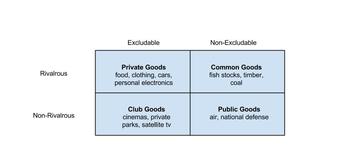
Four Types of Goods
There are four categories of goods in economics, based on whether the goods are excludable and/or rivalrous in consumption.
- Private goods: Private goods are excludable and rival. Examples of private goods include food, clothes, and flowers. There are usually limited quantities of these goods, and owners or sellers can prevent other individuals from enjoying their benefits. Because of their relative scarcity, many private goods are exchanged for payment.
- Common goods: Common goods are non-excludable and rival. Because of these traits, common goods are easily over-consumed, leading to a phenomenon called “tragedy of the commons. ” In this situation, people withdraw resources to secure short-term gains without regard for the long-term consequences. A classic example of a common good are fish stocks in international waters. No one is excluded from fishing, but as people withdraw fish without limits being imposed, the stocks for later fishermen are depleted.
- Club goods: Club goods are excludable but non-rival. This type of good often requires a “membership” payment in order to enjoy the benefits of the goods. Non-payers can be prevented from access to the goods. Cable television is a classic example. It requires a monthly fee, but is non-rival after the payment.
- Public goods: Public goods are non-excludable and non-rival. Individuals cannot be effectively excluded from using them, and use by one individual does not reduce the good’s availability to others. Examples of public goods include the air we breathe, public parks, and street lights. Public goods may give rise to the “free rider problem. ” A free-rider is a person who receives the benefit of a good without paying for it. This may lead to the under-provision of certain goods or services.
8.1.2: Private Goods
A private good is both excludable and rivalrous.
Learning Objective
Define a private good
Key Points
- The owners or sellers of private goods exercise private property rights over them.
- A consumer generally has to pay for a private good.
- Generally, the market will efficiently allocate resources for the production of private goods.
Key Terms
- Excludable
-
A good for which it is possible to prevent consumers who have not paid for it from having access to it.
- Rivalrous
-
A good whose consumption by one consumer prevents simultaneous consumption by other consumers.
In economics, a private good is defined as an asset that is both excludable and rivalrous. It is excludable in that it is possible to exercise private property rights over it, preventing those who have not paid from using the good or consuming its benefits. For example, person A may have the means and will to pay $20 for a t-shirt. Person B may not wish to pay $20 or may not be able to do so. Person B would not be able to purchase the t-shirt. Additionally, the private good is rivalrous in that its consumption by one person necessarily prevents consumption by another. When person A purchases and drinks a bottle of water, the same bottle of water is not available for person B to purchase and consume.
A private good is a scare economic resource, which causes competition for it. Generally, people have to pay to enjoy the benefits of a private good. Because people have to pay to obtain it, private goods are much less likely to encounter a free-rider problem than public goods. Thus, generally, the market will efficiently allocate resources to produce private goods.
In daily life, examples of private goods abound, including food, clothing, and most other goods that can be purchased in a store. Take an example of an ice cream cone . It is both excludable and rivalrous. It is possible to prevent someone from consuming the ice cream by simply refusing to sell it to them. Additionally, it can be consumed only once, so its consumption by one individual would definitely reduce others’ ability to consume it.

Ice Cream Cone
An ice cream cone is an example of a private good. It is excludable and rival.
8.1.3: Public Goods
Individuals cannot be excluded from using a public good, and one individual’s use of it does not limit its availability to others.
Learning Objective
Define a public good
Key Points
- A public good is both non-excludable and non-rivalrous.
- Pure public goods are perfectly non-rival in consumption and non-excludable. Impure public goods satisfy those conditions to some extent, but not perfectly.
- Public goods provide an example of market failure. Because of the free-rider problem, they may be underpoduced.
Key Terms
- free rider
-
Someone who enjoys the benefits of a good without paying for it
- Non-excludable
-
Non-paying consumers cannot be prevented from accessing a good
- Non-rivalrous
-
A good whose consumption by one consumer does not prevent simultaneous consumption by other consumers
A public good is a good that is both non-excludable and non-rivalrous. This means that individuals cannot be effectively excluded from its use, and use by one individual does not reduce its availability to others. Examples of public goods include fresh air, knowledge, lighthouses, national defense, flood control systems, and street lighting .

Streetlight
A streetlight is an example of a public good. It is non-excludable and non-rival in consumption.
Public goods can be pure or impure. Pure public goods are those that are perfectly non-rivalrous in consumption and non-excludable. Impure public goods are those that satisfy the two conditions to some extent, but not fully.
The production of public goods results in positive externalities for which producers don’t receive full payment. Consumers can take advantage of public goods without paying for them. This is called the “free-rider problem. ” If too many consumers decide to “free-ride,” private costs to producers will exceed private benefits, and the incentive to provide the good or service through the market will disappear. The market will thus fail to provide enough of the good or service for which there is a need.
For example, a local public radio station relies on support from listeners to operate. The station holds pledge drives several times a year, asking listeners to make contributions or face possible reduction in programming. Yet only a small percentage of the audience makes contributions. Some audience members may even listen to the station for years without ever making a payment. Those listeners who do not make a contribution are “free-riders. ” If the station relies solely on funds contributed by listeners, it would under-produce programming. It must obtain additional funding from other sources (such as the government) in order to continue to operate.
8.1.4: Optimal Quantity of a Public Good
The government is providing an efficient quantity of a public good when its marginal benefit equals its marginal cost.
Learning Objective
Explain the optimal quantity of a public good
Key Points
- Collective demand for a public good is the vertical summation of individual demand curves. It shows the price society is willing to pay for a given quantity of a public good.
- The demand curve for a public good is downward sloping, due to the law of diminishing marginal utility. The supply curve is upward sloping, due to the law of diminishing returns.
- The optimal quantity of a public good occurs where the demand (marginal benefit) curve intersects the supply (marginal cost) curve.
- The government uses cost-benefit analysis to decide whether to provide a particular good. If MB is greater than MC there is an underallocation of a public good. If MC is greater than MB there is an overallocation of a public good. When MC = MB then there is an optimal allocation of public goods.
Key Term
- Cost-benefit analysis
-
A systematic process for calculating and comparing the marginal benefits and marginal costs of a project or activity.
To determine the optimal quantity of a public good, it is necessary to first determine the demand for it. Demand for public goods is represented through price-quantity schedules, which show the price someone is willing to pay for the extra unit of each possible quantity. Unlike the market demand curve for private goods, where individual demand curves are summed horizontally, individual demand curves for public goods are summed vertically to get the market demand curve. As a result, the market demand curve for public goods gives the price society is willing to pay for a given quantity. It is equal to the marginal benefit curve. Due to the law of diminishing marginal utility, the demand curve is downward sloping.
Often, the government supplies the public good. The supply curve for a public good is equal to its marginal cost curve. Because of the law of diminishing returns, the marginal cost increases as the quantity of the good produced increases. The supply curve therefore has an upward slope.
As already noted, the demand curve is equal to the marginal benefit curve, while the supply curve is equal to the marginal cost curve. The optimal quantity of the public good occurs where MB (society’s marginal benefit) equals MC (provider’s marginal cost), or where the two curves intersect . When MB = MC, resources have been allocated efficiently.
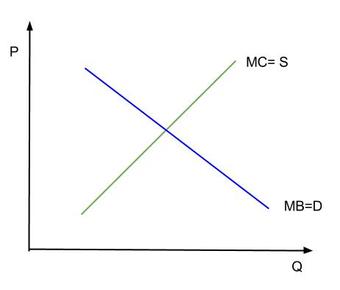
Optimal Quantity of a Public Good
The optimal quantity of public good occurs where MB = MC.
The public good provider uses cost-benefit analysis to decide whether to provide a particular good by comparing marginal costs and marginal benefits. Cost-benefit analysis can also help the provider decide the extent to which a project should be pursued. Output activity should be increased as long as the marginal benefit exceeds the marginal cost. An activity should not be pursued when the marginal benefit is less than the marginal cost. An activity should be stopped at the point where MB equals MC. This is the MC=MB rule, by which the provider of the public good can determine which plan, will give society maximum net benefit.
8.1.5: Demand for Public Goods
The aggregate demand curve for a public good is the vertical summation of individual demand curves.
Learning Objective
Analyze the demand for a public good.
Key Points
- For public goods, aggregate demand is the sum of marginal benefits to each person at each quantity of the good provided.
- As for private goods, the individual demand curves show the price someone is willing to pay for an extra unit of each possible quantity of a good.
- The efficient quantity of a public good is the quantity at which marginal benefit equals marginal cost.
- The efficient quantity of a public good is the quantity at which marginal benefit equals marginal cost.
Key Term
- public good
-
A good that is non-rivalrous and non-excludable.
The aggregate demand for a public good is derived differently from the aggregate demand for private goods.
To an individual consumer, the total benefit of a public good is the dollar value that he or she places on a given level of provision of the good. The marginal benefit for an individual is the increase in the total benefit that results from a one-unit increase in the quantity provided. The marginal benefit of a public good diminishes as the level of the good provided increases.
Public goods are non-rivalrous, so everyone can consume each unit of a public good. They also have a fixed market quantity: everyone in society must agree on consuming the same amount of the good. However, each individual’s willingness to pay for the quantity provided may be different. The individual demand curves show the price someone is willing to pay for an extra unit of each possible quantity of the public good.
The aggregate demand for a public good is the sum of marginal benefits to each person at each quantity of the good provided . The economy’s marginal benefit curve (demand curve) for a public good is thus the vertical sum all individual’s marginal benefit curves. The vertical summation of individual demand curves for public goods also gives the aggregate willingness to pay for a given quantity of the good.
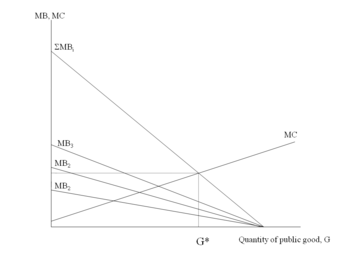
Demand for a Public Good
The sum of the individual marginal benefit curves (MB) represent the aggregate willingness to pay or aggregate demand (∑MB). The intersection of the aggregate demand and the marginal cost curve (MC) determines the amount of the good provided.
This is in contrast to the aggregate demand curve for a private good, which is the horizontal sum of the individual demand curves at each price. Unlike public goods, society does not have to agree on a given quantity of a private good, and any one person can consume more of the private good than another at a given price.
The efficient quantity of a public good is the quantity that maximizes net benefit (total benefit minus total cost), which is the same as the quantity at which marginal benefit equals marginal cost.
8.1.6: Cost-Benefit Analysis
The government uses cost-benefit analysis to decide whether to provide a public good.
Learning Objective
Explain how to determine the net cost/benefit of providing a public good
Key Points
- Cost-benefit analysis is a systematic way of calculating the costs and benefits of a project to society as a whole.
- Benefits and costs are expressed in monetary terms and are adjusted for the time-value of money.
- Financial costs are much easier to capture in the analysis than non-financial welfare impacts, such as impacts on human life or the environment.
- The government should provide a public good if the benefits to society outweigh the costs.
Key Term
- net present value
-
The present value of a project determined by summing the discounted incoming and outgoing future cash flows resulting from the decision.
The government uses cost-benefit analysis to decide whether to provide a particular public good and how much of it to provide. Cost-benefit analysis, which is also sometimes called benefit-cost analysis, is a systematic process for calculating the benefits and costs of a project to society as a whole.
The positive and negative effects captured by cost-benefit analysis may include effects on consumers, effects on non-consumers, externality effects, or other social benefits or costs. The guiding principle is to list all parties affected by a project and add a negative or positive value that they ascribe to the project’s effect on their welfare. Benefits and costs are expressed in monetary terms, and are adjusted for the time value of money, so that all flows of benefits and costs over time are expressed on a common basis in terms of their net present value. Financial costs tend to be most thoroughly represented in cost-benefit analyses due to relatively abundant market data. It is much more difficult to capture non-financial welfare impacts. For example, it is very difficult to place a dollar value on human life, consumers’ time, or environmental impact.
Imagine that the government is considering a project to widen a highway . The benefits side of the analysis might include time savings for passengers who can now avoid traffic, an increase in the number of passenger trips (as more people could now use the road), and lives saved by dint of fewer car accidents. The cost side of the analysis would include the cost of land that must be acquired prior to construction, construction, and maintenance. These costs and benefits will need to be translated into monetary terms for the sake of analysis.
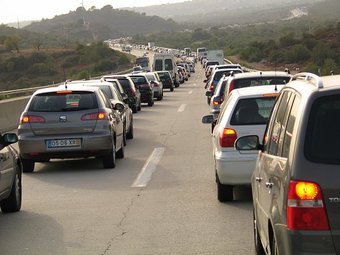
The Highway as a Public Good
The benefits of a highway expansion project might include time savings for passengers, additional passenger trips, and saved lives. Costs might include construction and maintenance.
The procedure for conducting cost-benefit analysis is as follows:
- Identify project(s) to be analyzed.
- Estimate all costs and benefits to society associated with the project(s) over a relevant time horizon.
- Assign a monetary value to all costs and benefits.
- Calculate the net benefit of the project (total benefit minus total cost).
- Adjust for inflation and apply the discount rate to calculate present value of the project.
- Calculate the net present value for the project(s).
- Make recommendation about project(s). If the benefit outweighs the cost, then the government should proceed with the project.
8.2: Common Resources
8.2.1: The Tragedy of the Commons
The tragedy of the commons is the overexploitation of a common good by individual, rational actors.
Learning Objective
Describe the tragedy of the commons
Key Points
- Common goods are non-excludable and rivalrous.
- When individuals act independently and rationally, they may collectively trade long-term benefit for short-term gain.
- Enlightened self-interest and government intervention are two ways that the tragedy of the commons may be avoided.
Key Terms
- Common good
-
Goods which are rivalrous and non-excludable.
- Enlightened Self-Interest
-
The ability for individuals to realize when their actions, collectively, will trade long-term benefit for short-term gain.
Example
- The population of tuna may be depleted if fishermen are allowed to catch as much as they want. To make more profit, fishermen must catch more fish, which leads to overfishing. To prevent the tragedy of the commons, governments may implement market-based solutions.
Common Goods
Common goods are goods that are rivalrous and non-excludable. This means that anyone has access to the good, but that the use of the good by one person reduces the ability of someone else to use it. A classic example of a common good are fish stocks in international waters; no one is excluded from fishing, but as people withdraw fish without limits being imposed, the stocks for later fishermen are potentially depleted.
Tragedy of Commons
The tragedy of the commons is the depletion of a common good by individuals who are acting independently and rationally according to each one’s self-interest. Consider, the example of fish in international waters. Each individual fisherman, acting independently, will rationally choose to catch some of the fish to sell. This makes sense: there is a resource that the fisherman is able to use to generate a profit. However, when a lot of fishermen, all thinking this way, catch the fish, the total stock of fish may be depleted. When the stock of fish is depleted, none of the fishermen are able to continue fishing, even though, in the long run, each fisherman would have preferred that the fish not be depleted. The tragedy of the commons describes such situations in which people withdraw resources to secure short-term gains without regard for the long-term consequences.
Not all common goods, however, suffer from the tragedy of the commons. If individuals have enlightened self-interest, they will realize the negative long-term effects of their short-term decisions. This would be the same as the fishermen realizing that they should limit their fishing to preserve the stock of fish in the long-term.
In the absence of enlightened self-interest, the government may step in and impose regulations or taxes to discourage the behavior that leads to the tragedy of the commons. This would be like the government imposing limits on the amount of fish that can be caught.

Bluefin Tuna Caught in Net
Fish populations are at risk of becoming fully extinct due to overfishing. The Food and Agriculture Association estimated 70% of the world’s fish species are either fully exploited or depleted.
8.2.2: The Free-Rider Problem
The free-rider problem is when individuals benefit from a public good without paying their share of the cost.
Learning Objective
Describe the Free-Rider Problem
Key Points
- Public goods are non-excludable, but have a cost, so those who don’t pay their share of the cost can still easily benefit from the good.
- Free-riders have an incentive to free ride because they can benefit from a good at a reduced personal cost.
- The providers of public goods often create enforcement mechanisms to mitigate the free-rider problem.
Key Term
- public good
-
A good that is non-rivalrous and non-excludable.
It is easy to think about public goods as free. In your everyday life, you benefit from public goods such as roads and bridges even though no transaction occurs when you use them. However, even public goods need to be paid for. In the case of roads and bridges, everyone pays taxes to the government, who then uses the taxes to pay for public goods .
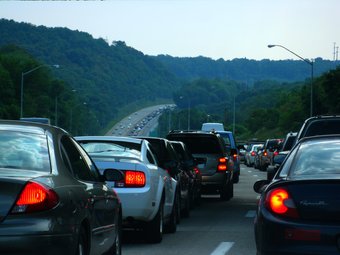
Roads
Free riders are able to use roads without paying their taxes because roads are a non-excludable public good.
Public goods, as you may recall, are both non-rivalrous and non-excludable. It is the second trait- the non-excludability- that leads to what is called the free-rider problem. The free-rider problem is that some people may benefit from a public good without paying their share of the cost.
Since public goods are non-excludable, free-riders not only can’t be prevented from using the good, but actually have an incentive to continue to free-ride. If they will be able to use the public good whether they pay their share of the costs, they might as well not pay.
Take the military, for example. National security is a public good: it is both non-rivalrous and non-excludable. In order to have such a public good, everyone pays taxes which are then used by the government to finance the military. However, there are undoubtedly people who have not paid their taxes. These people, without having paid their share of the cost of having a military, still benefit from the protection the military provides. They are free-riders.
Of course, there are commonly regulations that attempt to discourage free-riding. For government-provided public goods, the government makes sure that everyone pays their share of the costs by enforcing tax laws. The threat of fines or jail time are enough of a threat that most people find it more appealing (in the US, at least) to pay their share of public goods via taxes than to free-ride.
Chapter 7: Market Failure: Externalities
7.1: Introducing Market Failure
7.1.1: Defining Market Failure
Market failure occurs when the price mechanism fails to account for all of the costs and benefits necessary to provide and consume a good.
Learning Objective
Identify common market failures and governmental responses
Key Points
- Prior to market failure, the supply and demand within the market do not produce quantities of the goods where the price reflects the marginal benefit of consumption.
- The structure of market systems contributes to market failure. In the real world, it is not possible for markets to be perfect due to inefficient producers, externalities, environmental concerns, and lack of public goods.
- Government responses to market failure include legislation, direct provision of merit goods and public goods, taxation, subsidies, tradable permits, extension of property rights, advertising, and international cooperation among governments.
Key Terms
- merit good
-
A commodity which is judged that an individual or society should have on the basis of some concept of need, rather than ability and willingness to pay.
- public good
-
A good that is both non-excludable and non-rivalrous in that individuals cannot be effectively excluded from use and where use by one individual does not reduce availability to others.
- externality
-
An impact, positive or negative, on any party not involved in a given economic transaction or act.
Market failure occurs when the price mechanism fails to account for all of the costs and benefits necessary to provide and consume a good. The market will fail by not supplying the socially optimal amount of the good.
Prior to market failure, the supply and demand within the market do not produce quantities of the goods where the price reflects the marginal benefit of consumption. The imbalance causes allocative inefficiency, which is the over- or under-consumption of the good.
The structure of market systems contributes to market failure. In the real world, it is not possible for markets to be perfect due to inefficient producers, externalities, environmental concerns, and lack of public goods. An externality is an effect on a third party which is caused by the production or consumption of a good or service .
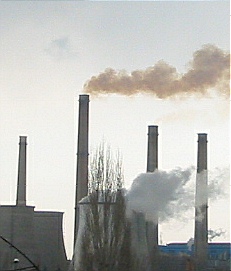
Air pollution
Air pollution is an example of a negative externality. Governments may enact tradable permits to try and reduce industrial pollution.
During market failures the government usually responds to varying degrees. Possible government responses include:
- legislation – enacting specific laws. For example, banning smoking in restaurants, or making high school attendance mandatory.
- direct provision of merit and public goods – governments control the supply of goods that have positive externalities. For example, by supplying high amounts of education, parks, or libraries.
- taxation – placing taxes on certain goods to discourage use and internalize external costs. For example, placing a ‘sin-tax’ on tobacco products, and subsequently increasing the cost of tobacco consumption.
- subsidies – reducing the price of a good based on the public benefit that is gained. For example, lowering college tuition because society benefits from more educated workers. Subsidies are most appropriate to encourage behavior that has positive externalities.
- tradable permits – permits that allow firms to produce a certain amount of something, commonly pollution. Firms can trade permits with other firms to increase or decrease what they can produce. This is the basis behind cap-and-trade, an attempt to reduce of pollution.
- extension of property rights – creates privatization for certain non-private goods like lakes, rivers, and beaches to create a market for pollution. Then, individuals get fined for polluting certain areas.
- advertising – encourages or discourages consumption.
- international cooperation among governments – governments work together on issues that affect the future of the environment.
7.1.2: Causes of Market Failure
Market failure occurs due to inefficiency in the allocation of goods and services.
Learning Objective
Explain some common causes of market failure
Key Points
- A price mechanism fails to account for all of the costs and benefits involved when providing or consuming a specific good. When this happens, the market will not produce the supply of the good that is socially optimal – it will be over or under produced.
- Due to the structure of markets, it may be impossible for them to be perfect.
- Reasons for market failure include: positive and negative externalities, environmental concerns, lack of public goods, underprovision of merit goods, overprovision of demerit goods, and abuse of monopoly power.
Key Terms
- free rider
-
One who obtains benefit from a public good without paying for it directly.
- public good
-
A good that is both non-excludable and non-rivalrous in that individuals cannot be effectively excluded from use and where use by one individual does not reduce availability to others.
- monopoly
-
A market where one company is the sole supplier.
Market failure occurs due to inefficiency in the allocation of goods and services. A price mechanism fails to account for all of the costs and benefits involved when providing or consuming a specific good. When this happens, the market will not produce the supply of the good that is socially optimal – it will be over or under produced.
In order to fully understand market failure, it is important to recognize the reasons why a market can fail. Due to the structure of markets, it is impossible for them to be perfect. As a result, most markets are not successful and require forms of intervention.
Reasons for market failure include:
- Positive and negative externalities: an externality is an effect on a third party that is caused by the consumption or production of a good or service . A positive externality is a positive spillover that results from the consumption or production of a good or service. For example, although public education may only directly affect students and schools, an educated population may provide positive effects on society as a whole. A negative externality is a negative spillover effect on third parties. For example, secondhand smoke may negatively impact the health of people, even if they do not directly engage in smoking.
- Environmental concerns: effects on the environment as important considerations as well as sustainable development.
- Lack of public goods: public goods are goods where the total cost of production does not increase with the number of consumers. As an example of a public good, a lighthouse has a fixed cost of production that is the same, whether one ship or one hundred ships use its light. Public goods can be underproduced; there is little incentive, from a private standpoint, to provide a lighthouse because one can wait for someone else to provide it, and then use its light without incurring a cost. This problem – someone benefiting from resources or goods and services without paying for the cost of the benefit – is known as the free rider problem.
- Underproduction of merit goods: a merit good is a private good that society believes is under consumed, often with positive externalities. For example, education, healthcare, and sports centers are considered merit goods.
- Overprovision of demerit goods: a demerit good is a private good that society believes is over consumed, often with negative externalities. For example, cigarettes, alcohol, and prostitution are considered demerit goods.
- Abuse of monopoly power: imperfect markets restrict output in an attempt to maximize profit.
When a market fails, the government usually intervenes depending on the reason for the failure.
7.1.3: Introducing Externalities
An externality is a cost or benefit that affects an otherwise uninvolved party who did not choose to be subject to the cost or benefit.
Learning Objective
Give examples of externalities that exist in different parts of socity
Key Points
- In regards to externalities, the cost and benefit to society is the sum of the benefits and costs for all parties involved.
- Market failure occurs when the price mechanism fails to consider all of the costs and benefits necessary for providing and consuming a good.
- In regards to externalities, one way to correct the issue is to internalize the third party costs and benefits. However, in many cases, internalizing the costs is not feasible. When externalities exist, it is possible that the particular industry will experience market failure.
- In many cases, the government intervenes when there is market failure.
Key Terms
- externality
-
An impact, positive or negative, on any party not involved in a given economic transaction or act.
- intervene
-
To interpose; as, to intervene to settle a quarrel; get involved, so as to alter or hinder an action.
In economics, an externality is a cost or benefit resulting from an activity or transaction, that affects an otherwise uninvolved party who did not choose to be subject to the cost or benefit . An example of an externality is pollution. Health and clean-up costs from pollution impact all of society, not just individuals within the manufacturing industries. In regards to externalities, the cost and benefit to society is the sum of the value of the benefits and costs for all parties involved.

Externality
An externality is a cost or benefit that results from an activity or transaction and that affects an otherwise uninvolved party who did not choose to incur that cost or benefit.
Negative vs. Positive
A negative externality is an result of a product that inflicts a negative effect on a third party . In contrast, positive externality is an action of a product that provides a positive effect on a third party.
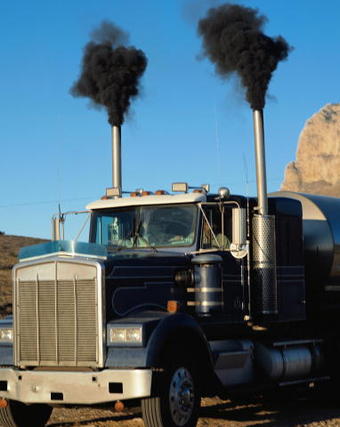
Negative Externality
Air pollution caused by motor vehicles is an example of a negative externality.
Externalities originate within voluntary exchanges. Although the parties directly involved benefit from the exchange, third parties can experience additional effects. For those involuntarily impacted, the effects can be negative (pollution from a factory) or positive (domestic bees kept for honey production, pollinate the neighboring crops).
Economic Strain
Neoclassical welfare economics explains that under plausible conditions, externalities cause economic results that are not ideal for society. The third parties who experience external costs from a negative externality do so without consent, while the individuals who receive external benefits do not pay a cost. The existence of externalities can cause ethical and political problems within society.
In regards to externalities, one way to correct the issue is to internalize the third party costs and benefits. However, in many cases, internalizing the costs is not financially possible. Governments may step in to correct such market failures.
7.1.4: Externality Impacts on Efficiency
Economic efficiency is the use resources to maximize the production of goods; externalities are imperfections that limit efficiency.
Learning Objective
Analyze the effects of externalities on efficiency
Key Points
- An economically efficient society can produce more goods or services than another society without using more resources.
- An externality is a cost or benefit that results from an activity or transaction and affects a third party who did not choose to incur the cost or benefit. Externalities are either positive or negative depending on the nature of the impact on the third party.
- Neoclassical welfare economics states that the existence of externalities results in outcomes that are not ideal for society as a whole.
- In order to maximize economic efficiency, regulations are needed to reduce market failures and imperfections, like internalizing externalities. When market imperfections exist, the efficiency of the market declines.
- In order for economic efficiency to be achieved, one defining rule is that no one can be made better off without making someone else worse off. When externalities are present, not everyone benefits from the production of the good or service.
Key Terms
- efficient
-
Making good, thorough, or careful use of resources; not consuming extra. Especially, making good use of time or energy.
- externality
-
An impact, positive or negative, on any party not involved in a given economic transaction or act.
Economic Efficiency
In economics, the term “economic efficiency” is defined as the use of resources in order to maximize the production of goods and services. An economically efficient society can produce more goods or services than another society without using more resources.
A market is said to be economically efficient if:
- No one can be made better off without making someone else worse off.
- No additional output can be obtained without increasing the amounts of inputs.
- Production proceeds at the lowest possible cost per unit.
Externalities
An externality is a cost or benefit that results from an activity or transaction and affects a third party who did not choose to incur the cost or benefit . Externalities are either positive or negative depending on the nature of the impact on the third party. An example of a negative externality is pollution. Manufacturing plants emit pollution which impacts individuals living in the surrounding areas. Third parties who are not involved in any aspect of the manufacturing plant are impacted negatively by the pollution. An example of a positive externality would be an individual who lives by a bee farm. The third parties’ flowers are pollinated by the neighbor’s bees. They have no cost or investment in the business, but they benefit from the bees.

Externality
This diagram shows the voluntary exchange that takes place within a market system. It also shows the economic costs that are associated with externalities.
Externalities and Efficiency
Positive and negative externalities both impact economic efficiency. Neoclassical welfare economics states that the existence of externalities results in outcomes that are not ideal for society as a whole. In the case of negative externalities, third parties experience negative effects from an activity or transaction in which they did not choose to be involved. In order to compensate for negative externalities, the market as a whole is reducing its profits in order to repair the damage that was caused which decreases efficiency. Positive externalities are beneficial to the third party at no cost to them. The collective social welfare is improved, but the providers of the benefit do not make any money from the shared benefit. As a result, less of the good is produced or profited from which is less optimal society and decreases economic efficiency.
In order to deal with externalities, markets usually internalize the costs or benefits. For costs, the market has to spend additional funds in order to make up for damages incurred. Benefits are also internalized because they are viewed as goods produced and used by third parties with no monetary gain for the market. Internalizing costs and benefits is not always feasible, especially when the monetary value or a good or service cannot be determined.
Externalities directly impact efficiency because the production of goods is not efficient when costs are incurred due to damages. Efficiency also decreases when potential money earned is lost on non-paying third parties.
In order to maximize economic efficiency, regulations are needed to reduce market failures and imperfections, like internalizing externalities. When market imperfections exist, the efficiency of the market declines.
7.2: Externalities in Depth
7.2.1: Negative Externalities
Negative externalities are costs caused by an activity that affect an otherwise uninvolved party who did not choose to incur that cost.
Learning Objective
Describe the impact of a negative externality on society
Key Points
- The reason these negative externalities, otherwise known as social costs, occur is that these expenses are generally not included in calculating the costs of production.
- Government intervention is necessary to help “price” negative externalities. They do this through regulations or by instituting market-based policies such as taxes, subsidies, or permit systems.
- Graphically, social costs will be lower than private costs because they do not take into account the additional costs of negative externalities. As a result, firms may produce more units than is optimal from a societal standpoint.
- Graphically, social costs will be lower than private costs because they do not take into account the additional costs of negative externalities. As a result, firms may produce more units than is optimal from a societal standpoint.
Key Term
- externality
-
An impact, positive or negative, on any party not involved in a given economic transaction or act.
Example
- Smoking creates negative externalities because the secondhand smoke affects third parties that were otherwise not involved in the transaction.
A negative externality is a cost that results from an activity or transaction and that affects an otherwise uninvolved party who did not choose to incur that cost.
Reasons for Negative Externalities
The reason these negative externalities, otherwise known as social costs, occur is that these expenses are generally not included in calculating the costs of production. Production decisions are generally based on financial data and most social costs are not measured that way. For example, when a firm decides to open up a new factory, it will not account for the cost that residents accrue by drinking water from a river the factory polluted. As a result, a product that shouldn’t be produced, because the total expenses exceed the return, are made because social costs were not considered.
In other words, the costs of production represent individual, or private, marginal costs. The private marginal costs are lower than societal marginal costs, which also capture the true costs of the negative externalities. As a result, producers will overestimate the ideal quantity of the good to produce .

Negative Externality
Graphically, negative externalities occur when social costs are lower than private costs, and firms produce more units than is socially optimal. The ideal equilibrium quantity that reflects negative externalities is Qs, but firms may produce at Qp.
Government Solutions for Negative Externalities
In these cases, government intervention is necessary to help “price” negative externalities. Governments can either use regulation (e.g. outlaw an action) or use market solutions. By instituting policies such as pollution penalties, permitting civil lawsuits by private parties to recover damages for negligent actions, and levying environmental taxes, governments can achieve two things. First, these regulations recover funds to help fix the damage caused by negative externalities. Second, these acts help put a financial price on social costs. With that information, businesses can arrive at a more accurate figure for the costs of production. Businesses can then avoid producing products whose financial and social costs exceed the financial return.

Cigarette smoke
Secondhand smoke is an example of a negative externality; a person chooses to smoke, but others who do not choose to smoke are harmed.
7.2.2: Positive Externalities
Positive externalities are benefits caused by activities that affect an otherwise uninvolved party who did not choose to incur that benefit.
Learning Objective
Use an example to discuss the concept of a positive externality
Key Points
- Externalities occur all the time because economic events do not occur within a vacuum. Transactions often require the use of common resources that are shared with parties are not involved with the exchange. The use of these resources in turn impacts the uninvolved parties.
- The problem with positive externalities is that the people who create the externality cannot charge the beneficiaries; the beneficiaries can “free ride,” or benefit without paying.
- Free riding results in a suboptimal result, because the producers of the externality will generally create less of the benefit than the larger community needs.
Key Terms
- externality
-
An impact, positive or negative, on any party not involved in a given economic transaction or act.
- free rider
-
One who obtains benefit from a public good without paying for it directly.
Positive externalities are benefits caused by transactions that affect an otherwise uninvolved party who did not choose to incur that benefit. Externalities occur all the time because economic events do not occur within a vacuum. Transactions often require the use of common resources that are shared with parties are not involved with the exchange. The use of these resources, in turn, impacts the uninvolved parties.
In the case of positive externalities, a transaction has positive side effects for non-related parties. Let’s take a look at some example:
- A homeowner keeps his house maintained, the neighborhood benefits through higher home values. The homeowner’s neighbors benefit from a positive externality.
- A person may keep bees for her own enjoyment, but gardeners in the area benefit because their flowers are pollinated . The beekeeper’s transaction of purchasing bees ends up positively affecting parties who are not involved in the transaction.
- A person becomes inoculated against a disease, those around him benefit because they cannot catch the disease from him. There was an exchange between the doctor and the patient, but others also benefit.
In each of these cases, the people taking action are presumably not doing it for the sake of the community, but for their own purposes. The people taking the action may also enjoy the additional benefits described above, but initiators of actions are not considered beneficiaries of externalities.
The problem with positive externalities is that the people who create these advantages cannot charge the beneficiaries; the beneficiaries can “free ride,” or benefit without paying. For example, assume everyone in a community, except one person, got a flu shot. That one person could choose to abstain from receiving the shot; since everyone else got inoculated, he can’t get the disease from the others because they can’t catch the flu. That person would be a free rider since he would benefit from inoculations without incurring any cost.
Since parties that create the externality aren’t compensated, they do not have any incentive to create more. This results in a suboptimal result, because the producers of the externality will generally create less of the benefit than the larger community needs.
7.3: Government Policy Options
7.3.1: Regulation
The government can respond to externalities through command-and-control policies or market-based policies.
Learning Objective
Describe the role of government regulation in addressing externalities
Key Points
- Command-and-control regulation requires or forbids certain behaviors with the goal of addressing an externality.
- Regulation is difficult to implement and enforce correctly.
- Command-and-control regulation can come in the form of government-imposed standards, targets, process requirements, or outright bans.
- The allocation of tradable permits is a market-based policy that has been primarily used to combat pollution.
Key Term
- Negative Externality
-
A detremental effect suffered by a party due to a transaction it was not a part of.
The government can respond to externalities in two ways. The government can use command-and-control policies to regulate behavior directly. Alternatively, it can implement market-based policies such as taxes and subsidies to incentivize private decision makers to change their own behavior.
Command-and-control regulation can come in the form of government-imposed standards, targets, process requirements, or outright bans. Such measures make certain behaviors either required or forbidden with the goal of addressing the externality . For example, the government may make it illegal for a company to dump certain chemicals in a river. By doing so, the government hopes to protect the environment or other companies or individuals that use the river that would otherwise suffer a negative impact.
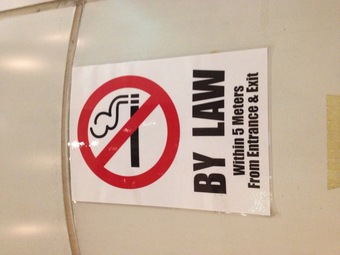
No Smoking
The prohibition of smoking in certain areas is a regulation designed to reduce the negative externalities suffered by non-smokers when they are around smokers.
In practice, implementing regulation effectively is difficult. It requires the regulator to have in-depth knowledge of a certain industry or sphere of economic activity. If done incorrectly, regulation can introduce inefficiency. For example, if the government makes it illegal to dump in the river, the companies and their customers may suffer because the products must be produced using less efficient methods. On the other hand, if the government allows too much to be dumped in the river, they have failed to mitigate the negative externality.
If the government is unsure of how to effectively regulate the market, it should seek other methods of mitigating the externality. Advocates of market-based policies for reducing negative externalities point to the difficulty of creating and enforcing effective regulation for reasons why the government should create systems of incentives and disincentives instead of using the force of regulation.
7.3.2: Tax
Corrective taxes incentivize economic actors to reduce the production of goods or services generating negative externalities.
Learning Objective
Describe the role of taxes in addressing externalities
Key Points
- A corrective tax is a market-based policy option used by the government to address negative externalities.
- Taxes increase the cost of producing goods or services generating the externality, thus encouraging firms to produce less output.
- The tax should be set equal to the value of the negative externality, which is very difficult to do in practice.
- Corrective taxes increase efficiency and provide the government with revenues as well.
Key Term
- Pigovian tax
-
A tax applied to a market activity that is generating negative externalities (costs for somebody else).
Taxes are a market-based policy option available to the government to address externalities. A corrective tax (also called a Pigovian tax) is applied to a market activity that is generating negative externalities (costs for a third party). The tax is set equal to the value of the negative externality and provides incentives for allocation of resources closer to the social optimum.
In the case of negative externalities, the social cost of an activity is greater than the private cost of the activity. In such a case, the market outcome is not efficient and may lead to overproduction of the good. Taxes make it more expensive for firms to produce the good or service generating the externality, thus providing an incentive to produce less of it . As the figure demonstrates, a tax shifts the marginal private cost curve up. In response, producers change the output to the socially-optimum level.

Corrective Tax
A tax shifts the marginal private cost curve up by the amount of the tax. This gives producers an incentive to reduce output to the socially optimum level.
Take environmental pollution as an example. The private cost of pollution to a polluter is less than its social cost. If the government levies a tax on pollution, it increases the polluter’s private cost. The polluter now has an incentive to generate less pollution.
The level of the corrective tax is intended to counterbalance the externality. In practice, however, it is extremely difficult for the government to determine the appropriate level for the tax. Moreover, in determining the tax level, the government might come under pressure from various interest groups that would benefit from a higher or lower taxation level. Nevertheless, by introducing corrective taxes in response to negative externalities the government can not only increase efficiency, but raise revenues as well.
7.3.3: Quotas
Tradable permits are a market-based approach allowing the government to limit negative externalities produced by a group of firms.
Learning Objective
Evaluate a permit system as a method to address externalities
Key Points
- A permit is a right to produce a certain amount of a negative externality, such as pollution.
- Permits are traded among firms. Firms that are able to cheaply reduce production of the externality can sell permits to firms that are unable to make such reductions and are willing to pay for the permits.
- Regardless of the initial allocation of permits, the market for permits achieves an outcome that is more efficient for society.
Key Terms
- Permit
-
The right to produce a given amount of a negative externality (for example, the right to emit a specific volume of a pollutant).
- quota
-
A restriction on the import of something to a specific quantity.
Example
- To prevent over-fishing, a negative externality, governments may impose individual fishing quotas (IFQs), which set an allowable catch limit for fisheries.
To address the problem of negative externalities, governments may use a quota system to try and limit them. In a quota system, the negative externality is capped at a certain amount. In the example of pollution, the government may put a quota on the amount of pollution a factory can produce by issuing tradable permits.
Tradable permits are one of the market-based approaches the government can use to address externalities. In the past tradable permits have been primarily used to control pollution .

Emissions Trading
Emissions trading or “cap and trade” is a market-based approach used to control pollution by providing economic incentives for reducing the emissions of pollutants.
When pursuing this approach the government sets a limit or cap on the amount of a pollutant that may be emitted. It then allocates emissions permits up to the specified limit among firms. The permits represent the right to emit or discharge a specific volume of a specified pollutant. Firms are required to hold a number of permits equivalent to their emissions. Firms that need to increase their volume of emissions must buy permits from firms that require fewer of them. This transfer is referred to as a trade. In effect, the buyer is paying a charge for polluting, while the seller is being rewarded for having reduced emissions. The outcome achieved by the market for permits is more efficient, regardless of the initial allocation of permits.
The market for tradable permits creates incentives for firms to produce less pollution. Firms that have a high cost of reducing emissions are willing to pay for the permits, while those that can reduce emissions in the most cost-efficient manner will do so and sell their permits. Tradable permits thus achieve a desired level of the externality by allowing the market to determine which market actors can create the externality.
There are several active trading programs for air pollutants. For greenhouse gases the largest is the European Union Emission Trading Scheme. In the United States there is a national market for sulfur dioxide emissions to reduce acid rain. Markets for other pollutants tend to be smaller and more localized.
7.4: Private Solutions
7.4.1: Types of Private Solutions
Private actors will sometimes effectively address externalities and reach efficient outcomes without government intervention.
Learning Objective
Evaluate how effective private solutions may be in solving market failures produced by externalities
Key Points
- Private solutions to externalities include moral codes, charities, and business mergers or contracts in the self interest of relevant parties.
- The Coase theorem states that when transaction cost are low, two parties will be able to bargain and reach an efficient outcome in the presence of an externality.
- In practice, private parties often fail to resolve the problem of externalities on their own.
Key Terms
- Transaction cost
-
The cost incurred in making an economic exchange, such as the costs required to come to an acceptable agreement with the other party to the transaction, drawing up an appropriate contract and so on.
- Coase Theorem
-
The theorem states that private economic actors can solve the problem of externalities among themselves.
Government intervention is not always necessary to address externalities. Private actors will sometimes arrive at their own solutions.
There are several types of private solutions to market failures:
- Moral codes: Moral codes guide individuals’ behavior. Individuals know that certain actions are simply not “the right thing to do” or would elicit disapproving reactions from others. This is illustrated in the case of littering. The likelihood of being fined may be small, but moral codes provide an incentive to refrain from littering.
- Charities: Charities channel donations from private individuals towards fighting to limit behaviors that result in negative externalities or promoting behaviors that generate positive externalities. The former can be seen in the case of organizations that protect the environment, while the latter is exemplified through organizations that raise money for education.
- Business mergers or contracts in the self interest of relevant parties: Two businesses that offer positive externalities to each other can merge or enter into a contract that makes both parties better off .
The Coase theorem, which was developed by Ronald Coase, posits that two parties will be able to bargain with each other to reach an agreement that efficiently addresses externalities. However, the theorem notes several conditions in order for such a solution to occur, including low transaction costs (the costs the parties incur by negotiating and coming to agreement) and well-defined property rights. If the conditions are met, the bargaining parties are expected to reach an agreement where everyone is better off. In practice, however, transaction costs do exist, and the bargaining process does not always run smoothly. As a result, private individuals often fail to resolve problems.
7.4.2: The Coase Theorem
The Coase theorem states that private parties can find efficient solutions to externalities without government intervention.
Learning Objective
Explain the usefulness and shortcomings of the Coase Theorem.
Key Points
- According to the theorem, the parties affected by an externality will bargain to reach an outcome that will be more efficient.
- Transaction costs must be low in order for parties to arrive at a more efficient outcome.
- In the real world, transaction costs are rarely low, so the Coase theorem is often inapplicable.
Key Term
- Transaction cost
-
The cost incurred in making an economic exchange, such as the costs required to come to an acceptable agreement with the other party to the transaction, drawing up an appropriate contract and so on.
The Coase Theorem, named after Nobel laureate Ronald Coase, states that in the presence of an externality, private parties will arrive at an efficient outcome without government intervention. According to the theorem, if trade in an externality is possible and there are no transaction costs, bargaining among private parties will lead to an efficient outcome regardless of the initial allocation of property rights .

Efficient Solution
According to the Coase theorem, two private parties will be able to bargain with each other and find an efficient solution to an externality problem.
Imagine a farm and a ranch next to each other. The rancher’s cows occasionally wander over to the farm and damage the farmer’s crops. The farmer has an incentive to bargain with the rancher to find a more efficient solution. If it is more efficient to prevent cattle trampling a farmer’s field by fencing in the farm, rather than fencing in the cattle, the outcome of the bargaining will be the fence around the farm.
Take another example. The Jones family plants pear trees on their property which is adjacent to the Smith family. The Smith family gets an external benefit from the Jones family’s pear trees because they pick up the pears that fall on the ground on their side of the property line (see ). This is an externality because the Smith family does not pay the Jones family for the utility received from gathering fallen pears. As a result, the Jones family plants too few pear trees. In response, the Jones family can put up a net that will prevent pears from falling on the Smith’s side of the property line, eliminating the externality. Alternatively, the Jones could impose a cost on the Smith family if they want to continue to enjoy the pears from the pear trees. Both parties will be better off if they can agree to the second scenario, as the Smith family will continue to enjoy pears and the Jones family can increase the production of pears.
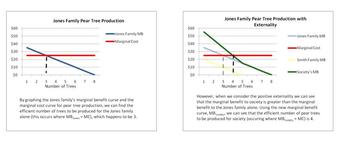
Effects of Externalities
This graph exemplifies how Coase’s Theorem functions in a practical manner, underlining the effects of an externality in an economic model.
In practice, transaction costs are rarely low enough to allow for efficient bargaining and hence the theorem is almost always inapplicable to economic reality.
Chapter 6: Elasticity and its Implications
6.1: Price Elasticity of Demand
6.1.1: Defining Price Elasticity of Demand
The price elasticity of demand (PED) measures the change in demand for a good in response to a change in price.
Learning Objective
Define the price elasticity of demand.
Key Points
- The PED is the percentage change in quantity demanded in response to a one percent change in price.
- The PED coefficient is usually negative, although economists often ignore the sign.
- Demand for a good is relatively inelastic if the PED coefficient is less than one (in absolute value).
- Demand for a good is relatively elastic if the PED coefficient is greater than one (in absolute value).
- Demand for a good is unit elastic when the PED coefficient is equal to one.
Key Terms
- Unit Elastic
-
Demand for a good is unit elastic when the percentage change in quantity demanded is equal to the percentage change in price.
- elastic
-
Demand for a good is elastic when a change in price has a relatively large effect on the quantity of the good demanded.
- inelastic
-
Demand for a good is inelastic when a change in price has a relatively small effect on the quantity of the good demanded.
The price elasticity of demand (PED) is a measure that captures the responsiveness of a good’s quantity demanded to a change in its price. More specifically, it is the percentage change in quantity demanded in response to a one percent change in price when all other determinants of demand are held constant.
The formula for the coefficient of PED is:
The law of demand states that there is an inverse relationship between price and demand for a good. As a result, the PED coefficient is almost always negative. However, economists tend to ignore the sign in everyday use. Only goods that do not conform to the law of demand, such as Veblen and Giffen goods, have a positive PED.
The numerical values for the PED coefficient could range from zero to infinity. In general, the demand for a good is said to be inelastic (or relatively inelastic) when the PED is less than one (in absolute value): that is, changes in price have a less than proportional effect on the quantity of the good demanded. The demand for a good is said to be elastic (or relatively elastic) when its PED is greater than one. In this case, changes in price have a more than proportional effect on the quantity of a good demanded.
A PED coefficient equal to one indicates demand that is unit elastic; any change in price leads to an exactly proportional change in demand (i.e. a 1% reduction in demand would lead to a 1% reduction in price).
A PED coefficient equal to zero indicates perfectly inelastic demand. This means that demand for a good does not change in response to price .
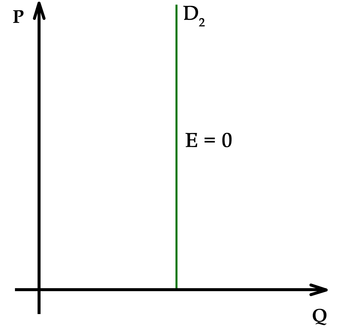
Perfectly Inelastic Demand
When demand is perfectly inelastic, quantity demanded for a good does not change in response to a change in price.
Finally, demand is said to be perfectly elastic when the PED coefficient is equal to infinity. When demand is perfectly elastic, buyers will only buy at one price and no other .
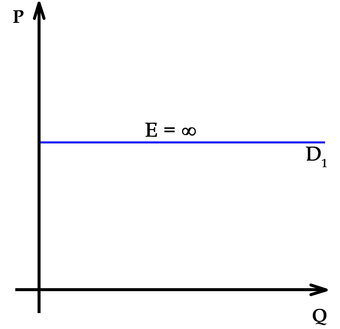
Perfectly Elastic Demand
When the demand for a good is perfectly elastic, any increase in the price will cause the demand to drop to zero.
6.1.2: Measuring the Price Elasticity of Demand
The price elasticity of demand (PED) is calculated by dividing the percentage change in quantity demanded by the percentage change in price.
Learning Objective
Calculate the own-price elasticity of demand
Key Points
- PED captures the change in quantity demanded in response to a change in the good’s own price (as opposed to the price of some other good).
- The formula for price elasticity yields a value that is negative, pure, and ranges from zero to negative infinity.
- The result provided by the formula will be accurate only if the changes in price and quantity demanded are small.
Key Terms
- Cross-price elasticity of demand
-
Measures the responsiveness of the demand for a good to a change in the price of another good.
- Own-price elasticity of demand
-
Responsiveness of quantity demanded to a change in the good’s own price
The price elasticity of demand (PED) captures how price-sensitive consumers are for a given product or service by measuring the responsiveness of quantity demanded to changes in the good’s own price. This is in contrast to measuring the responsiveness of the good’s demand to a change in price for some other good (a complement or substitute), which is called the cross-price elasticity of demand. The own-price elasticity of demand is often simply called the price elasticity.
The following formula is used to calculate the own-price elasticity of demand:
The formula above usually yields a negative value because of the inverse relationship between price and quantity demanded . However, economists often disregard the negative sign and report the elasticity as an absolute value. For example, if the price of a good increases by 5 percent and the quantity demanded decreases by 5 percent, then the elasticity at the initial price and quantity is -5%/5% = -1. This number is likely to be reported simply as 1.
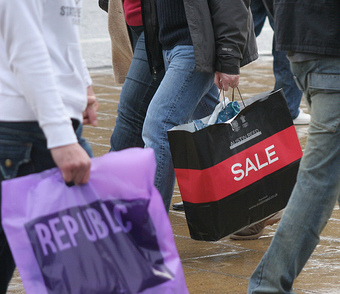
Sale
There is an inverse relationship between price and quantity demanded, so the elasticity coefficient is almost always negative.
There are a few other important points to note about the coefficient value provided by this formula. First, the elasticity coefficient is a pure number, meaning that it does not have units of measurement associated with it. Second, the coefficient value can range from zero to negative infinity. Finally, the result provided by the formula will be accurate only when the changes in price and quantity are small. The result will be less accurate when the changes are large.
Since PED is based off of percent changes, the starting nominal quantity and price matter. At low prices and high quantities, the PED is therefore more inelastic. For example, a drop in the price of $1 from a starting price of $100 is a 1% drop, but if the starting price is $10, it is a 10% drop. Similarly, at high prices and low quantities, PED is more elastic .

Price Elasticity of Demand and Revenue
PED is based off of percent changes, so the starting nominal values of price and quantity are significant.
6.1.3: Interpretations of Price Elasticity of Demand
The price elasticity of demand (PED) explains how much changes in price affect changes in quantity demanded.
Learning Objective
Describe the relationship between price elasticity and the shape of the demand curve.
Key Points
- Elastic PED can be interpreted as consumers being very sensitive to changes in price.
- Inelastic PED can be interpreted as consumes being insensitive to changes in price.
- Firms use PED to figure out how to change their prices in order to increase revenue.
- PED varies along a straight demand curve.
Key Term
- Price elasticity of demand
-
The percent change in quantity demanded due to a 1% change in price.
The price elasticity of demand (PED) is a measure of the responsiveness of the quantity demanded of a good to a change in its price. It can be calculated from the following formula:
When PED is greater than one, demand is elastic. This can be interpreted as consumers being very sensitive to changes in price: a 1% increase in price will lead to a drop in quantity demanded of more than 1%.
When PED is less than one, demand is inelastic. This can be interpreted as consumers being insensitive to changes in price: a 1% increase in price will lead to a drop in quantity demanded of less than 1%.
The effect of price changes on total revenue PED may be important for businesses attempting to distinguish how to maximize revenue For example, if a business finds out its PED is very inelastic, it may want to raise its prices because it knows that it can sell its products for a higher price without losing many sales. Conversely, if a business finds that its PED is very elastic, it may wish to lower its prices. This would allow the business to dramatically increase the number of units sold without losing much revenue per unit.
There are two notable cases of PED. The first is when demand is perfectly elastic. Perfectly elastic demand is represented graphically as a horizontal line . In this case, any increase in price will lead to zero units demanded.
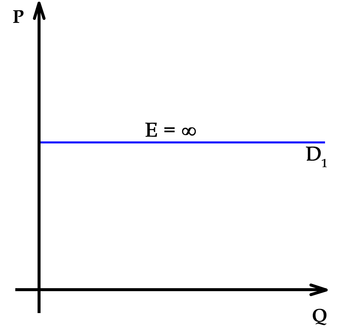
Perfectly Elastic Demand
Perfectly elastic demand is represented graphically by a horizontal line. In this case the PED value is the same at every point of the demand curve.
The second is perfectly inelastic demand. Perfectly inelastic demand is graphed as a vertical line and indicates a price elasticity of zero at every point of the curve. This means that the same quantity will be demanded regardless of the price.
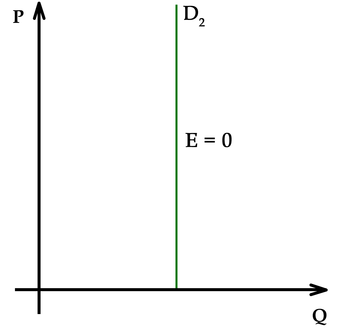
Perfectly Inelastic Demand
Perfectly inelastic demand is graphed as a vertical line. The PED value is the same at every point of the demand curve.
Since PED is measured based on percent changes in price, the nominal price and quantity mean that demand curves have different elasticities at different points along the curve. Elasticity along a straight line demand curve varies from zero at the quantity axis to infinity at the price axis . Below the midpoint of a straight line demand curve, elasticity is less than one and the firm wants to raise price to increase total revenue. Above the midpoint, elasticity is greater than one and the firm wants to lower price to increase total revenue. At the midpoint, E1, elasticity is equal to one, or unit elastic.
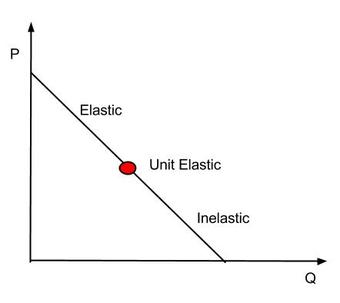
Elasticity and the Demand Curve
The price elasticity of demand for a good has different values at different points on the demand curve.
6.1.4: Determinants of Price Elasticity of Demand
A good’s price elasticity of demand is largely determined by the availability of substitute goods.
Learning Objective
Explain how a good’s price elasticity of demand may be different in the short term than in the long term
Key Points
- A good with more close substitutes will likely have a higher elasticity.
- The higher the percentage of a consumer’s income used to pay for the product, the higher the elasticity tends to be.
- For non-durable goods, the longer a price change holds, the higher the elasticity is likely to be.
- The more necessary a good is, the lower the price elasticity of demand.
Key Term
- Substitute Good
-
A good that fulfills a consumer need in a way that is similar to another good.
The price elasticity of demand (PED) is a measure of how much the quantity demanded changes with a change in price. The PED for a given good is determined by one or a combination of the following factors:
- Availability of substitute goods: The more possible substitutes there are for a given good or service, the greater the elasticity. When several close substitutes are available, consumers can easily switch from one good to another even if there is only a small change in price . Conversely, if no substitutes are available, demand for a good is more likely to be inelastic.
- Proportion of the purchaser’s budget consumed by the item: Products that consume a large portion of the purchaser’s budget tend to have greater elasticity. The relative high cost of such goods will cause consumers to pay attention to the purchase and seek substitutes. In contrast, demand will tend to be inelastic when a good represents only a negligible portion of the budget.
- Degree of necessity: The greater the necessity for a good, the lower the elasticity. Consumers will attempt to buy necessary products (e.g. critical medications like insulin) regardless of the price. Luxury products, on the other hand, tend to have greater elasticity. However, some goods that initially have a low degree of necessity are habit-forming and can become “necessities” to consumers (e.g. coffee or cigarettes).
- Duration of price change: For non-durable goods, elasticity tends to be greater over the long-run than the short-run. In the short-term it may be difficult for consumers to find substitutes in response to a price change, but, over a longer time period, consumers can adjust their behavior. For example, if there is a sudden increase in gasoline prices, consumers may continue to fuel their cars with gas in the short-run, but may lower their demand for gas by switching to public transportation, carpooling, or buying more fuel-efficient vehicles over a longer period of time. However, this tendency does not hold for consumer durables. The demand for durables (cars, for example) tends to be less elastic, as it becomes necessary for consumers to replace them with time.
- Breadth of definition of a good: The broader the definition of a good, the lower the elasticity. For example, potato chips have a relatively high elasticity of demand because many substitutes are available. Food in general would have an extremely low PED because no substitutes exist.
- Brand loyalty: An attachment to a certain brand (either out of tradition or because of proprietary barriers) can override sensitivity to price changes, resulting in more inelastic demand.
6.2: Other Demand Elasticities
6.2.1: Cross-Price Elasticity of Demand
The cross-price elasticity of demand measures the change in demand for one good in response to a change in price of another good.
Learning Objective
Use the cross elasticity of demand to describe a good
Key Points
- Complementary goods have a negative cross-price elasticity: as the price of one good increases, the demand for the second good decreases.
- Substitute goods have a positive cross-price elasticity: as the price of one good increases, the demand for the other good increases.
- Independent goods have a cross-price elasticity of zero: as the price of one good increases, the demand for the second good is unchanged.
Key Terms
- substitute
-
A good with a positive cross elasticity of demand, meaning the good’s demand is increased when the price of another is increased.
- Complement
-
A good with a negative cross elasticity of demand, meaning the good’s demand is increased when the price of another good is decreased.
The cross-price elasticity of demand shows the relationship between two goods or services. More specifically, it captures the responsiveness of the quantity demanded of one good to a change in price of another good. Cross-Price Elasticity of Demand (EA,B) is calculated with the following formula:
The cross-price elasticity may be a positive or negative value, depending on whether the goods are complements or substitutes. If two products are complements, an increase in demand for one is accompanied by an increase in the quantity demanded of the other. For example, an increase in demand for cars will lead to an increase in demand for fuel. If the price of the complement falls, the quantity demanded of the other good will increase. The value of the cross-price elasticity for complementary goods will thus be negative .

Complements
Two goods that complement each other have a negative cross elasticity of demand: as the price of good Y rises, the demand for good X falls.
A positive cross-price elasticity value indicates that the two goods are substitutes. For substitute goods, as the price of one good rises, the demand for the substitute good increases. For example, if the price of coffee increases, consumers may purchase less coffee and more tea. Conversely, the demand for a substitute good falls when the price of another good is decreased. In the case of perfect substitutes, the cross elasticity of demand will be equal to positive infinity .

Substitutes
Two goods that are substitutes have a positive cross elasticity of demand: as the price of good Y rises, the demand for good X rises.
Two goods may also be independent of each other. In this instance, if the price of one good changes, demand for the other good will stay constant. For independent goods, the cross-price elasticity of demand is zero : the change in the price of one good with not be reflected in the quantity demanded of the other.

Independent
Two goods that are independent have a zero cross elasticity of demand: as the price of good Y rises, the demand for good X stays constant.
6.2.2: Income Elasticity of Demand
The income elasticity of demand measures the responsiveness of the demand for a good or service to a change in income.
Learning Objective
Analyze the characteristics of the income elasticity of demand.
Key Points
- The income elasticity of demand is the ratio of the percentage change in demand to the percentage change in income.
- Normal goods have a positive income elasticity of demand (as income increases, the quantity demanded increases).
- Inferior goods have a negative income elasticity of demand (as income increases, the quantity demanded decreases).
Key Terms
- Superior Good
-
A type of normal good. Demand increases more than proportionally as income rises.
- Necessary Good
-
A type of normal good. An increase in income leads to a smaller than proportional increase in the quantity demanded.
The income elasticity of demand (YED) measures the responsiveness of demand for a good to a change in the income of the people demanding that good, ceteris paribus. It is calculated as the ratio of the percentage change in demand to the percentage change in income:
If an increase in income leads to an increase in demand, the income elasticity of that good or service is positive. A positive income elasticity is associated with normal goods. In contrast, if a rise in income leads to a decrease in demand, the good or service has a negative income elasticity of demand. A negative income elasticity is associated with inferior goods.
In all, there are five types of income elasticity of demand :
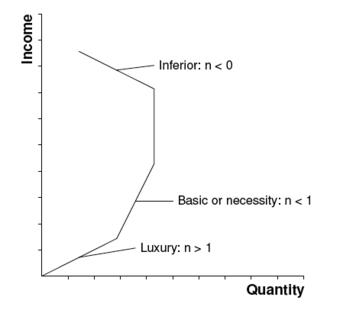
Income Elasticity of Demand
Income elasticity of demand measures the percentage change in quantity demanded as income changes.
- High income elasticity of demand (YED>1): An increase in income is accompanied by a proportionally larger increase in quantity demanded. This is typical of a luxury or superior good.
- Unitary income elasticity of demand (YED=1): An increase in income is accompanied by a proportional increase in quantity demanded.
- Low income elasticity of demand (YED<1): An increase in income is accompanied by less than a proportional increase in quantity demanded. This is characteristic of a necessary good.
- Zero income elasticity of demand (YED=0): A change in income has no effect on the quantity bought. These are called sticky goods.
- Negative income elasticity of demand (YED<0): An increase in income is accompanied by a decrease in the quantity demanded. This is an inferior good (all other goods are normal goods). The consumer may be selecting more luxurious substitutes as a result of the increase in income.
6.2.3: Calculating Elasticities
The basic elasticity formula has shortcomings which can be minimized by using the midpoint method or calculating the point elasticity.
Learning Objective
Calculate price elasticity of demand with the midpoint method
Key Points
- When changes in price and quantity are big, the arc elasticity or point elasticity formulas provide a more accurate elasticity coefficient than the basic elasticity formula.
- The arc elasticity captures the responsiveness of one variable to another between two given points.
- The midpoint method can be used if just two points on the demand curve are known. You do not need to know the function relating price and quantity demanded to use this method.
- The point elasticity captures the change in quantity demanded to a tiny change in price. To calculate the point elasticity, you must have a function for the relationship between price and quantity.
Key Terms
- Arc elasticity
-
The elasticity of one variable with respect to another between two given points.
- Point elasticity
-
The measure of the change in quantity demanded to a very small change in price.
The basic formula for the price elasticity of demand (percentage change in quantity demanded divided by the percentage change in price) yields an accurate result when the changes in quantity and price are small. As the difference between the two prices or quantities increases, however, the accuracy of the formula decreases. This happens because the price elasticity of demand often varies at different points along the demand curve and because the percentage change is not symmetric. Instead, the percentage change between any two values depends on which is chosen as the starting value. For example, when the quantity demanded increases from 10 units to 15 units, the percentage change is 50%. If the quantity demanded decreases from 15 units to 10 units, the percentage change is -33.3%. Two alternative elasticity measures can be used to avoid or minimize the shortcomings of the basic elasticity formula.
The midpoint method calculates the arc elasticity, which is the elasticity of one variable with respect to another between two given points on the demand curve . This measure requires just two points for quantity demanded and price to be known; it does not require a function for the relationship. The midpoint method uses the midpoint rather than the initial point for calculating percentage change, so it is symmetric with respect to the two prices and quantities demanded. The arc elasticity is obtained using this formula:
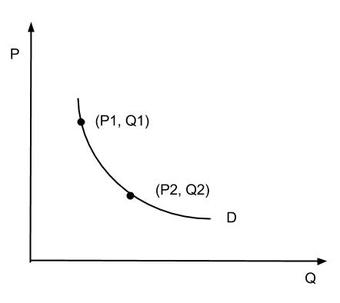
Arc Elasticity
To calculate the arc elasticity, you need to know two points on the demand curve. The calculation does not require a function for the relationship between price and quantity demanded.
Suppose that the price of hot dogs changes from $3 to $1, leading to a change in quantity demanded from 80 to 120. The formula provided above would yield an elasticity of 0.4/(-1) = -0.4. As elasticity is often expressed without the negative sign, it can be said that the demand for hot dogs has an elasticity of 0.4.
The point elasticity is the measure of the change in quantity demanded to a tiny change in price. It is the limit of the arc elasticity as the distance between the two points approaches zero, and hence is defined as a single point. In contrast to the midpoint method, calculating the point elasticity requires a defined function for the relationship between price and quantity demanded. The point elasticity can be calculated with the following formula:
In the formula above, dQ/dP is the partial derivative of quantity with respect to price, and P and Q are price and quantity, respectively, at a given point on the demand curve.
6.3: Price Elasticity of Supply
6.3.1: Definition of Price Elasticity of Supply
The price elasticity of supply is the measure of the responsiveness in quantity supplied to a change in price for a specific good.
Learning Objective
Differentiate between the price elasticity of demand for elastic and inelastic goods
Key Points
- Elasticity is defined as a proportionate change in one variable over the proportionate change in another variable:
- The impact that a price change has on the elasticity of supply also directly impacts the elasticity of demand.
- Inelastic goods are often described as necessities, while elastic goods are considered luxury items.
- The elasticity of a good will be labelled as perfectly elastic, relatively elastic, unit elastic, relatively inelastic, or perfectly inelastic.
Key Terms
- demand
-
The desire to purchase goods and services.
- supply
-
The amount of some product that producers are willing and able to sell at a given price, all other factors being held constant.
- luxury
-
Something very pleasant but not really needed in life.
In economics, elasticity is a summary measure of how the supply or demand of a particular good is influenced by changes in price. Elasticity is defined as a proportionate change in one variable over the proportionate change in another variable:
The price elasticity of supply (PES) is the measure of the responsiveness in quantity supplied (QS) to a change in price for a specific good (% Change QS / % Change in Price). There are numerous factors that directly impact the elasticity of supply for a good including stock, time period, availability of substitutes, and spare capacity. The state of these factors for a particular good will determine if the price elasticity of supply is elastic or inelastic in regards to a change in price.
The price elasticity of supply has a range of values:
- PES > 1: Supply is elastic.
- PES < 1: Supply is inelastic.
- PES = 0: The supply curve is vertical; there is no response of demand to prices. Supply is “perfectly inelastic.”
- PES =
(i.e., infinity): The supply curve is horizontal; there is extreme change in demand in response to very small change in prices. Supply is “perfectly elastic.”
Inelastic goods are often described as necessities. A shift in price does not drastically impact consumer demand or the overall supply of the good because it is not something people are able or willing to go without. Examples of inelastic goods would be water, gasoline, housing, and food.
Elastic goods are usually viewed as luxury items. An increase in price for an elastic good has a noticeable impact on consumption. The good is viewed as something that individuals are willing to sacrifice in order to save money. An example of an elastic good is movie tickets, which are viewed as entertainment and not a necessity.
The price elasticity of supply is determined by:
- Number of producers: ease of entry into the market.
- Spare capacity: it is easy to increase production if there is a shift in demand.
- Ease of switching: if production of goods can be varied, supply is more elastic.
- Ease of storage: when goods can be stored easily, the elastic response increases demand.
- Length of production period: quick production responds to a price increase easier.
- Time period of training: when a firm invests in capital the supply is more elastic in its response to price increases.
- Factor mobility: when moving resources into the industry is easier, the supply curve in more elastic.
- Reaction of costs: if costs rise slowly it will stimulate an increase in quantity supplied. If cost rise rapidly the stimulus to production will be choked off quickly.
The result of calculating the elasticity of the supply and demand of a product according to price changes illustrates consumer preferences and needs . The elasticity of a good will be labelled as perfectly elastic, relatively elastic, unit elastic, relatively inelastic, or perfectly inelastic.
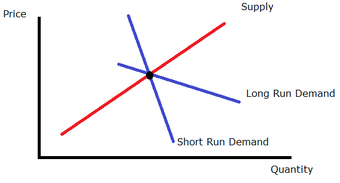
Price elasticity over time
This graph illustrates how the supply and demand of a product are measured over time to show the price elasticity.
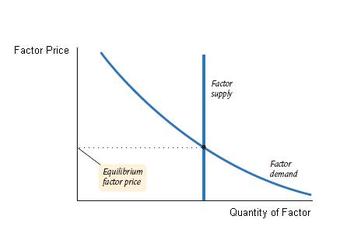
Perfectly Inelastic Supply
A graphical representation of perfectly inelastic supply.
6.3.2: Measuring the Price Elasticity of Supply
The price elasticity of supply is the measure of the responsiveness of the quantity supplied of a particular good to a change in price.
Learning Objective
Calculate elasticities and describe their meaning
Key Points
- The price elasticity of supply = % change in quantity supplied / % change in price.
- When calculating the price elasticity of supply, economists determine whether the quantity supplied of a good is elastic or inelastic.
- PES > 1: Supply is elastic. PES < 1: Supply is inelastic. PES = 0: if the supply curve is vertical, and there is no response to prices. PES = infinity: if the supply curve is horizontal.
Key Terms
- mobility
-
The ability for economic factors to move between actors or conditions.
- capacity
-
The maximum that can be produced on a machine or in a facility or group.
The price elasticity of supply (PES) is the measure of the responsiveness of the quantity supplied of a particular good to a change in price (PES = % Change in QS / % Change in Price). The intent of determining the price elasticity of supply is to show how a change in price impacts the amount of a good that is supplied to consumers. The price elasticity of supply is directly related to consumer demand.
Elasticity
The elasticity of a good provides a measure of how sensitive one variable is to changes in another variable. In this case, the price elasticity of supply determines how sensitive the quantity supplied is to the price of the good.
Calculating the PES
When calculating the price elasticity of supply, economists determine whether the quantity supplied of a good is elastic or inelastic. The percentage of change in supply is divided by the percentage of change in price. The results are analyzed using the following range of values:
- PES > 1: Supply is elastic.
- PES < 1: Supply is inelastic.
- PES = 0: Supply is perfectly inelastic. There is no change in quantity if prices change.
- PES = infinity: Supply is perfectly elastic. An decrease in prices will lead to zero units produced.
Factors that Influence the PES
There are numerous factors that impact the price elasticity of supply including the number of producers, spare capacity, ease of switching, ease of storage, length of production period, time period of training, factor mobility, and how costs react.
The price elasticity of supply is calculated and can be graphed on a demand curve to illustrate the relationship between the supply and price of the good .
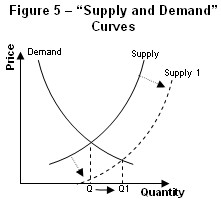
Supply and Demand Curves
A demand curve is used to graph the impact that a change in price has on the supply and demand of a good.
6.3.3: Applications of Elasticities
In economics, elasticity refers to how the supply and demand of a product changes in relation to a change in the price.
Learning Objective
Give examples of inelastic and elastic supply in the real world
Key Points
- To determine the elasticity of a product, the proportionate change of one variable is placed over the proportionate change of another variable (Elasticity = % change of supply or demand / % change in price).
- For elastic demand, a change in price significantly impacts the supply and demand of the product.
- For inelastic demand, a change in the price does not substantially impact the supply and demand of the product.
- Economists use demand curves in order to document and study elasticity.
Key Terms
- elastic
-
Sensitive to changes in price.
- supply
-
The amount of some product that producers are willing and able to sell at a given price, all other factors being held constant.
- inelastic
-
Not sensitive to changes in price.
- demand
-
The desire to purchase goods and services.
Example
- If the per gallon price of water increases from $10 to $11, there is a 10% increase in price. As a result of the price increase, the demand for water drops from 100 gallons to 99 gallons of water per day, which is a 1% decrease. In this case, the price increase of water is inelastic because it does not substantially impact the supply and demand (there is only a 1/10 change in demand).
In economics, elasticity refers to the responsiveness of the demand or supply of a product when the price changes.
The technical definition of elasticity is the proportionate change in one variable over the proportionate change in another variable. For example, to determine how a change in the supply or demand of a product is impacted by a change in the price, the following equation is used: Elasticity = % change in supply or demand / % change in price.
The price is a variable that can directly impact the supply and demand of a product. If a change in the price of a product significantly influences the supply and demand, it is considered “elastic.” Likewise, if a change in product price does not significantly change the supply and demand, it is considered “inelastic.”
For elastic demand, when the price of a product increases the demand goes down. When the price decreases the demand goes up. Elastic products are usually luxury items that individuals feel they can do without. An example would be forms of entertainment such as going to the movies or attending a sports event. A change in prices can have a significant impact on consumer trends as well as economic profits. For companies and businesses, an increase in demand will increase profit and revenue, while a decrease in demand will result in lower profit and revenue.
For inelastic demand, the overall supply and demand of a product is not substantially impacted by an increase in price. Products that are usually inelastic consist of necessities like food, water, housing, and gasoline. Whether or not a product is elastic or inelastic is directly related to consumer needs and preferences. If demand is perfectly inelastic, then the same amount of the product will be purchased regardless of the price.
Economists study elasticity and use demand curves in order to diagram and study consumer trends and preferences. An elastic demand curve shows that an increase in the supply or demand of a product is significantly impacted by a change in the price . An inelastic demand curve shows that an increase in the price of a product does not substantially change the supply or demand of the product .
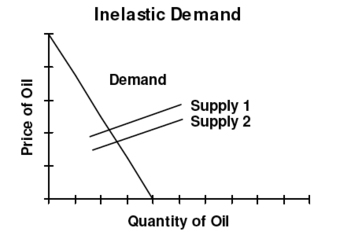
Inelastic Demand
For inelastic demand, when there is an outward shift in supply and prices fall, there is no substantial change in the quantity demanded.
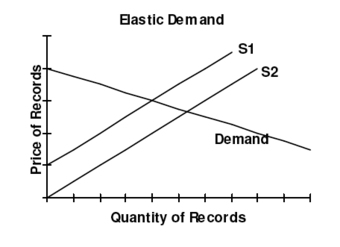
Elastic Demand
For elastic demand, when there is an outward shift in supply, prices fall which causes a large increase in quantity demanded.
Chapter 5: Consumer Choice and Utility
5.1: The Demand Curve and Utility
5.1.1: Defining Utility
Utility is an economic measure of how valuable, or useful, a good or service is to a consumer.
Learning Objective
Define Utility
Key Points
- Utility is measured by comparing multiple options.
- Utility can be positive and negative.
- Ordinal utility ranks a series of preferences without measuring how much more valuable one option is than another. Cardinal utility measures how much more preferable one option is in comparison to another.
- Ordinal utility is generally the preferred method of measuring utility.
Key Terms
- cardinal
-
Describing a “natural” number used to indicate quantity (e.g., one, two, three), as opposed to an ordinal number indicating relative position.
- utility
-
The ability of a commodity to satisfy needs or wants; the satisfaction experienced by the consumer of that commodity.
- ordinal
-
Of a number, indicating position in a sequence.
Utility is a term used by economists to describe the measurement of “useful-ness” that a consumer obtains from any good or service. Utility may measure how much one enjoys a movie or the sense of security one gets from buying a deadbolt. The utility of any object or circumstance can be considered. Some examples include the utility from eating an apple, from living in a certain house, from voting for a specific candidate, or from having a given wireless phone plan. In fact, every decision that an individual makes in their daily life can be viewed as a comparison between the utility gained from pursuing one option or another .
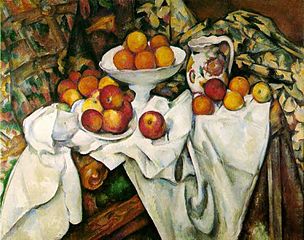
Apples and Oranges
Utility allows you to compare apples and oranges based on which you prefer.
Utility may be positive or negative with no effect on its interpretation. If one option gives
utility and another gives
, selecting the second is not, as it might seem, the “lesser of two evils,” but can only be interpreted as the better option.
Utility can be measured in one of two ways:
- Ordinal utility ranks a series of options in order of preference. This ranking does not show how much more valuable one option is than another, only that one option is preferable over another. An example of a statement reflecting ordinal utility is that “I would rather read than watch television. ” Generally, ordinal utility is the preferred method for gauging utility.
- Cardinal utility also ranks a series of options in order of preference, but it also measures the magnitude of the utility differences. An example of a statement reflecting cardinal utility is “I would enjoy reading three times more than watching television. ” Given how difficult it is to precisely measure preference, cardinal utility is rarely used.
5.1.2: Theory of Utility
The theory of utility states that, all else equal, a rational person will always choose the option that has the highest utility.
Learning Objective
Explain the Theory of Utility
Key Points
- The rationality assumption gives a basis for modeling human behavior and decision making.
- Utility includes every element of a decision.
- Rationality is dependent on a person’s individual preferences. Therefore, what might be a rational decision for one person may not be a rational decision for another.
Key Term
- Rational individual
-
A person who chooses the option that, all else equal, gives the greatest utility.
The theory of utility is based on the assumption of that individuals are rational. Rationality has a different meaning in economics than it does in common parlance. In economics, an individual is “rational” if that individual maximizes utility in their decisions. Whenever an individual is to choose between a group of options, they are rational if they choose the option that, all else equal, gives the greatest utility. Recalling that utility includes every element of a decision, this assumption is not particularly difficult to accept. If, when everything is taken into account, one decision provides the greatest utility, which is equivalent to meaning that it is the most preferred, then we would expect the individual to take that most preferred option. This should not necessarily be taken to mean that individuals who fail to quantify and measure every decision they make are behaving irrationally. Rather, this means that a rational individual is one who always selects that option that they prefer the most .

Consumer making a decision
When making an economically rational purchasing decision, a consumer must consider all of their personal preferences.
It is important to emphasize how rationality relates to a person’s individual preferences. People prioritize different things. For example one person may prioritize flavor while another person may value making healthy choices more. As a result the first person may choose a sugary cereal while the second may choose granola. Based on their preferences, both made the economically rational choice.
The rationality assumption gives a basis for modeling human behavior and decision making. If we could not assume rationality, it would be impossible to say what, when presented with a set of choices, an individual would select. The notion of rationality is therefore central to any understanding of microeconomics.
5.1.3: Marginal Utility
Marginal utility of a good or service is the gain from an increase or loss from a decrease in the consumption of that good or service.
Learning Objective
Define Marginal Utility
Key Points
- Marginal utility is measured on a per unit basis.
- Since an individual’s utility is rarely measured using cardinal means, calculating a product’s marginal value for an individual may be difficult.
- Instead of trying to calculate a product’s marginal value for an individual, economists assign dollar values to products based on their market price. This allows economists to estimate a product’s marginal value based on all the consumer’s preferences.
- The idea of marginal value is an important consideration when making production or purchasing decisions. A person should produce or purchase an additional item when the marginal utility exceeds the marginal cost.
Key Terms
- marginal
-
Of, relating to, or located at or near a margin or edge; also figurative usages of location and margin (edge).
- cardinal
-
Describing a “natural” number used to indicate quantity (e.g., one, two, three), as opposed to an ordinal number indicating relative position.
In economic terms, marginal utility of a good or service is the gain from an increase or loss from a decrease in the consumption of that good or service. The idea of marginal value is an important consideration when making production or purchasing decisions. A person should produce or purchase an additional item when the marginal utility exceeds the marginal cost .

Marginal Utility of Housing
The marginal utility of owning a second house is likely less than the marginal utility of owning the first house.
Marginal utility is measured on a per unit basis. When evaluating the marginal utility of any item, it is important to know in what unit utility is measured. The unit is based on the type of activity that you are trying to measure. If you are a consumer of potato chips, you might measure utility based on whether to buy another bag or have another hand full with your lunch. If you are a producer of potato chips, your marginal value might be defined by a pallet of potato chips. In general, marginal value should be measured based on the smallest unit of consumption or production related to the product in question.
It is also important to remember that utility is difficult to quantify since preferences vary based on the individual. Utility is rarely measured in terms of magnitude; utility is normally just about determining which option is the best choice. Since utility is rarely measured using cardinal means, it may seem difficult to determine a product’s marginal value. Economists get around this by substituting dollar values. While this may fail to capture a specific individual’s preferences and utility, it offers a good approximation based on everyone’s collective preferences as defined by the market.
5.1.4: Principle of Diminishing Marginal Utility
The principle of diminishing marginal utility states that as more of a good or service is consumed, the marginal benefit of the next unit decreases.
Learning Objective
Explain diminishing marginal utility
Key Points
- If you consume too much, the marginal utility of a good or service can become negative.
- In some circumstances, the marginal utility of producing or consuming an additional unit will increase for a short period of time. Generally there will be a “tipping point” at which marginal utility will then decrease.
- Generally these exceptions occur when what is being consumed is a component of a larger whole.
Key Terms
- utility
-
The ability of a commodity to satisfy needs or wants; the satisfaction experienced by the consumer of that commodity.
- marginal benefit
-
The extra benefit received from a small increase in the consumption of a good or service. It is calculated as the increase in total benefit divided by the increase in consumption.
The principle of diminishing marginal utility states that as an individual consumes more of a good, the marginal benefit of each additional unit of that good decreases.
The concept of diminishing marginal utility is easy to understand since there are numerous examples of it in everyday life. Imagine it is a hot summer day and you are hungry, so you get some ice cream. The first bite is great and so is the second. But with each spoonful, your hunger decreases and you become cooler. So while the last bite might still be good, it is probably not as satisfying as the first. This is a simple illustration of diminishing marginal utility .
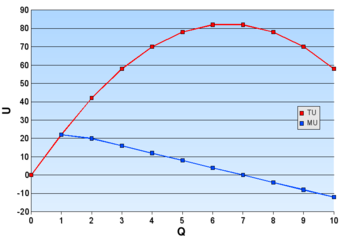
Total and marginal utility
As you can see in the chart, the more of a good you consume, the further its marginal utility decreases.
Negative Marginal Utility
While there are some circumstances where there will always be some marginal utility to producing or consuming more of a good, there are also circumstances where marginal utility can become negative. For example, while some antibiotics may be useful in curing diseases. However, if you take too much you can become sick or resistant to the drugs which could lead to future illnesses being incurable. So it is important to remember that “diminishing” does not necessarily mean to zero; you can have too much of a good thing.
Exceptions to the General Rule
This concept suggests a uniform steady decline of marginal utility, but that may not always be the case. There can be situations in which one might gain more utility from consuming a later unit of a good than from earlier consumption. If you are going on a date, for example, getting one ticket to a concert will have some utility but the second arguably has more because it enhances the value of the first.
Generally these exceptions occur when what is being consumed is a component of a larger whole. While utility may increase for a period, there is usually a “tipping point” where afterwards marginal utility decreases. Getting a third ticket for your date will have low marginal utility than the second.
5.2: Theory of Consumer Choice
5.2.1: Introducing the Budget Constraint
Budget constraints represent the plausible combinations of products and services a buyer can purchase with the available capital on hand.
Learning Objective
Discuss the role of the budget set and indifference curve in determining the choice that gives a consumer maximum satisfaction
Key Points
- Consumers analyze the optimal way in which to leverage their purchasing power to maximize their utility and minimize opportunity costs through employing trade-offs.
- The way economists demonstrate this arithmetically and visually is through generating budget curves and indifference curves.
- Budget curves indicate the relationship between two goods relative to opportunity costs, which defines the value of each good relative to one another.
- Indifference curves underline the way in which a given consumer interprets the value of each good relative to one another, demonstrating how much of ‘good
‘ is equivalent in utility to a certain quantity of ‘good
‘ (and vice versa). - Through utilizing these economic tools, economists can predict consumer behavior and consumers can maximize their overall utility based upon their budget constraints.
Key Terms
- Trade-offs
-
Any situation in which the quality or quantity of one thing must be decreased for another to be increased.
- utility
-
The ability of a commodity to satisfy needs or wants; the satisfaction experienced by the consumer of that commodity.
Example
- Pretend you have $100 to spend on food for the month. You have a wide variety of options, but some will provide you with higher opportunity costs than others. You could purchase enough bread, rice, milk and eggs to feed yourself for the full month or you could buy premium cut steak and store-prepared dinners by the pound (which would last about one week). The opportunity cost of the former is the high quality foods which have the convenience factor of already being prepared for you while the opportunity cost of the latter is having enough food to feed yourself for the entire month. In this circumstance the decision is easy, and the trade off will be sacrificing convenience and high quality food for the ability to have enough food on the table over the course of the whole month.
The concept of budget constraints in the field of economics revolves around the idea that a given consumer is limited in consumption relative to the amount of capital they possess. As a result, consumers analyze the optimal way in which to leverage their purchasing power to maximize their utility and minimize opportunity costs. This is achieved through using budget constraints, which represent the plausible combinations of products and/or services a buyer is capable of purchasing with their capital on hand.
Trade-offs
To expand upon this definition further, the business concept of opportunity cost via trade-offs is a central building block in understanding budget constraints. An opportunity cost is defined as the foregone value of the next best alternative in a given action. To apply this to a real-life situation, pretend you have $100 to spend on food for the month. You have a wide variety of options, but some will provide you with higher opportunity costs than others. You could purchase enough bread, rice, milk and eggs to feed yourself for the full month or you could buy premium cut steak and store-prepared dinners by the pound (which would last about one week). The opportunity cost of the former is the high quality foods which have the convenience factor of already being prepared for you while the opportunity cost of the latter is having enough food to feed yourself for the entire month. In this circumstance the decision is easy, and the trade off will be sacrificing convenience and high quality food for the ability to have enough food on the table over the course of the whole month.
Budget Curves and Indifference Curves
Understanding these trade-offs underlines the true function of budget constraints in economics, which is identifying which consumer behaviors will maximize utility. Consumers are inherently equipped with an infinite demand and a finite pool of resources, and therefore must make budgetary decisions based on their preferences. The way economists demonstrate this arithmetically and visually is through generating budget curves and indifference curves.
Budget curves: This indicates the relationship between two goods relative to opportunity costs, which defines the value of each good relative to one another. For example, on the figure provided a quantity of 5 for ‘good
‘ is identical in price (economic value) as a quantity of 7 for ‘good
‘. This demonstrates the trade-off ratio between the two available products or services. It is important to keep in mind that prices and valuations of goods are constantly changing, and that the ratio between any two goods is not fixed over the long-term for most products/services.

Budget Curve
A budget curve demonstrates the relationship between two goods relative to opportunity costs, essentially deriving the relative value of each good based on quantity and utility. Keep in mind that moving from one point on the in to another is trading off ‘
‘ amount of one good for ‘
‘ amount of another.
Indifference curves: Indifference curves underline the way in which a given consumer interprets the value of each good relative to one another, demonstrating how much of ‘good
‘ is equivalent in utility to a certain quantity of ‘good
‘ (and vice versa). Any point along the indifference curve will represent indifference to the consumer, or simply put equivalent preference for one combination of goods or the other. In the figure it is clear that the budget curve has been included in conjunction with the indifference curves, which allows insight as to the ideal actual quantity of each good is optimal for this specific consumer.

Indifference Curves
Indifference curves are designed to represent an equal perception of overall value in a given basket of goods relative to a specific consumer. That is to say that each point along the curve is considered by the consumer of equivalent value despite alterations in the quantity of each good, as these trade-offs are consider of equal value and thus indifferent.
Through utilizing these economic tools, economists can predict consumer behavior and consumers can maximize their overall utility based upon their budget constraints.
5.2.2: Mapping Preferences with Indifference Curves
Economists mapping consumer preferences use indifference curves to illustrate a series of goods that represent equivalent utility.
Learning Objective
Describe the indifference curves for goods that are perfect substitutes and complements
Key Points
- Indifference curves illustrate bundles of goods that provide the same utility.
- An economist can derive conclusions based upon the properties of the illustration. In framing these implications it is useful to identify the two potential extremes of substitute goods and complementary goods.
- The comparison between the goods demonstrates the relative utility one has compared to another, and the way in which consumers will act when posed with a decision between various products and services.
- The comparison between the goods demonstrates the relative utility one has compared to another, and the way in which consumers will act when posed with a decision between various products and services.
Key Terms
- substitute
-
A good with a positive cross elasticity of demand, meaning the good’s demand is increased when the price of another is increased.
- Complement
-
A good with a negative cross elasticity of demand, meaning the good’s demand is increased when the price of another good is decreased.
A critical input to understanding consumer purchasing behaviors and the general demand present in a given market or economy for specific goods and services is the identification of consumer preferences. Consumer preference varies substantially from individual to individual and market to market, requiring comprehensive economic observation of consumer choices and behaviors. One of the primary tools leveraged by economists mapping consumer preferences is the indifference curve, which illustrates a series of bundled goods in which a consumer is indifferent. A consumer would be just as happy with any combination of Good X and Good Y on the curve . This could synonymous to saying baskets of goods that provide the same utility.

Indifference Curve
A consumer will be just as happy with any combination of Good X and Y on indifference curve I1, though s/he will prefer any bundle on indifference curve I2 or I3.
These indifference curves, when mapped graphically alongside other curves, is called an indifference map. A key consideration in creating any indifference map is what relative preferences should be isolated. While it is possible to create a complex array of preference maps to compare more than two products/services, each specific standard indifference map will be about creating a benchmark between two. For example one could compare relatively similar goods/services (i.e. apples vs. oranges) or dramatically different goods/services (i.e. university training vs. automobile purchasing). These two items being compared represent the x and y axis of a indifference map. A consumer will always prefer to be on the indifference curve farthest from the origin.
Implications of Indifference Maps
After constructing the required inputs to generate a comprehensive indifference map, an economist can derive conclusions based upon the properties of the illustration. In framing these implications it is useful to identify the two potential extremes that can be outlined via with indifference curves:
- Perfect Substitutes: To understand what a indifference curves will look like when products are perfect substitutes, please see . These lines are essentially perfectly straight, and that demonstrates that the relative utility of ‘Good X’ compared to that of ‘Good Y’ is equivalent regardless of the amount in question. It is reasonable to assume in this scenario that purchasing all of one or all of the other will not decrease the overall satisfaction of the consumer. Perfect substitutes are often homogeneous goods. A consumer with no preference between Burger King and McDonald’s, for example, might consider them perfect substitutes and be indifferent to spending all of their fast food money on one or the other.
- Perfect Complements: The opposite of a perfect substitute is a perfect complement (see ), which is illustrated graphically through curves with perfect right angles at the center. These right angles, and the subsequent straight horizontal and vertical lines, demonstrate that ‘Good X’ and ‘Good Y’ are inherently tied to one another and that the consumption of one is dependent upon the consumption of the other. An example of complementary goods might be university tuition and academic textbook purchases, an automobile and automobile insurance, or a cable and a television.
Combining an understanding of these inputs with the extremes demonstrated an indifference map, economists are able to draw meaningful conclusions regarding consumer choices and purchasing behaviors in the context of two goods. The comparison between the goods demonstrates the relative utility one has compared to another, and the way in which consumers will act when posed with a decision between various products and services.

Perfect Substitute Indifference Curve
In this particular series of indifference curves it is clear that ‘Good X’ and ‘Good Y’ are perfect substitutes for one another. That is to say that the utility of one is identical to the utility of the other across all quantities represented on the map.

Perfect Complement Indifference Curve
The perfect right angle in this series of indifference curves implies that the utility of ‘Good X’ and ‘Good Y’ are entirely interdependent. This is to say that in order to enjoy one good it is necessary to also have the other.
5.2.3: Properties of Indifference Curves
Almost all indifference curves will be negatively sloped, convex, and will not intersect.
Learning Objective
Analyze the properties that are common to many indifference curves
Key Points
- The concept of an indifference curve is predicated on the idea that a given consumer has rational preferences in regard to the purchase of groupings of goods, with a series of key properties that define the process of mapping these curves.
- Indifference curves only reside in the non-negative quadrant of a two-dimensional graphical illustration (or the upper right).
- Indifference curves are always negatively sloped. Essentially this assumes that the marginal rate of substitution is always positive.
- All curves projected on the indifference map must not intersect in order to ensure transitivity.
- Nearly all indifference lines will be convex, or curving inwards at the center (towards the bottom left).
Key Terms
- Transitive
-
Having the property that if an element
$x$ is related to$y$ and$y$ is related to$z$ , then$x$ is necessarily related to$z$ . - utility
-
The ability of a commodity to satisfy needs or wants; the satisfaction experienced by the consumer of that commodity.
Indifference curves trace the combination of goods that would give a consumer a certain level of utility. The indifference curve itself represents a series of combinations of quantities of goods (generally two) that a consumer would be indifferent between, or would value each of them equally in regards to overall utility. Indifference curves allow economists to predict consumer purchasing behaviors based upon utility maximization for a bundle of goods within the context of a given consumer’s budget constraints and preferences.
Properties of Indifference Curves
The concept of an indifference curve is predicated on the idea that a given consumer has rational preferences in regard to the purchase of groupings of goods, with a series of key properties that define the process of mapping these curves:
- Indifference curves only reside in the non-negative quadrant of a two-dimensional graphical illustration (or the upper right). This assumes that negative quantities are meaningless – one can’t consume a negative amount of a good.
- Indifference curves are always negatively sloped. This is based on the assumption that a consumer is always better off consuming more of a good, so as quantity consumed of one good increases, total satisfaction would increase if not offset by a decrease in the quantity consumed of another good. This also assumes that the marginal rate of substitution is always positive.
- All curves projected on the indifference map must also be transitive to ensure that if
is preferred to
and
is preferred to
,
is not also preferred to
. This is manifested in indifference curves that never intersect. - Nearly all indifference lines will be convex, or curving inwards at the center (towards the bottom left). This demonstrates that increasingly high quantities of one good over another have a cost in respect to their overall utility per unit (diminishing returns). It is technically possible for indifference curves to be perfectly straight as well, which would imply that the two goods are identical (perfect substitutes).
Combining these various properties, one can highlight a number of critical implications of consumer purchasing behavior and the concept of utility. Consumers naturally desire a bundle of goods that is varied (hence the convex curves for most comparisons) in order to maximize their utility. Similarly, all indifference curves will naturally identify diminishing rates of substitution as the quantity increases for a certain good compared to another, and can create demand projections of prospective supply.
5.2.4: Impact of Income on Consumer Choices
One of the central considerations for a consumer’s consumption choice is income or wage levels, and thus their budgetary constraints.
Learning Objective
Break down changes in consumption into the income effect and the wealth effect
Key Points
- The basic premise behind the income effect is that varying income levels will determine different quantities and balanced baskets along the provided indifference curves for any two goods being compared.
- These differences in quantity reflect the increase or decrease an a given individual’s purchasing power, thus the income effect could be summarized as the increase in relative utility captured by a consumer with more monetary power.
- Income effects on consumer choice grow more complex as the type of good changes, as different product and services demonstrate different properties relative to both other products/services and a consumers preferences and utility.
- The four key types of goods to consider are normal goods, inferior goods, complements and substitutes.
Key Terms
- Inferior goods
-
A good that decreases in demand when consumer income rises; having a negative income elasticity of demand.
- Income Effect
-
The change in consumption choices due to changes in the amount of money available for an individual to spend.
- Wealth Effect
-
The change in an individual’s consumption choices due to changes in perception of how rich s/he is.
Consumer choices are predicated on various economic circumstances, and recognizing the relationship between these circumstances and an individual’s purchasing behavior allows economists to recognize and predict consumer choice trends. One of the central considerations for a consumer in deciding upon their purchasing behaviors is their overall income or wage levels, and thus their budgetary constraints. These budgetary constraints, when applied to a series of products and services, can be optimized to capture the most utility for the consumer based on their purchasing power.
Income from a Consumer Theory Perspective
The simplest way to demonstrate the effects of income on overall consumer choice, from the viewpoint of Consumer Theory, is via an income-consumption curve for a normal good(see ). The basic premise behind this curve is that the varying income levels (as illustrated by the green income line curving upwards) will determine different quantities and balanced baskets along the provided indifference curves for the two goods being compared in this graph. These differences in quantity reflect the increase or decrease an a given individual’s purchasing power, thus the income effect could be summarized as the increase in relative utility captured by a consumer with more monetary power.

Income-Consumption Curve
Simply put, increases or decreases in income will alter the optimal quantity (and thus relative utility) of a given basket of goods for a specific consumer.
The wealth effect differs slightly from the income effect. The wealth effect reflects changes in consumer choice based on perceived wealth, not actual income. For example, if a person owns a stock that appreciates in price, they perceive that they are wealthier and may spend more, even though they have not realized those gains so their income has not increased.
Effects of Income on Different Goods
Income effects on consumer choice grow more complex as the type of good changes, as different product and services demonstrate different properties relative to both other products/services and a consumers preferences and utility. As a result, it is useful to outline the differences in income effects on normal, inferior, complementary and substitute goods:
- Normal:A normal good is a good with incremental increases or decreases in utility as quantity changes, demonstrating a predictable and simple linear relationship as income increases or decreases. demonstrates a graphical representation of the effects of income changes upon preference map.
- Inferior:Inferior goods, or goods that are less preferable, will demonstrate inverse relationships with income compared to normal goods. That is to say that an increase in income will not necessarily result in an increase in quantity for the inferior good, as the consumer derives minimal utility in purchasing the inferior good compared to other goods. Inferior goods are often sacrificed as income rises and consumers gain more choice/options. This can be represented in .
- Complementary: Complementary goods are goods that are interdependent in consumption, or essentially goods that require simultaneous consumption by the consumer. An example of this would be like purchasing an automobile and car insurance, the consumption of one requires the consumption of the other. As income increases, these will increase relative to one another (as a ratio). demonstrates this concept in graphical form.
- Substitutes: Perfect substitutes are essentially interchangeable goods, where the consumption of one compared to another has no meaningful impact on the consumer’s utility derived. Substitutes are goods that a consumer cannot differentiate between in terms of the need being filled and the satisfaction obtained. Income increases will thus affect the consumption of these goods interchangeably, resulting in increase in the quantity of either or both.
In merging Consumer Theory and consumer choices with income level, the primary takeaway is that an increase in income will increase the prospective utility that consumer can acquire in the market. Understanding how this applies in a general fashion, alongside the specific circumstances dictating specific types of goods, it becomes fairly straight-forward to predict consumer purchasing behaviors at differing income levels.

Income Levels and Inferior Goods
This graph demonstrates the inverse relationship between income and the consumption of inferior goods. As income rises, the quantity consumed of ‘X1’ decreases. This illustrates increased variance in consumer choice as income rises.

Income Effect on Complementary Goods
In this graphical depiction of income increases, the consumption of these two goods are complementary and thus interdependent.
5.2.5: Impact of Price on Consumer Choices
The demand curve shows how consumer choices respond to changes in price.
Learning Objective
Construct the demand curve using changes in consumption due to price changes
Key Points
- For normal goods or services, demand is illustrated with a downward sloping curve, where the quantity on the x-axis will generally increase as the price on the y-axis decreases (and vice versa).
- As the demand curve implies, price is the central driving force behind a decision to purchase a given product or service.
- A critical consideration of product/service pricing is the price elasticity of a given good, which indicates how responsive demand is to a change in price.
- Using demand curves, economists can project the impact of a price change on the consumer choices in a given market.
- The quantity demanded may change in response to both to shifts in demand (and the creation of a new demand curve, as demonstrated in and movements along the established demand curve.
Key Term
- elasticity
-
The sensitivity of changes in a quantity with respect to changes in another quantity.
In almost all cases, consumer choices are driven by prices. As price goes up, the quantity that consumers demand goes down. This correlation between the price of goods and the willingness to make purchases is represented clearly by the generation of a demand curve (with price as the y-axis and quantity as the x-axis). The construction of demand, which shows exactly how much of a good consumers will purchase at a given price, is defining of consumer choice theory.
Deriving Overall Demand
The generation of a demand curve is done by calculating what price consumers are willing to pay for a given quantity of a good or service. For normal goods or services, demand is illustrated with a downward sloping curve, where the quantity on the x-axis will generally increase as the price on the y-axis decreases (and vice versa). The quantity demanded may change in response to both to shifts in demand (and the creation of a new demand curve, as demonstrated in ) and movements along the established demand curve. A demand shift usually takes place when an external factor increases or decreases demand across the board, while a movement upwards or downwards on the curve is indicative of a change in the good’s price.

Demand Shifts
This graph demonstrates a shift in overall demand in the market, where the generation of a new parallel demand curve is required to accurately represent consumer choices.
As the demand curve implies, price is often the central driving force behind a decision to purchase a given product or service. Consumers must weigh the overall utility they can capture by making a purchase and benchmark that against their overall monetary resources to optimize their purchasing decisions. This practice regulates the price companies can set for their products and services, as the income effects and the prospective substitutions (substitution effect) will drive consumer purchase towards purchases that create the most value for themselves.
Price Elasticity
A critical consideration of product/service pricing is the price elasticity of a given good, which indicates how responsive demand is to a change in price. Price elasticity is essentially a measurement of how much any deviations in price will drive the overall quantity purchased up or down, underlining to what extent consumer purchasing decisions will be dictated by pricing. The figure pertaining to price elasticity shows how the slope of the demand curve will change depending on the degree of price sensitivity in the marketplace for a good. A highly elastic good will see consumers much less likely to purchase when prices are high and much more likely to purchase when prices are low, while a good with low elasticity will see consumers purchasing the same quantity regardless of small price changes.
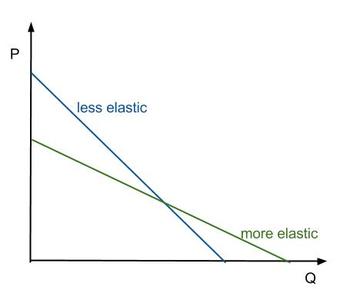
Price Elasticity
As this graph demonstrates, the slope of the demand curve will vary as a direct result of how elastic consumer purchasing behaviors will be compared to price changes.
Using demand curves, economists can project the impact of a price change on the consumer choices in a given market.
5.2.6: Deriving the Demand Curve
The law of demand pursues the derivation of a demand curve for a given product that benchmarks the relative prices and quantities desired.
Learning Objective
Explain how Giffen goods violate the law of demand
Key Points
- The derivation of demand is a useful tool in this pursuit, often combined with a supply curve in order to determine equilibrium prices and understand the relationship between consumer needs and what is readily available in the market.
- The inherent relationship between the price of a good and the relative amount of that good consumers will demand is the fulcrum of recognizing demand curves in the broader context of consumer choice and purchasing behavior.
- Generally speaking, normal goods will demonstrate a higher demand as a result of lower prices and vice versa.
- Giffen goods are a situation where the income effect supersedes the substitution effect, creating an increase in demand despite a rise in price.
- Neutral goods, unlike Giffen goods, demonstrate complete ambivalence to price. That is to say that consumer swill pay any price to get a fixed quantity.
Key Terms
- Derivation
-
The operation of deducing one function from another according to some fixed law, called the law of derivation, as the of differentiation or of integration.
- Giffen good
-
A good which people consume more of as only the price rises; Having a positive price elasticity of demand.
The law of demand in economics pertains to the derivation and recognition of a consumer’s relative desire for a product or service coupled with a willingness and ability to pay for or purchase that good. Consumer purchasing behavior is a complicated process weighing varying products/services against a constantly evolving economic backdrop. The derivation of demand is a useful tool in this pursuit, often combined with a supply curve in order to determine equilibrium prices and understand the relationship between consumer needs and what is readily available in the market.
Deriving Demand Curves
Despite a wide array of prospective goods and services in a constantly altering economic environment, the law of demand pursues the derivation of a demand curve for a given product that benchmarks the relative prices and quantities desired by consumers in a given marketplace. The inherent relationship between the price of a good and the relative amount of that good consumers will demand is the fulcrum of recognizing demand curves in the broader context of consumer choice and purchasing behavior.
Generally speaking, normal goods will demonstrate a higher demand as a result of lower prices and vice versa. The derivation of demand curves for normal goods is therefore relatively predictable in respect to the direction of the slope on a graph (see ). The downward slope represented in this figure underline the critical principle that a given price point will reflect a given quantity demanded by a given marketplace, allowing suppliers and economists to measure the value of a product/service based on a price/quantity analysis of consumer purchasing behaviors.
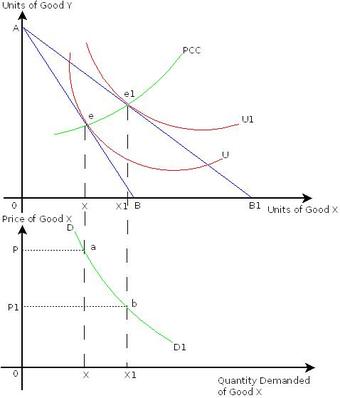
Deriving the Demand Curve (Normal Goods)
This illustration demonstrates the way in which economists can identify a series of prices and quantities for goods demanded, which ultimately represents the overall demand curve for a given product/service.
One important consideration in demand curve derivation is the differentiation between demand curve shifts and movement along the curve itself. Movement along the curve itself is the identification of what quantity will be purchased at different price points. This means that the factors that underlie consumer desire for the product remains constant and consistent, but the quantity or price alters to a new point along the established curve. Alternatively, sometimes external factors can shift the actual demand for a given good, pushing the demand curve outwards to the right and up or inwards down and left. This represents a substantial change in the actual demand for that product, as opposed to a quantity or price shift at a fixed demand level.
Exceptions: Giffen Goods and Neutral Goods
With the concept of general demand curves in mind, it is important to recognize that some goods do not conform to the traditional assumption that higher prices will always demonstrate lower demand. Giffen goods and neutral goods break this rule, with the former demonstrating an increase in demand as a result of a price rise (see ) and the latter demonstrating indifference to price in regards to the quantity demanded (illustrated as a completely vertical demand curve):
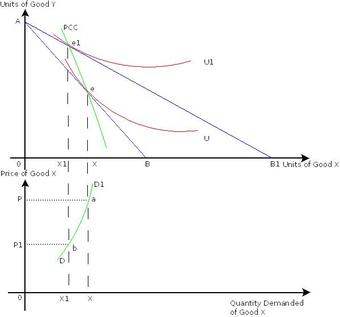
Demand Curve for Giffen Goods
Giffen goods are essentially goods that demonstrate an increase in demand as a result of an increase in price, generally considered counter-intuitive in traditional economic models. This graph illustrates the derivation of a demand curve for these goods.
- Giffen Goods – Giffen goods are a situation where the income effect supersedes the substitution effect, creating an increase in demand despite a rise in price. Goods such as high-end luxury items like expensive fashion often demonstrate this type of counter-intuitive trend, where the high price of an item is attractive to the consumer for the sake of displaying wealth.
- Neutral Goods – Neutral goods, unlike Giffen goods, demonstrate complete ambivalence to price. That is to say that consumers will pay any price to get a fixed quantity. These goods are often necessities, defying the standard law of demand due to the fact that they must be purchased regardless of price/situation. A good example of this is water or healthcare, where not getting what is required will have dramatic consequences.
5.2.7: Applications of Principles on Consumer Choices
The income effect and substitution effect combine to create a labor supply curve to represent the consumer trade-off of leisure and work.
Learning Objective
Explain the labor-leisure tradeoff in terms of income and substitution effects
Key Points
- Economics assumes a population of rational consumers, subjected to the complexities of modern economics while they attempt to maximize the utility obtainable within their income range.
- The income effect says that a consumers overall income level will have an effect on the quantities of goods that consumer will purchase.
- The substitution effect, similar to the income effect, identifies ways in which consumer purchasing power will alter the relative quantities of goods/services purchased by consumers at varying income levels and budgetary constraints.
- Combining the substitution effect and the income effect, one can derive an overall labor-leisure trade-off based on a given consumers purchasing power (income) relative to the price of necessary bundles of goods (substitution effect).
- A rational consumer will begin to work less hours after meeting their consumption requirements in order to capture the value of leisure (and enjoy their income in a meaningful way).
Key Terms
- substitution effect
-
The change in demand for one good that is due to the relative prices and availability of substitute goods.
- purchasing power
-
The amount of goods and services that can be bought with a unit of currency or by consumers.
- Income Effect
-
The change in consumption resulting from a change in real income.
Economics assumes a population of rational consumers, subjected to the complexities of modern economics while they attempt to maximize the utility obtainable within their income range. Central principles to analyzing consumer actions and choices are income effect and the substitution effect, which ultimately generate a labor supply to illustrate the labor-leisure trade-off for consumers.
Income Effect
The income effect needs two simple inputs: the average price of goods and the consumer’s income level. This creates a relative buying power, which will play a substantial role in the quantity of goods purchased. Predicting consumer choice requires inputs on consumer purchasing power and the goods in which they are deciding between. In we are comparing ‘Good X’ and ‘Good Y’ to identify how a change in income will alter the overall amount of each good would likely be purchased along a series of indifference curves (see Boundless atom on ‘Indifference Curves’). This graphical representation of a consumer’s income (I) and budget constraints (BC) underlines the variance in quantity of ‘Good X’ and ‘Good Y’ that will be demanded dependent upon income circumstance. Naturally, a higher income will result in a shift towards increase in quantity for many consumable goods/services.

Income Effects on Consumption and Budget Constraints
This graphical representation of a consumers income(I) and budget constraints (BC) underlines the variance in quantity of ‘Good X’ and ‘Good Y’ that will be demanded dependent upon income circumstance. Naturally, a higher income will result in a shift towards increase in quantity for many consumable goods/services.
Substitution Effect
The substitution effect is closely related to that of the income effect, where the price of goods and a consumers income will play a role in the decision-making process. In the substitution effect, a lower purchasing power will generally result in a shift towards more affordable goods (substituting cheaper in place of more expensive goods) while a higher purchasing power often results in substituting more expensive goods for cheaper ones. This shows the relationship between two graphs, pointing out how the substitution effect identifies the relationship between the price of a given good and the quantity purchased by a given consumer. As the bottom half of the figure implies, a higher price will dictate a lower quantity consumer for ‘Good Y’, while a lower price will create a higher quantity. This translates to the graph above as the consumer makes choices to maximize utility when comparing the price of different goods to a given income level, substituting cheaper goods and more expensive goods dependent upon purchasing power.

Substitution Effect
This two-part graphical representation of the substitution effect identifies the relationship between the price of a given good and the quantity purchased by a given consumer. As the bottom half effectively highlights, a higher price will dictate a lower quantity consumer for ‘Good Y’, while a lower price will create a higher quantity. This translates to the graph above as the consumer makes choices to maximize utility when comparing the price of different goods to a given income level.
Types of Goods
One additional important component of consumer choice is the way in which different goods demonstrate different reactions to income alterations and price changes:
- Income Changes: When income changes rises or falls, consumption of certain types of goods will have a positive or negative correlation with these changes. With normal goods, an increase of income will correlate with a higher quantity of consumption while a decrease in income will see a decrease in consumption. Inferior goods, on the other hand, will demonstrate an inverse relationship. A rise in income will cause a decrease in their consumption and vice versa.
- Price Changes: When price rises or falls, consumption of certain types of good will either demonstrate positive or negative correlations to these shifts in regard to quantity consumed. Ordinary goods will demonstrate the intuitive situation, where a rise in price will result in a decrease in quantity consumer. Inversely, Giffen goods demonstrate a positive relationship, where the price rises will result in higher demand for the good and high consumption.
Labor Supply Curve
These concepts of income versus required monetary inputs (prices) for goods/services generates a relationship between how much an individual will choose to work and how much an individual can take in terms of leisure time. Simply put, desired labor and leisure time are dependent upon income and prices for goods. The relationship between the number of hours worked and the overall wage levels results in something of a boomerang effect, with hours worked as the x-axis and wages as the y-axis.
Graphically represented, the labor supply curve looks like a backwards-bending curve , where an increase in wages from W1 to W2 will result in more hours being worked and an increase from W2 to W3 will result in less. This is primarily due to the fact that there is a certain amount of capital attained by consumers where they will be satisfied with their monetary utility, at which point working more has diminishing returns on their satisfaction. A rational consumer will begin to work less hours after meeting their consumption requirements in order to capture the value of leisure (and enjoy their income in a meaningful way).

Labor Supply Curve
The concept of labor supply economics is most efficiently communicated via the following graphical representation. This graph demonstrates the relationship between hours work and overall wage rates, demonstrating the shift in utility as wages increase.
To apply this to the concept of different types of goods above, one can view wage rates and leisure time as consumer goods. Depending on which point on the backwards-bending curve we are on, the trade-offs and thus the consumer decision will change. If a worker choose to work more when the wage rate rises, leisure is an ordinary good.
Chapter 4: Economic Surplus
4.1: Consumer Surplus
4.1.1: Willingness to Pay and the Demand Curve
In general as the price of a good increases, the quantity demanded of that good decreases.
Learning Objective
Explain the relationship between price and quantity demanded
Key Points
- Demand is the willingness and ability of a consumer to purchase a good under certain circumstances.
- Demand curves are used to estimate behaviors in competitive markets and are often used with supply curves to estimate the market equilibrium price, or the price at which sellers are willing to sell the same amount of a product as the market’s buyers are willing purchase.
- An individual’s demand is defined by her utility, purchasing power, and ability to make a purchasing decision.
Key Terms
- utility
-
The ability of a commodity to satisfy needs or wants; the satisfaction experienced by the consumer of that commodity.
- demand curve
-
The graph depicting the relationship between the price of a certain commodity and the amount of it that consumers are willing and able to purchase at that given price.
A demand curve is the graphical depiction of the relationship between the price of a certain commodity and the amount of it that consumers are willing and able to purchase at that price. Demand curves are used to estimate behaviors in competitive markets and are often used with supply curves to estimate the market equilibrium price, or the price at which sellers are willing to sell the same amount of a product as the market’s buyers are willing purchase. A demand graph can reflect the preferences of a single consumer, a group of consumers or an entire market . For demand graphs that reflect a group, the individual demands at each price are added together.
Demand is the willingness and ability of a consumer to purchase a good under the prevailing circumstances. It is defined by three elements:
- Individual Utility: An item’s utility is based on its ability to satisfy an individual’s needs or wants. Some utility is universal; every human needs water to survive so it has high utility for everyone. Some utility is based on personal preference; some people prefer Coke over Pepsi so for them Coke has the higher utility. The more people that find utility in the good the greater the market demand; the greater the individual utility in the product the greater the individual demand.
- Purchasing Power: Demand is measured based on a person’s willingness to buy under the prevailing circumstances. If an individual lacks the money to purchase the product, she can’t demand it because she cannot afford it.
- Ability to Decide: The individual must be able to choose to make a purchase. Sometimes circumstances may prevent a person from purchasing something they might desire, even if they have the necessary money. For example, an underaged person may not be permitted by law to purchase cigarettes. That person might want the cigarettes and can afford to purchase them, but since it is against the law for him to purchase it, there is no demand.
For the vast majority of goods and services, an increase in price will lead to a decrease in the quantity demanded . There are two exceptions to this general rule.
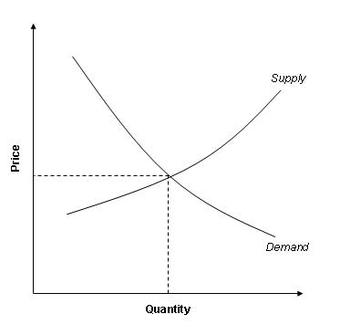
Supply and demand graph
The downward sloping demand curve reflects the fact that as price increases, consumers willing to purchase less of the good or service.
Veblen Goods
Veblen goods are expensive luxury products, such as designer handbags and high-end cars. In these rare circumstances, decreasing the price actually decreases the demand for the good. The reason for this is because part of the value of the good is exclusivity. These items are status symbols and lowering the price diminishes the status.
Giffen Goods
Giffen goods are another example where rising prices can lead to increased demand for a product. Giffen goods are very rare and are defined by three characteristics:
- It is an inferior good, or a good for which demand decreases as consumer income rises,
- There must be a lack of substitute product,
- The good must constitute a substantial percentage of the buyer’s income, but not such a substantial percentage of the buyer’s income that none of the associated normal goods are consumed.
For example, imagine a significant portion of a family’s grocery bill is bread. Bread is a staple and it is the cheapest option out of the food available. If bread prices rise, the family will need to cut back on other groceries to make up the difference. However, since the family still need to eat a certain amount of calories each day and bread is still the cheapest option, they will purchase more bread to make up for the food they aren’t purchasing and consuming. In this instance, bread is a giffen good.
4.1.2: The Demand Curve and Consumer Surplus
Consumer surplus is the difference between the maximum price a consumer is willing to pay and the actual price they do pay.
Learning Objective
Illustrate consumer surplus with the demand schedule and demand curve
Key Points
- On a supply and demand chart, consumer surplus is bound by the y-axis on the left, the demand curve on the right, and a horizontal line where y equals the current market price.
- Another way to define consumer surplus in less quantitative terms is as a measure of a consumer’s well-being.
- An individual’s customer surplus for a product is based on the individual’s utility of that product.
Key Term
- consumer surplus
-
The difference between the maximum price a consumer is willing to pay and the actual price they do pay.
Consumer surplus is the difference between the maximum price a consumer is willing to pay and the actual price they do pay. If a consumer would be willing to pay more than the current asking price, then they are getting more benefit from the purchased product than they spent to buy it. Consumer surplus plus producer surplus equals the total economic surplus in the market.
This chart graphically illustrates consumer surplus in a market without any monopolies, binding price controls, or any other inefficiencies . The price in this chart is set at the pareto optimal. This means that the price could not be increased or decreased without one of the parties being made worse off. The consumer surplus, as marked in red, is bound by the y-axis on the left, the demand curve on the right, and a horizontal line where y equals the equilibrium price. This area represent the amount of goods consumers would have been willing to purchase at a price higher than the pareto optimal price. Generally, the lower the price, the greater the consumer surplus.

Consumer Surplus
Consumer surplus, as shown highlighted in red, represents the benefit consumers get for purchasing goods at a price lower than the maximum they are willing to pay.
Another way to define consumer surplus in less quantitative terms is as a measure of a consumer’s well-being. Some goods, like water, are valuable to everyone because it is a necessity for survival. But the utility, or “usefulness,” of most goods vary depending on a person’s individual preferences. Since the utility a person gets from a good defines her demand for it, utility also defines the consumer surplus an individual might get from purchasing that item. If a person has no use for a good, there is no consumer’s surplus for that person in purchasing the good no matter the price. However, if a person finds a good incredibly useful, consumer surplus will be significant even if the price is high. An individual’s customer surplus for a product is based on the individual’s utility of that product.
4.1.3: Impacts of Price Changes on Consumer Surplus
Consumer surplus decreases when price is set above the equilibrium price, but increases to a certain point when price is below the equilibrium price.
Learning Objective
Explain how shifting a price away from pareto optimal will impact consumer surplus
Key Points
- Consumer surplus will only increase as long as the benefit from the lower price exceeds the costs from the resulting shortage.
- Consumer surplus always decreases when a binding price floor is instituted in a market above the equilibrium price.
- The total economic surplus equals the sum of the consumer and producer surpluses.
- Price helps define consumer surplus, but overall surplus is maximized when the price is pareto optimal, or at equilibrium.
Key Terms
- price floor
-
A mandated minimum price for a product in a market.
- Price ceiling
-
A government-imposed price control or limit on how high a price is charged for a product.
Consumer surplus is defined, in part, by the price of the product. Recall that the consumer surplus is calculating the area between the demand curve and the price line for the quantity of goods sold . Assuming that there is no shift in demand, an increase in price will therefore lead to a reduction in consumer surplus, while a decrease in price will lead to an increase in consumer surplus.
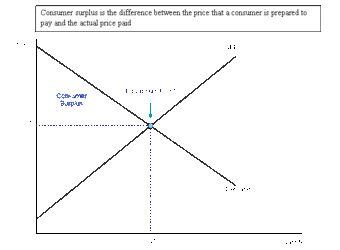
Consumer Surplus
An increase in the price will reduce consumer surplus, while a decrease in the price will increase consumer surplus.
Below are two scenarios that illustrate how changes in price can affect consumers’ surplus. It is important to note that any shift from the good’s pareto optimal price will result in a decrease in the total economic surplus. The total economic surplus equals the sum of the consumer and producer surpluses.
Price Ceiling
A binding price ceiling is one that is lower than the pareto efficient market price. This means that consumers will be able to purchase the product at a lower price than what would normally be available to them. It might appear that this would increase consumer surplus, but that is not necessarily the case.
For consumers to achieve a surplus they have to be able to purchase the product, which means that producers have to make enough to be purchased at a price. If a good’s price drops below the market equilibrium for whatever reason, manufacturing the product will be less profitable for the producers. So while more consumers will want to purchase the product because of its low price, they will not be able to. This means the market will have a shortage for that good. This shortage will create a deadweight loss, or a market wide loss of efficiency and value that neither producer nor consumers obtain.
So any increase in consumer surplus due to the decrease in price may be offset by the fact that consumers that want the good cannot purchase it. At some point the benefit from the drop in price will be outweighed by the decrease in the good’s availability.
Price Floor
When a price floor is set above the equilibrium price, consumers will have to purchase the product at a higher price. Therefore, fewer consumers will purchase the product because some will decide that the utility they get from the good is not worth the price. Necessarily, this reflects a drop in consumer surplus.
4.2: Producer Surplus
4.2.1: Market Power
Market power is a measure of a firm’s economic strength that affects its pricing and supply decisions.
Learning Objective
Summarize the relationship between market power and a firm’s supply decision
Key Points
- Firms with market power are said to be “price makers. ” They can raise prices and change the quantity supplied of goods and services without hurting profits. Market power often exists when there is a monopoly or oligopoly.
- Firms with limited to no market power are said to be “price takers. ” They cannot raise their prices or change the quantity supplied of goods and services without hurting profits. Perfectly competitive firms are examples of price takers with no market power.
- Market power is determined by the number of producers in the market, the size of each firm, barriers to entry in the market, and availability of substitute goods. Firm size and market size alone do not dictate market power.
- Market power is often measured with concentration ratios or the Herfindahl-Hirschman Index, but these are not perfect measures.
Key Terms
- market power
-
The ability of a firm to profitably raise the market price of a good or service over marginal cost. A firm with total market power can raise prices without losing any customers to competitors.
- contestable market
-
An imperfectly competitive industry subject to potential entry if prices or profits increase.
- concentration ratio
-
The proportion of total industry output produced by the largest firms (usually the four largest).
- Herfindahl-Hirschman Index
-
A measure of the size of firms in relation to the industry and an indicator of the amount of competition among them.
Market power is a measure of the economic strength of a firm. It is the ability of a firm to influence the quantity or price of goods and services in a market. A firm is said to have significant market power when price exceeds marginal cost and long run average cost, so the firm makes economic profits. Such firms are often referred to as “price makers. ” In contrast, firms with limited to no market power are referred to as “price takers. “
Determinants of Market Power
A firm usually has market power by virtue of controlling a large portion of the market. However, market size alone is not the only indicator of market power. Other factors that affect a firm’s market power include:
- Number of producers
- Size of firms in the market
The numbers and size of firms determine the extent that firms can withstand pressures and threats to change prices or product flows. However, being a large firm does not necessarily equal market power. For example, while conglomerates may be very large, they may play only small roles in many different markets and have no ability to influence prices in any of them.
- Barriers to entry
Barriers to entry determine how contestable the market is. Even highly concentrated markets may be contestable markets if there are no barriers to entry or exit, which limits a firm’s ability to raise its price above competitive levels.
Common barriers to entry include control of a scarce resource, increasing returns to scale, technological superiority, and government-imposed barriers.
- Availability of substitute goods
Greater availability of substitute goods will weaken a firm’s market power.
Relationship between Market Power and Firm Behavior
A firm’s market power influences its behavior. For example, market power gives firms the ability to engage in unilateral anti-competitive behavior. Some of the behaviors that firms with market power are accused of engaging in include predatory pricing, product tying, and creation of overcapacity or other barriers to entry . If no individual participant in the market has significant market power, then anti-competitive behavior can take place only through collusion, or the exercise of a group of participants’ collective market power.

Google Logo
In 2012, the U.S. Federal Trade Commission opened an antitrust probe against Google’s search practices. Google allegedly used its market dominance to promote its own products over competitors’ products in web searches.
A monopoly, a price maker with market power, can raise prices and retain customers because the monopoly has no competitors. If a customer has no other place to go to obtain the goods or services, they either pay the increased price or do without.
An oligopoly may also be a price maker with market power, as firms may be able to collude and control the market price or quantity demanded.
A perfectly competitive firm, a price taker with no market power, cannot raise its price without losing its customers.
Measurement of Market Power
Measurement of market power is often accomplished with concentration ratios or the Herfindahl-Hirschman Index (HHI).
Concentration Ratios
The concentration ratio is the proportion of total industry output produced by the largest firms (usually the four largest). This measure of market power relates the size of firms to the size of the market. For monopolies, the four firm concentration ratio is 100 percent, while the ratio is zero for perfect competition.
Herfindahl-Hirschman Index (HHI)
The Herfindahl-Hirschman Index (HHI) is a measure of the size of firms in relation to the industry, and an indicator of the amount of competition among them. The HHI is calculated by summing the squares of the percentage market shares of all participants in the market. The HHI for perfect competition is zero; for a monopoly, it is 10,000.
For example, if a market consists of five firms with market shares of 40, 20, 20, 15, and 5 percent each, the HHI is 2650 (
).
Measurement Problems
The use of the concentration ratio or the HHI to measure market power is not perfect. A high concentration ratio or large firm size is not the only way to achieve market power. Many smaller firms acting in unison can achieve the same result. Additionally, the measurements do not convey the extent to which market power may be concentrated in a local market.
4.2.2: Defining Producer Surplus
Producer surplus is the difference between the amount producers get for selling a good and the amount they want to accept for that good.
Learning Objective
Define producer surplus
Key Points
- Producer surplus can be thought of as the extra money, utility, or benefits the producer receives by selling a product at a price that is higher than its minimum acceptable price.
- The minimum acceptable price for producers is represented by the supply curve.
- Graphically, producer surplus is the shaded region just above the supply curve, but below the equilibrium price level.
Key Term
- producer surplus
-
The amount that producers benefit by selling at a market price that is higher than the lowest price at which they would be willing to sell.
Producer surplus is the difference between what price producers are willing and able to supply a good for and what price they actually receive from consumers. It is the extra money, benefit, and/or utility producers get from selling a product at a price that is higher than their minimum accepted price, as shown by the supply curve.

Economic Surplus
Producer surplus is the shaded area directly above the supply curve, up to the equilibrium point. Consumer surplus is the shaded area directly under the demand curve, up to the equilibrium point.
For example, above, the equilibrium price is
. However, at
, the producers are willing to sell one unit of a commodity for a price that is lower than
. The resulting rectangle from
on the
-axis, to its intersection with the supply curve, up to the level of
is the producer surplus at price level
.
Similarly, at
, the producers are willing to sell two units of a commodity at a price that is still lower than
. The rectangle from
on the
-axis, to its intersection with the supply curve, up to the level of
is the new producer surplus at price
. The total producer surplus at
is the first rectangle at the
price, plus the new rectangle from the
price.
This process is repeated for every price level up to the equilibrium price. To find the resulting total producer surplus, all of the rectangles for the individual price levels are added together, and the total area is the total producer surplus. Below, the total producer surplus is made of all three pink rectangles – the surpluses at price levels of
,
, and
– added together.

Producer surplus
In the figure, producer surplus at different prices is represented by the pink rectangles.
4.2.3: Impact of Changing Price on Producer Surplus
Producer surplus is affected by changes in price, the demand and supply curve, and the price elasticity of supply.
Learning Objective
Examine producer surplus in terms of changes in demand, supply, price, and price elasticity
Key Points
- Changes in the equilibrium price are directly related to producer surplus, other things equal. As the equilibrium price increases, the potential producer surplus increases. As the equilibrium price decreases, producer surplus decreases.
- Shifts in the demand curve are directly related to producer surplus. If demand increases, producer surplus increases. If demand decreases, producer surplus decreases.
- Shifts in the supply curve are directly related to producer surplus. If supply increases, producer surplus increases. If supply decreases, producer surplus decreases.
- Price elasticity of supply is inversely related to producer surplus. If supply is completely elastic, it is drawn as a horizontal line, and producer surplus is zero. If supply is completely inelastic, it is shown as a vertical line, and producer surplus is infinite.
Key Terms
- producer surplus
-
The amount that producers benefit by selling at a market price that is higher than the lowest price at which they would be willing to sell.
- price elasticity of supply
-
A numerical measure of the responsiveness of the quantity supplied of a product to a change in the price of the product alone.
Producer surplus is affected by many different factors. Changes in the price level, the demand and supply curves, and price elasticity all influence the total amount of producer surplus, other things held constant.
Changes in Price
Changes in price are directly associated with the amount of surplus a producer will receive. Graphically, the producer surplus is directly above the supply curve, but below the price. Other things equal, as equilibrium price increases, the amount of potential producer surplus and the number of goods supplied increases. Lower prices result in lower potential producer surplus and goods supplied: with a lower equilibrium price, the producer surplus triangle will be smaller.

Economic Surplus
The producer surplus is directly above the supply curve and is shaded in blue.
Demand Curve
Shifts in the demand curve are directly related to the amount of producer surplus. If demand decreases, and the demand curve shifts to the left, producer surplus decreases. Conversely, if demand increases, and the demand curve shifts to the right, producer surplus increases.
At an initial demand represented by the “Demand (1)” curve, producer surplus is the blue triangle made of
,
, and
. When demand increases, represented by the “Demand (2)” curve, producer surplus is the larger gray triangle made of
,
, and
.
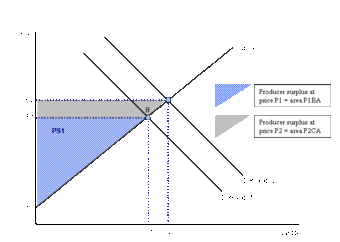
Producer Surplus and the Demand Curve
If the demand curve shifts out, producer surplus increases, as seen by size of the gray triangle.
Supply Curve
Similarly, shifts in the supply curve are also directly related to the amount of potential surplus. Decreases in the supply curve will cause decreases in producer surplus. Increases in the supply curve will cause increases in producer surplus.
At an initial supply represented by the “Supply (1)” curve, producer surplus is the blue triangle made of
,
, and
. If supply increases, represented by the “Supply (2)” curve, producer surplus is the larger gray triangle made of
,
, and
.
Price Elasticity of Supply
Price elasticity of supply is the relationship between price and quantity changes. It measures how quantity supplied is affected by changes in price. When supply is elastic, producers can increase production without much price or cost change. When supply is inelastic, producers cannot change production easily.
When supply is perfectly elastic, it is depicted as a horizontal line. Producer surplus is zero because the price is not flexible. Producers cannot provide a higher price than market price.
When supply is perfectly inelastic, it is depicted as a vertical line. Producer surplus is infinite because the price is completely flexible.
Chapter 3: Introducing Supply and Demand
3.1: Demand
3.1.1: The Law of Demand
In general, the law of demand states that the quantity demanded and the price of a good or service is inversely related, other things remaining constant.
Learning Objective
Explain the concept of demand and discuss the factors that affect it
Key Points
- The demand curve is downward sloping, indicating the negative relationship between the price of a product and the quantity demanded.
- For normal goods, a change in price will be reflected as a move along the demand curve while a non-price change will result in a shift of the demand curve.
- Two exceptions to the law of demand are Giffen goods and Veblen goods.
Key Terms
- Giffen good
-
A good which people consume more of as only the price rises; Having a positive price elasticity of demand.
- Veblen good
-
A good for which people’s preference for buying them increases as a direct function of their price, as greater price confers greater status.
- normal good
-
A good for which demand increases when income increases and falls when income decreases but price remains constant.
In economics, the law of demand states that the quantity demanded and the price of a good or service is inversely related, other things remaining constant. Therefore, the demand curve will generally be downward sloping, indicating the negative relationship between the price of a good or service and the quantity demanded.
Movement along the demand curve
If the income of the consumer, prices of the related goods, and preferences of the consumer remain unchanged, then the change in quantity of good demanded by the consumer will be negatively correlated to the change in the price of the good or service. The change in price will be reflected as a move along the demand curve.
Shift in the demand curve
The demand curve will shift, move either inward or outward as a result of non-price factors. A shift in demand can be related to the following factors (non-exhaustive list):
- Consumer preferences
- Consumer income
- Change in the price of related goods (i.e. compliments)
- Change in the number of buyers
- Consumer expectations

Law of Demand
A demand curve, shown in red and shifting to the right, demonstrating the inverse relationship between price and quantity demanded (the curve slopes downwards from left to right; higher prices reduce the quantity demanded).
Though in general terms and specific to normal goods, demand will exhibit a downward slope, there are exceptions: Giffen goods and Veblen goods
Giffen goods
A Giffen good describes an extreme case for an inferior good. In theory, a Giffen good would display the characteristic that as price increases, demand for the product increases. In the real world application, there has not been a
true
example of a Giffen good, though a popular albeit historically inaccurate example is the purchase of potatoes (an inferior good) as prices continued to increase during the Irish potato famine.
Veblen goods
Some expensive commodities like diamonds, expensive cars, designer clothing and other high-price limited items, are used as status symbols to display wealth. The more expensive these commodities become, the higher their value as a status symbol and the greater the demand for them. The amount demanded of these commodities increase with an increase in their price and decrease with a decrease in their price. These goods are known as a Veblen goods.
3.1.2: Demand Schedules and Demand Curves
A demand curve depicts the price and quantity combinations listed in a demand schedule.
Learning Objective
Describe the relationship between demand curves and demand schedules
Key Points
- Demand curves are a graphical representation of a demand schedule, which is the table view of an economic agents’ price to quantity relationship.
- Demand curves embody preferences, substitution potential and income, as well as other characteristics that influence an economic agent’s ability to assess willingness to pay at a specific point in time for goods and services.
- Demand curves may be linear or curved.
- Aggregate demand is the sum of the quantity demanded for a specific price over a group of economic agents.
Key Term
- equilibrium
-
The condition of a system in which competing influences are balanced, resulting in no net change.
The demand curve is a graphical representation depicting the relationship between a commodity’s different price levels and quantities which consumers are willing to buy. The curve can be derived from a demand schedule, which is essentially a table view of the price and quantity pairings that comprise the demand curve.
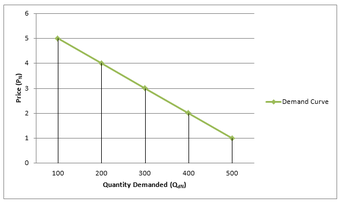
Demand Schedule and Curve
The demand curve is the graphical representation of the economic entity’s willingness to pay for a good or service. It is derived from a demand schedule, which is the table view of the price and quantity pairs that comprise the demand curve.
Given that in most cases, as the price of a good increases, agents will likely decrease consumption and substitute away to another good or service, the demand curve embodies a negative price to quantity relationship. The curve typically slopes downward from left to right; though there are some goods and services that exhibit an upward sloping demand, these goods and services are characterized as abnormal.
The demand curve of an individual agent can be combined with that of other economic agents to depict a market or aggregate demand curve. Using a demand schedule, the quantity demanded per each individual can be summed by price, resulting in an aggregate demand schedule that provides the total demanded specific to a given price level. The plotting of the aggregated quantity to price pairings is what is referred to as an aggregate demand curve. In this manner, the demand curve for all consumers together follows from the demand curve of every individual consumer.
The demand curve in combination with the supply curve provides the market clearing or equilibrium price and quantity relationship. This is found at the intersection or point at which the supply and demand curves cross each other.
3.1.3: Market Demand
Market demand is the summation of the individual quantities that consumers are willing to purchase at a given price.
Learning Objective
Examine the relationship between market demand and individual demand
Key Points
- The graphical representation of a market demand schedule is called the market demand curve.
- Following the law of demand, the demand curve is almost always represented as downward-sloping. This means that as price decreases, consumers will buy more of the good.
- Two different hypothetical types of goods with upward-sloping demand curves are Giffen goods and Veblen goods.
Key Term
- Market demand
-
The summation of the individual quantities that consumers are willing to purchase at a given price.
The demand schedule represents the amount of some good that a buyer is willing and able to purchase at various prices. The relationship between price and quantity demanded reflected in this schedule assumes the following factors remain constant:
- Income levels;
- Population;Tastes and preferences;
- Price of substitute goods; and
- Price of complementary goods
The demand schedule is depicted graphically as the demand curve. The demand curve is shaped by the law of demand. In general, this means that the demand curve is downward-sloping, which means that as the price of a good decreases, consumers will buy more of that good.

Demand Curve
The demand curve is the graphical depiction of the demand schedule. For most goods and services, the demand curve exhibits a negative relationship between price and quantity and is as a result downward sloping.
A market demand schedule is a table that lists the quantity of a good all consumers in a market will buy at every different price. A market demand schedule for a product indicates that there is an inverse relationship between price and quantity demanded. The graphical representation of a market demand schedule is called the market demand curve.
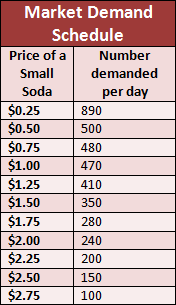
Market Demand Schedule
A market demand schedule is a table that lists the quantity of a good all consumers in a market will buy at every different price.
The determinants of demand are:
- Income
- Tastes and preferences
- Prices of related (AKA complimentary) goods and services
- Prices of substitues
- Number of potential consumers
The market demand is the summation of the individual quantities that consumers are willing to purchase at a given price.
As noted, both individual demand curves and market demand are typically expressed as downward shaping curves. However, special cases exist where the preference for the good or service may be perverse. Two different hypothetical types of goods with upward-sloping demand curves are Giffen goods (an inferior but staple good) and Veblen goods (goods characterized as being more desirable the higher the price; luxury or status items).
3.1.4: Ceteris Paribus
Ceteris paribus is defined as “all else being equal,” or “holding all else constant”.
Learning Objective
Explain the rationale for the assumption of ceteris paribus
Key Points
- When ceteris paribus is employed in economics, all other variables with the exception of the variables under evaluation are held constant.
- An example of the use of ceteris paribus in macroeconomics is: what would happen to the demand for labor by firms if a minimum wage was imposed at a level above the prevailing wage rate, ceteris paribus.
- An example of the use of ceteris paribus in microeconomics is: what would happen for the demand for a normal good when income increases, ceteris paribus.
Key Term
- ceteris paribus
-
all else equal; holding everything else constant
Economics seeks to interpret, analyze and or evaluate situations that occur between individuals, firms and other entities. Due to the potential for multiple agents and other known and unknown external activities to be involved or present but not relevant to an analysis, economics employs the assumption of “all else constant,” which is the English translation of the Latin phrase “ceteris paribus”.
When the ceteris paribus assumption is employed in economics, all other variables – with the exception of the variables under evaluation – are held constant.
A Macroeconomic Example
What would happen to the demand for labor by firms if a minimum wage was imposed at a level above the prevailing wage rate, ceteris paribus? As depicted in below, the supply and demand curve are held constant, as are labor and leisure preferences for workers, and output considerations for firms, in addition to all other variables and characteristics embedded within the shape of the supply and demand curves. Thus, what is being evaluated is the impact of a constraint on market equilibrium.

Macroeconomics: Binding price floor
E is the equilibrium wage level when there is no binding minimum wage. When a minimum wage is imposed, ceteris paribus, suppliers of labor are willing to provide more labor than firms (demand for labor) are willing to purchase at the binding minimum wage rate. There is no shifting of either curve related to behavior influenced by the higher wage rate because ceteris paribus is holding labor-leisure trade-off (of workers) and substitution of labor (by firms) constant, along with other potential influencing variables.
A Microeconomic Example
What would happen for the demand for a normal good when income increases, ceteris paribus? In this case, as depicted in , a consumer’s preferences for the good and his demand for complements and substitutes are being held constant along with other attributes that could potentially impact his demand for a good, such as the good’s price. The supply of the good and the market and firm characteristics implicit in the shape of the supply curve are also held constant. This allows for an analysis of the increase in income, on the consumer’s demand for the single good alone.

Microeconomics: Income and Demand
A consumer is able to purchase a normal good and has a demand curve, D1, which provides the relationship between price and quantity given his preferences, income and other consumption attributes. Assuming an increase in his income, ceteris paribus, his demand curve would shift outward to D2, corresponding to a higher quantity for each purchase price. The consumer would then move his consumption for the good from Q1 to Q2, increasing his purchase of the good.
3.1.5: Changes in Demand and Shifts in the Demand Curve
Demand is the relationship between the willingness to purchase a quantity of a good or service at a specific price.
Learning Objective
Distinguish between shifts in the demand curve and movement along the demand curve
Key Points
- A change in price will result in a movement along a demand curve.
- A change in a non-price variable will result in a shift in the demand curve.
- An outward shift in demand will occur if income increases, in the case of a normal good; however, for an inferior good, the demand curve will shift inward noting that the consumer only purchases the good as a result of an income constraint on the purchase of a preferred good.
Key Terms
- normal good
-
A good for which demand increases when income increases and falls when income decreases but price remains constant.
- inferior good
-
a good that decreases in demand when consumer income rises; having a negative income elasticity of demand.
The demand curve is a graphical representation of an economic agent’s willingness to purchase a given quantity of a good or service at a specific price based on preferences, income, and other prevailing factors at a given point in time. Demand curves in combination with supply curves, which depict the price to quantity relationship of producers, are a representation of the goods and services market. Where the two curves intersect is market equilibrium, the price to quantity relationship where demand and supply are equal.
Movements in demand are specific to either movements along a given demand curve or shifts of the entire demand curve.
Movements along the demand curve are due to a change in the price of a good, holding constant other variables, such as the price of a substitute. If the price of a good or service changes the consumer will adjust the quantity demanded based on the preferences, income and prices of other factors embedded within a given curve for the time period under consideration.
Shifts in the demand curve are related to non-price events that include income, preferences and the price of substitutes and complements. An increase in income will cause an outward shift in demand (to the right) if the good or service assessed is a normal good or a good that is desirable and is therefore positively correlated with income. Alternatively, an increase in income could result in an inward shift of demand (to the left) if the good or service assessed is an inferior good or a good that is not desirable but is acceptable when the consumer is constrained by income .

Demand Curve
A demand curve provides an economic agent’s price to quantity relationship related to a specific good or service. Movements along a demand curve are related to a change in price, resulting in a change in quantity; shifts is demand (D1 to D2) are specific to changes in income, preferences, availability of substitutes and other factors.
A change in preferences could result in an increase (outward shift) or decrease (inward shift) in the quantity level desired for a specific price; while a change in the price of a substitute, could result in an outward shift if the price of the substitute increases and an inward shift if the substitute’s price decreases. The demand curve for a good will shift in parallel with a shift in the demand for a complement.
3.2: Supply
3.2.1: The Law of Supply
The law of supply states that there is a positive relationship between the quantity that suppliers are willing to sell and the price level.
Learning Objective
Explain the Law of Supply
Key Points
- Quantity supplied moves in the same direction as price.
- The supply curve is an upward sloping curve.
- Producers are willing to increase production at higher prices to increase profit.
Key Terms
- surplus
-
That which remains when use or need is satisfied, or when a limit is reached; excess; overplus.
- shortage
-
a lack or deficiency
- equilibrium
-
The condition of a system in which competing influences are balanced, resulting in no net change.
The law of supply is a fundamental principle of economic theory. It states that an increase in price will result in an increase in the quantity supplied, all else held constant.
An upward sloping supply curve, which is also the standard depiction of the supply curve, is the graphical representation of the law of supply. As the price of a good or service increases, the quantity that suppliers are willing to produce increases and this relationship is captured as a movement along the supply curve to a higher price and quantity combination.
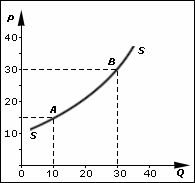
The Law of Supply
Supply has a positive correlation with price. As the market price of a good increases, suppliers of the good will typically seek to increase the quantity supplied to the market.
The rationale for the positive correlation between price and quantity supplied is based on the potential increase in profitability that occurs with an increase in price.
All else held constant, including the costs of production inputs, the supplier will be able to increase his return per unit of a good or service as the price for the item increases. Therefore, the net return to the supplier increases as the spread or difference between the price and the cost of the good or service being sold increases.
The law of supply in conjunction with the law of demand forms the basis for market conditions resulting in a price and quantity relationship at which both the price to quantity relationship of suppliers and demanders (consumers) are equal. This is also referred to as the equilibrium price and quantity and is depicted graphically at the point at which the demand and supply curve intersect or cross one another. It is the point where there is no surplus or shortage in the market .

Law of Supply and Law of Demand: Equilibrium
The law of supply and the law of demand form the foundation for the establishment of an equilibrium–where the price to quantity combination for both suppliers and demanders are the same.
3.2.2: Supply Schedules and Supply Curves
A supply schedule is a tabular depiction of the relationship between price and quantity supplied, represented graphically as a supply curve.
Learning Objective
Explain the price to quantity relationship exhibited in the supply curve
Key Points
- The supply curve plots the quantity that is willingly supplied at any given price.
- The individual supply curves can be summed by quantity provided at a specific price to achieve an aggregate supply curve.
- The supply curve is upward sloping in the short run.
Key Terms
- aggregate
-
A mass, assemblage, or sum of particulars; something consisting of elements but considered as a whole.
- equilibrium
-
The condition of a system in which competing influences are balanced, resulting in no net change.
Supply is the amount of some product that producers are willing and able to sell at a given price, all other factors being held constant. In general, supply depicts a positive relationship between the price of a good or service and the quantity that the producer is willing to supply: if a supplier believes it can sell the product for more, it will want to make more of the product. As a result, as the price of a good or service increases, suppliers increase the quantity available for purchase.
A supply schedule is a table that shows the relationship between the price of a good and the quantity supplied. The supply curve is a graphical depiction of the supply schedule that illustrates that relationship between the price of a good and the quantity supplied .
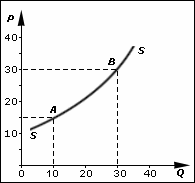
The Supply Schedule and Supply Curve
The supply curve is a graphical depiction of the price to quantity pairings presented in a supply schedule. The supply schedule is a table view of the relationship between the price suppliers are willing to sell a specific quantity of a good or service.
The supply curves of individual suppliers can be summed to determine aggregate supply. One can use the supply schedule to do this: for a given price, find the corresponding quantity supplied for each individual supply schedule and then sum these quantities to provide a group or aggregate supply. Plotting the summation of individual quantities per each price will produce an aggregate supply curve.
In theory, in the long run the aggregate supply curve will not be upward sloping but will instead be vertical, consistent with a fixed supply level. This is due to the underlying assumption that in the long run, supply of a good only depends on the fixed level of capital, technology, and natural resources available.
The supply curve provides one side of the price-to-quantity relationship that ensures a functional market. The other component is demand. When the supply and demand curves are graphed together they will intersect at a point that represents the market equilibrium – the point where supply equals demand and the market clears.
3.2.3: Market Supply
Market supply is the summation of the individual supply curves within a specific market where the market is characterized as being perfectly competitive.
Learning Objective
Identify the market conditions that yield a market supply curve.
Key Points
- A supply curve is the graphical representation of the supplier’s positive correlation between the price and quantity of a good or service.
- The supply curve can only be attributed to a depiction of a perfectly competitive market due to the unique attributes of perfect competition: firms are price takers, no single firm’s actions can influence the market price, and ease of exit and entry.
- The market supply curve is derived by summing the quantity for a given price across all market participants (suppliers). It depicts the price-to-quantity combinations available to consumers of the good or service.
Key Term
- Supply curve
-
A graphical representation of the quantity producers are willing to make when the product can be sold at a given price.
A supply curve is the graphical representation of the supplier’s positive correlation between the price and quantity of a good or service. As a result, the supply curve is upward sloping . Market supply is the summation of the individual supply curves within a specific market.
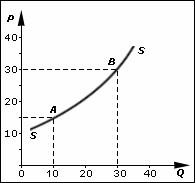
Market Supply
The market supply curve is an upward sloping curve depicting the positive relationship between price and quantity supplied.
The market supply curve is derived by summing the quantity suppliers are willing to produce when the product can be sold for a given price. As a result, it depicts the price to quantity combinations available to consumers of the good or service. In combination with market demand, the market supply curve is requisite for determining the market equilibrium price and quantity.
By its very nature, conceptualizing a supply curve requires the firm to be a perfect competitor, namely requires the firm to have no influence over the market price. This is true because each point on the supply curve is the answer to the question “If this firm is faced with this potential price, how much output will it be able to and willing to sell? ” If a firm has market power, its decision of how much output to provide to the market influences the market price, then the firm is not “faced with” any price, and the question is meaningless.
The attributes of a competitive market signal that the price is set external to any firm. Therefore, production in the market is a sliding scale dependent on price. As price increases, quantity increases due to low barriers to entry, and as the price falls, quantity decreases as some firms may even opt out of the market.
The supply curve can be derived by compiling the price-to-quantity relationship of a seller. A seller could set the price of a good or service equal to zero and then incrementally increase the price; at each price he could calculate the hypothetical quantity he would be willing to supply. Following this process the seller would be able to trace out its complete individual supply function. The market supply curve is simply the sum of every seller’s individual supply curve.
3.2.4: Determinants of Supply
Supply levels are determined by price, which increases or decreases supply along the price curve, and non-price factors, which shifts the entire curve.
Learning Objective
Identify the factors that affect the supply of a good
Key Points
- Supply is the quantity of a good or service that a supplier provides to the market.
- Suppliers will shift production for non-price changes related to the determinants of supply and will slide production levels across the supply curve for price related movements.
- Innumerable factors and circumstances could affect a seller’s willingness or ability to produce and sell a good.
Key Terms
- incentive
-
Something that motivates, rouses, or encourages.
- intervention
-
The action of interfering in some course of events.
Supply is the quantity of a good or service that a supplier provides to the market. Innumerable factors and circumstances could affect a seller’s willingness or ability to produce and sell a good. Some of the more common factors are:
- Good’s own price: An increase in price will induce an increase in the quantity supplied.
- Prices of related goods: For purposes of supply analysis, related goods refer to goods from which inputs are derived to be used in the production of the primary good.
- Conditions of production: The most significant factor here is the state of technology. If there is a technological advancement related to the production of the good, the supply increases.
- Expectations: Sellers’ expectations concerning future market conditions can directly affect supply.
- Price of inputs: If the price of inputs increases the supply curve will shift left as sellers are less willing or able to sell goods at any given price. Inputs include land, labor, energy and raw materials.
- Number of suppliers: As more firms enter the industry the market supply curve will shift out driving down prices. The market supply curve is the horizontal summation of the individual supply curves.
- Government policies and regulations: Government intervention can take many forms including environmental and health regulations, hour and wage laws, taxes, electrical and natural gas rates and zoning and land use regulations. These regulations can affect a good’s supply.
Suppliers will change their production levels along the supply curve in response to a price change, so that their production level is equal to demand. However, some factors unrelated to price can shift the production level. For example, a technological improvement that reduces the input cost of a product will shift the supply curve outward, allowing suppliers to provide a greater supply at the same price level.
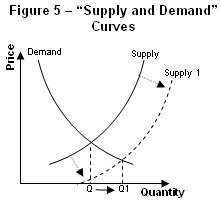
Determinants of Supply
If the price of a good changes, there will be movement along the supply curve. However, the supply curve itself may shift outward or inward in response to non-price related factors that affect the supply of a good, such as technological advances or increased cost of materials.
3.2.5: Changes in Supply and Shifts in the Supply Curve
The supply curve depicts the supplier’s positive relationship between price and quantity.
Learning Objective
Distinguish between shifts in the supply curve and movement along the supply curve
Key Points
- A change in the price of a good or service, holding all else constant, will result in a movement along the supply curve.
- A change in the cost of an input will impact the cost of producing a good and will result in a shift in supply; supply will shift outward if costs decrease and will shift inward if they increase.
- A change in the expected demand for a good or service will result in a shift in supply; supply will shift outward if enthusiasm is expected to increase and will shift inward if there is an expectation for consumers preferences to change in favor of an alternate good or service.
Key Term
- Non-price changes
-
Shocks, either exogenous or endogenous, that affect the positioning of the supply curve.
Price changes and movement along supply curve
If the price of the good or service changes, all else held constant such as price of substitutes, the supplier will adjust the quantity supplied to the level that is consistent with its willingness to accept the prevailing price. The change in price will result in a movement along the supply curve, called a change in quantity supplied, but not a shift in the supply curve. Changes in supply are due to non-price changes.
Non-price changes and shifts of the supply curve
If production costs increase, the supplier will face increasing costs for each quantity level. Holding all else the same, the supply curve would shift inward (to the left), reflecting the increased cost of production. The supplier will supply less at each quantity level.
If production costs declined, the opposite would be true. Lower costs would result in an increase in output, shifting the supply curve outward (to the right) and the supplier will be willing sell a larger quantity at each price level. The supply curve will shift in relation to technological improvements and expectations of market behavior in very much the same way described for production costs.
Technological improvements that result in an increase in production for a set amount of inputs would result in an outward shift in supply.
Supply will shift outward in response to indications of heightened consumer enthusiasm or preference and will respond by shifting inward if there is an assessment of a negative impact to production costs or demand .
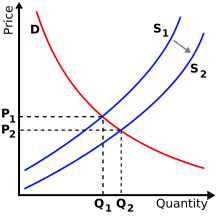
Supply Shifts
A shift in supply from S1 to S2 affects the equilibrium point, and could be caused by shocks such as changes in consumer preferences or technological improvements.
3.3: Market Equilibrium
3.3.1: Clearing the Market at Equilibrium Price and Quantity
When a market achieves perfect equilibrium there is no excess supply or demand, which theoretically results in a market clearing.
Learning Objective
Define market equilibrium
Key Points
- The interdependent relationship between supply and demand in the field of economics is inherently designed to identify the ideal price and quantity of a given product or service in a marketplace.
- A market clearing, by definition, is the economic assumption that the quantity supplied will consistently align with the quantity demanded.
- Market clearing requires a variety of assumptions which simplify the complexities of real markets to coincide with a more theoretical framework, most centrally the assumptions of perfect competition and Say’s Law.
- While this concept of market clearing resonates well in theory, the actual execution of markets is very rarely perfect. The concepts of consolidated markets and ‘sticky’ markets reduces the accuracy of these models.
Key Terms
- Say’s Law
-
The idea that money is perishable.
- Incumbents
-
A holder of a position as supplier to a market or market segment that allows the holder to earn above-normal profits.
- Opportunity cost
-
The cost of an opportunity forgone (and the loss of the benefits that could be received from that opportunity); the most valuable forgone alternative.
Example
- A textbook example of a monopoly was the Da Beers family, who owned the vast majority of diamond mines worldwide. Through effectively controlling the diamond market supply (via owning the mines), and warehousing the diamonds in a way to substantially alter the available supply, it became reasonably easy for Da Beers to charge prices in excess of what a reasonable equilibrium would be.
The interdependent relationship between supply and demand in the field of economics is inherently designed to identify the ideal price and quantity of a given product or service in a marketplace. This equilibrium point is represented by the intersection of a downward sloping demand line and an upward sloping supply line, with price as the y-axis and quantity as the x-axis . At perfect equilibrium there is no excess demand (represented by ‘A’ in the figure) or excess supply (represented by ‘B’ in the figure), which theoretically results in a market clearing.
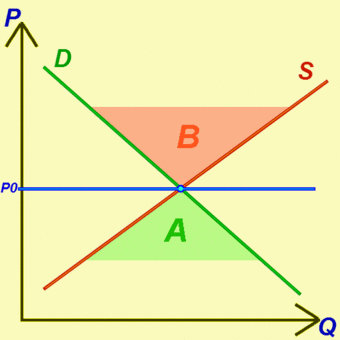
Equilibrium Pricing
This chart effectively highlights the various basic implications of a simple supply and demand chart. The equilibrium point is where market clearing will theoretically occur.
Market Clearing Assumptions
A market clearing, by definition, is the economic assumption that the quantity supplied will consistently align with the quantity demanded. This definition requires a variety of assumptions which simplify the complexities of real markets to coincide with a more theoretical framework, most centrally the assumptions of perfect competition and Say’s Law:
- Perfect competition is a market where the price determined for a given good or service is not affected by external forces or competition in a way that allows incumbents (companies) to attain market influence.
- Say’s Law hinges on the concept that capital loses value over time, or that money is essentially perishable. The simplest way to view this law is interest rates. When you invest or owe money, that capital accrues interest due to the fact that there is an opportunity cost in not investing that money elsewhere. This opportunity cost creates the assumption that money will not go unused.
Combining these two assumptions, in a perfectly competitive market the amount of a product or service that is supplied at a given price will equate to the amount demanded, clearing the market of all goods/services at a given equilibrium point.
Theory and Practice
While this concept of market clearing resonates well in theory, the actual execution of markets is very rarely perfect. Markets demonstrate consistent shifts of supply and shifts of demand based on a wide spectrum of externalities. Even in static markets there is competitive consolidation that allows companies to charge differing price points than that of the equilibrium. The concept of monopolies provides a good example for this experience, as monopolies (see example) can control price and quantity simultaneously.
Another classic criticism of market clearing is the way in which the labor market functions. In the 1930’s, during the worst depression recorded in the United States, the labor market did not clear the way economic theories of market clearing would assume it would. Instead, there seemed to be what John Maynard-Keynes (father of Keynesian Economics) called ‘stickiness,’ which preventing the market from normalizing. The importance of raising these concerns is the understanding that while the concept of market clearing, equilibrium and supply/demand charts are highly useful in understanding the basic functioning of markets, reality does not always conform with these models.
3.3.2: Impacts of Surpluses and Shortages on Market Equilibrium
The existence of surpluses or shortages in supply will result in disequilibrium, or a lack of balance between supply and demand levels.
Learning Objective
Infer the outcomes of departures from equilibrium using the model of supply and demand
Key Points
- Surpluses, or excess supply, essentially indicates that the quantity of a good or service exceeds the demand for that particular good at the price in which the producers would wish to sell (equilibrium level).
- In a perfectly competitive market, excess supply is equivalent to the quantity available in the market beyond the equilibrium point of intersection between supply and demand. This will result in a shift in market equilibrium towards lower price points.
- Shortage is a term used to indicate that the supply produced is below that of the quantity being demanded by the consumers. This disparity implies that the current market equilibrium at a given price is unfit for the current supply and demand relationship.
- In a perfectly competitive market, a shortage in supply will ultimately result in a shift in the equilibrium point, transitioning towards a higher price point due to the limited supply availability.
Key Terms
- Disequilibrium
-
The loss of equilibrium or stability, especially due to an imbalance of forces.
- surplus
-
That which remains when use or need is satisfied, or when a limit is reached.
- shortage
-
Not enough or not sufficient for a given demand.
In the analysis of market equilibrium, specifically for pricing and volume determinations, a thorough understanding of the supply and demand inputs is critical to economics. Surpluses and shortages on the supply end can have substantial impacts on both the pricing of a specific product or service, alongside the overall quantity sold over time. Shifts such as these in the supply availability results in disequilibrium, or essentially a lack of balance between current supply and demand levels. Surpluses and shortages often result in market inefficiencies due to a shifting market equilibrium.
Surpluses
Surpluses, or excess supply, indicate that the quantity of a good or service exceeds the demand for that particular good at the price in which the producers would wish to sell (equilibrium level). This inefficiency is heavily correlated in circumstances where the price of a good is set too high, resulting in a diminished demand while the quantity available gains excess. There are substantial business risks inherently built into the concept of surpluses, as the general outcome will be either selling off inventory at sub-par prices or leftover unsold inventory. In both scenarios businesses will be forced to minimize margins or incorporate losses on that particular good. Governmental intervention can often create surplus as well, particularly through the utilization of a price floor if it is set at a price above the market equilibrium .
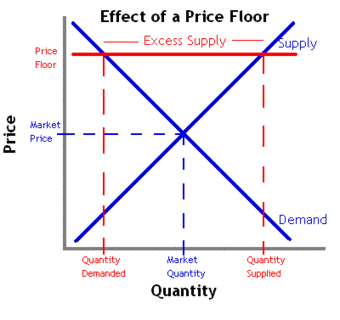
Price Floor
A price floor ensures a minimum price is charged for a specific good, often higher than that what the previous market equilibrium determined. This can result in a surplus.
In a perfectly competitive market, particularly pertaining to goods that are not perishable, excess supply is equivalent to the quantity available in the market beyond the equilibrium point of intersection between supply and demand. In this theoretical scenario the equilibrium point will transition towards a lower price point due to the increased supply, which will in turn motivate consumers to purchase a higher quantity as a result. This allows the economic model of the market to correct itself.
Shortages
Inversely, shortage is a term used to indicate that the supply produced is below that of the quantity being demanded by the consumers. This disparity implies that the current market equilibrium at a given price is unfit for the current supply and demand relationship, noting that the price is set too low. It could also indicate that the desired good has a low level of affordability by the general public, and can be a dangerous societal risk for necessary commodities. Indeed, Garrett Hardin emphasized that a shortage of supply could also be perceived as a ‘longage’ of demand, as the two are inversely related. From this vantage point shortages can be attributed to population growth as much as resource scarcity.
In a perfectly competitive market, a shortage in supply will ultimately result in a shift in the equilibrium point, transitioning towards a higher price point due to the limited supply availability. This will prioritize who receives the good or service based upon their willingness and ability to pay a premium for the specific item in demand, leveraging those along the demand curve who are at higher levels with higher ability and willingness to pay.
3.3.3: Changes in Demand and Supply and Impacts on Equilibrium
Alterations to overall supply or demand dictate the cross-section or equilibrium, ascertaining price and volume for a product or service.
Learning Objective
Illustrate how changes in supply or demand impact the market equilibrium
Key Points
- The interdependent relationship between the supply of a given product or service and the overall demand exercised by interested parties generates a theoretical equilibrium point, dictating the average market price and purchase volume relative to that price.
- Markets are in constant flux as demands and supplies are subjected to varying driving forces and influences. These shifts play a critical role, altering market equilibrium price points and volumes for products and services.
- Demand shifts can be caused by a wide variety of factors, but largely revolve around drivers of consumer behavior and circumstances.
- Supply shifts, similar to demand shifts, can ultimately be a result of a wide variety of externalities. Scarcity, or the lack of availability for a particular material, is a core driving force for overall supply.
- Due to a demand curve’s sloping downward and a supply curve’s sloping upwards, the curves will eventually cross at some point on any supply/demand chart. This point of equilibrium serves as a price and quantity tracking point.
Key Terms
- equilibrium
-
A condition in which competing forces are in balance.
- scarcity
-
An insufficiency or lack of availability; a shortage.
The interdependent relationship between the supply of a given product or service and the overall demand exercised by interested parties generates a theoretical equilibrium point, dictating the average market price and purchased volume relative to that price. In a static market it would be reasonable to assume that prices and volumes would remain fairly predictable and consistent relative to the population, but realistic markets are not static. Instead, markets are in constant flux as demands and supplies are subjected to varying driving forces and influences. These shifts play a critical role in altering market equilibrium price points and volumes for products and services, requiring constant vigilance and adaptation by providers and consumers. To better understand market variations, it is useful to examine how changes in supply and demand may occur, as well as the impacts and implications of these changes.
Demand Shifts
Demand shifts are defined by more or less of a given product or service being required at a fixed price, resulting in a shift of both price and quantity. As would be assumed, an increase in demand will shift price upwards and volume to the right, increasing the overall value of both metrics relative to the prior equilibrium point . Alternately, a decrease in demand will shift price downwards and volume to the left, decreasing both measurements to realign equilibrium with a reduced demand.

Demand Shifts
In this graph, the demand curve (red) has been affected by an increase in demand. This consequently increases price at a given volume.
Demand shifts can be caused by a wide variety of factors, but largely revolve around drivers of consumer behavior and circumstances. Demand shifts can therefore often be affected by economic factors such as average spending power per person in a given economy or overall average income. Demand can also be affected by cultural changes, demographic shifts, availability of substitutes, environmental factors and concerns (e.g. climate change), politics, and advances in science (e.g. declining demand for unhealthy foods). Demand is particularly malleable in respect to goods that are not necessities, thus are desired or not based upon sociological norms.
Supply Shifts
Supply shifts are defined by more or less of a particular product/service being available to fulfill a given demand, affecting the equilibrium point by shifting the supply curve upwards or downwards. A supply shift to the right, indicating more availability of the specified product or service, will create a lower price point and a higher volume assuming a fixed demand. Alternately, a decrease in supply with a consistent given demand will see an increase in price and a decrease in quantity. This is an intuitive theory underlining the fact that scarcity is relevant to the willingness to pay.
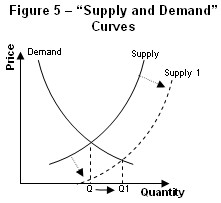
Supply Shifts
In this supply and demand chart we see an increase in the supply provided, shifting quantity to the right and price down. More of a given product, assuming the same demand, will result in lower price points at the equilibrium.
Supply shifts, similar to demand shifts, can ultimately be a result of a wide variety of external factors. As discussed above, scarcity plays a critical role in pricing and thus controlling supply is often even considered a strategic play by companies in specific industries (most notably industries like precious stones, rare earth metals, etc.). Supply shifts can also be a result of technological advances, over-utilization or consumption, globalization, supply-chain efficiency, and economics. For example, the discovery of a new gold deposit, acts as a shock to the supply of gold, shifting the curve right.
Equilibrium
In combining these two potential shifts, equilibrium is constantly subjected to both factors resulting in supply shifts and factors resulting in demand shifts. Due to the demand curve sloping downward and the supply curve sloping upwards, they inadvertently will cross at some given point on any supply/demand chart. This cross-section, or equilibrium, serves as a price and quantity tracking point based upon the consistent inputs of overall demand and supply availability. Any change in either factor will result in immediate impact on equilibrium, balancing the new demand or supply with a corresponding volume and appropriate average price point.
3.4: Government Intervention and Disequilibrium
3.4.1: Why Governments Intervene In Markets
Governments intervene in markets when they inefficiently allocate resources.
Learning Objective
Identify reasons why the government might choose to intervene in markets.
Key Points
- The government tries to combat market inequities through regulation, taxation, and subsidies.
- Governments may also intervene in markets to promote general economic fairness.
- Maximizing social welfare is one of the most common and best understood reasons for government intervention. Examples of this include breaking up monopolies and regulating negative externalities like pollution.
- Governments may sometimes intervene in markets to promote other goals, such as national unity and advancement.
Key Term
- inefficient market
-
An economy where social optimality is not acheived; an economy where resources are not optimally allocated
Governments intervene in markets to address inefficiency. In an optimally efficient market, resources are perfectly allocated to those that need them in the amounts they need. In inefficient markets that is not the case; some may have too much of a resource while others do not have enough. Inefficiency can take many different forms. The government tries to combat these inequities through regulation, taxation, and subsidies. Most governments have any combination of four different objectives when they intervene in the market.
Maximizing Social Welfare
In an unregulated inefficient market, cartels and other types of organizations can wield monopolistic power, raising entry costs and limiting the development of infrastructure. Without regulation, businesses can produce negative externalities without consequence. This all leads to diminished resources, stifled innovation, and minimized trade and its corresponding benefits. Government intervention through regulation can directly address these issues.
Another example of intervention to promote social welfare involves public goods. Certain depletable goods, like public parks, aren’t owned by an individual. This means that no price is assigned to the use of that good and everyone can use it. As a result, it is very easy for these assets to be depleted. Governments intervene to ensure those resources are not depleted.
Macro-Economic Factors
Governments also intervene to minimize the damage caused by naturally occurring economic events. Recessions and inflation are part of the natural business cycle but can have a devastating effect on citizens. In these cases, governments intervene through subsidies and manipulation of the money supply to minimize the harsh impact of economic forces on its constituents.
Socio-Economic Factors
Governments may also intervene in markets to promote general economic fairness . Government often try, through taxation and welfare programs, to reallocate financial resources from the wealthy to those that are most in need. Other examples of market intervention for socio-economic reasons include employment laws to protect certain segments of the population and the regulation of the manufacture of certain products to ensure the health and well-being of consumers.

Former President Bill Clinton signing welfare reform
Former President signing a welfare reform bill. Welfare programs are one way governments intervene in markets.
Other Objectives
Governments can sometimes intervene in markets to promote other goals, such as national unity and advancement. Most people agree that governments should provide a military for the protection of its citizens, and this can be seen as a type of intervention. Growing a large and impressive military not only increases a country’s security, but may also be a source of pride. Intervening in a way that promotes national unity and pride can be an extremely valuable goal for government officials.
3.4.2: Price Ceilings
A price ceiling is a price control that limits how high a price can be charged for a good or service.
Learning Objective
Define price ceilings.
Key Points
- For a price ceiling to be effective, it must be less than the free-market equilibrium price.
- The purpose of a price ceiling is to protect consumers of a certain good or service. By establishing a maximum price, a government wants to ensure the good is affordable for as many consumers as possible.
- Rent control is an example of a price ceiling.
Key Terms
- free-market equilibrium price
-
The price established through competition such that the amount of goods or services sought by buyers is equal to the amount of goods or services produced by sellers
- Price ceiling
-
An artificially set maximum price in a market.
A price ceiling is a price control that limits the maximum price that can be charged for a product or service. Generally ceilings are set by governments, although groups that manage exchanges can set ceilings as well. The purpose of a price ceiling is to protect consumers of a certain good or service. By establishing a minimum price, a government wants to ensure the good is affordable for as many consumers as possible .
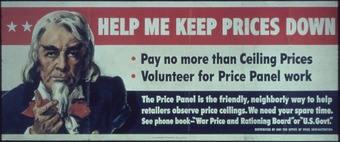
US Poster for Price Ceilings
Governments often impose price ceilings in times of war to ensure goods are available to as many people as possible.
An example of a price ceiling is rent control. These regulations require a more gradual increase in rent prices than what the market may demand. This regulation is meant to protect current tenants. Without rent control, there could be situations where the demand for housing in an area could cause rent prices to make a substantial jump. Unable to afford the new, significantly higher rent, a majority of the neighborhood’s tenants may be forced to move out of the neighborhood. Rent controls limit the possibility of tenant displacement by minimizing the amount by which rent can be increased.
By definition, however, price ceilings disrupt the market. By setting a maximum price, any market in which the equilibrium price is above the price ceiling is inefficient. There will be excess demand because the price cannot increase enough to clear the excess.
For a price ceiling to be effective, it must be less than the free-market equilibrium price. This is the price established through competition such that the amount of goods or services sought by buyers is equal to the amount of goods or services produced by sellers. It is also the price that the market will naturally set for a given good or service. If the price ceiling is higher than what the market would already charge, the regulation would not be effective. As a result, a government will do significant research into the current market conditions for a good before setting a price ceiling.
3.4.3: Price Ceiling Impact on Market Outcome
A binding price ceiling will create a surplus of supply and will lead to a decrease in economic surplus.
Learning Objective
Explain how price controls lead to economic inefficiency
Key Points
- A price ceiling has an economic impact only if it is less than the free-market equilibrium price.
- An effective price ceiling will lower the price of a good, which decreases the producer surplus. The effective price ceiling will also decrease the price for consumers, but any benefit gained from that will be minimized by the decreased sales due to the drop in supply caused by the lower price.
- If a ceiling is to be imposed for a long period of time, a government may need to ration the good to ensure availability for the greatest number of consumers.
- Prolonged shortages caused by price ceilings can create black markets for that good.
Key Terms
- Price ceiling
-
An artificially set maximum price in a market.
- black market
-
trade that is in violation of restrictions, rationing or price controls
A price ceiling will only impact the market if the ceiling is set below the free-market equilibrium price. This is because a price ceiling above the equilibrium price will lead to the product being sold at the equilibrium price.If the ceiling is less than the economic price, the immediate result will be a supply shortage. As you can see from the chart below, a lower base price means less of a good will be produced. The quantity demanded will increase because more people will be willing to pay the lower price to get the good while producers will be willing to supply less, leading to a shortage.

Price Ceiling Chart
If a price ceiling is set below the free-market equilibrium price (as shown where the supply and demand curves intersect), the result will be a shortage of the good in the market. The dead weight loss, represented in yellow, is the minimum dead weight loss in such a scenario. If individuals who value the good most are not capable of purchasing it, there is a potential for a higher amount of dead weight loss.
A price ceiling will also lead to a more inefficient market and a decreased total economic surplus. Economic surplus, or total welfare, is the sum of consumer and producer surplus. Consumer surplus is the monetary gain obtained by consumers because they are able to purchase a product for a price that is less than the highest that they are willing pay. Producer surplus is the amount that producers benefit by selling at a market price that is higher than the least they would be willing to sell for. An effective price ceiling will lower the price of a good, which means that the the producer surplus will decrease. While the effective price ceiling will also decrease the price for consumers, any benefit gained from that will be minimized by decreased sales caused by decreased available supply for sale from producers due to the decrease in price. This translates into a net decrease total economic surplus, otherwise known as deadweight loss. This loss is signified in the attached chart as the yellow triangle.
Rationing
If a ceiling is to be imposed for a long period of time, a government may need to ration the good to ensure availability for the greatest number of consumers. One way the government may ration the good is to issue ticket to consumers. A government will only allow as much of good to be out in the marketplace as there are available tickets. To obtain the good, the consumer must present the ticket and the money to the vendor when making the purchase. This is generally considered a fair way to minimize the impact of a shortage caused by a ceiling, but is generally reserved for times of war or severe economic distress.
Black Market
Prolonged shortages caused by price ceilings can create black markets for that good. A black market is an underground network of producers that will sell consumers as much of a controlled good as they want, but at a price higher than the price ceiling. Black markets are generally illegal. However these markets provide higher profits for producers and more of a good for a consumers, so many are willing to take the risk of fines or imprisonment.
3.4.4: Price Floors
A binding price floor is a price control that limits how low a price can be charged for a product or service.
Learning Objective
Define Price Floors.
Key Points
- For a price floor to be affect the market, it must be greater than the free-market equilibrium price.
- Price floors above the equilibrium price will induce a surplus.
- The federal minimum wage is an example of a price floor.
Key Terms
- free-market equilibrium price
-
The price established through competition such that the amount of goods or services sought by buyers is equal to the amount of goods or services produced by sellers
- price floor
-
A mandated minimum price for a product in a market.
A price floor is a price control that limits how low a price can be charged for a product or service. Generally floors are set by governments, although groups that manage exchanges can set price floors as well. The purpose of a price floor is to protect producers of a certain good or service. By establishing a minimum price, a government seeks to promote the production of the good or service and ensure that the producers have sufficient resources to go about their work.
For a price floor to be effective, it must be greater than the free-market equilibrium price. This is the price established through competition such that the amount of goods or services sought by buyers is equal to the amount of goods or services produced by sellers. It is also the price that the market will naturally set for a given good or service. If the price floor is lower than what the market would already charge, the regulation would serve no purpose. Since the price is set artificially high, there will be a surplus: there will be a higher quantity supplied and a lower quantity demanded than in a free market . As a result, a government will generally do significant research into the current market conditions for a good or service before setting a price floor.
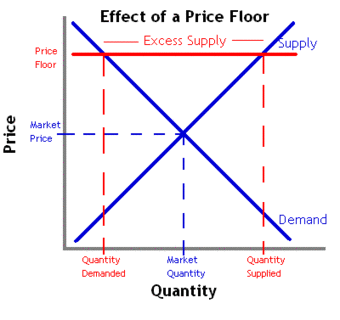
Price Floor
If a price floor is set above the equilibrium price, consumers will demand less and producers will supply more.
An example of a price floor is the federal minimum wage. In this case the suppliers are employees and employers are the consumers. The federal government has established a price that all employers must pay their workers. Obviously employers can pay more than that amount, but they cannot pay less. The purpose of setting this floor is to ensure that all employees make enough money from their jobs to provide for their basic needs.

History of the Federal Minimum Wage
History of the federal minimum wage in real and nominal dollars. The federal minimum wage is one example of a price floor.
3.4.5: Price Floor Impact on Market Outcome
Binding price floors typically cause excess supply and decreased total economic surplus.
Learning Objective
Show how price floors contribute to market inefficiency
Key Points
- A price floor is economically consequential if it is greater than the free-market equilibrium price.
- Price floors lead to a surplus of the product.
- Supply surplusses created by price floors are generally added to producer’s inventory or are purchased by governments.
- Consumer surplus is the gain obtained by consumers because they can obtain a product for a lower price than they would be willing to pay.
- Producer surplus is the benefit producers get by selling at a price higher than the lowest price they would sell for.
Key Terms
- free-market equilibrium price
-
The price established through competition such that the amount of goods or services sought by buyers is equal to the amount of goods or services produced by sellers
- price floor
-
A mandated minimum price for a product in a market.
A price floor will only impact the market if it is greater than the free-market equilibrium price. If the floor is greater than the economic price, the immediate result will be a supply surplus. As you can see from , a higher base price will lead to a higher quantity supplied. However, quantity demand will decrease because fewer people will be willing to pay the higher price. This will lead to a surplus of supply.

Surplus from a price floor
If a price floor is set above the free-market equilibrium price (as shown where the supply and demand curves intersect), the result will be a surplus of the good in the market.
A price floor will also lead to a more inefficient market and a decreased total economic surplus. Economic surplus, or total welfare, is the sum of consumer and producer surplus. Consumer surplus is the monetary gain obtained by consumers because they are able to purchase a product for a price that is less than the highest that they are willing pay. Producer surplus is the amount that producers benefit by selling at a market price that is higher than the least they would be willing to sell for. An effective price floor will raise the price of a good, which means that the the consumer surplus will decrease. While the effective price floor will also increase the price for producers, any benefit gained from that will be minimized by decreased sales caused by decreased demand from consumers due to the increase in price. This translates into a net decrease total economic surplus, otherwise known as deadweight loss.
Since well designed price floors create surpluses, the big issue is what to do with the excess supply. The first option is to let inventories grow and have the private producers bear the cost of storing it. The other option is for the government that set the price floor to purchase the excess supply and store it on its own. The government could then sell the surplus off at a loss in times of a food shortage.
3.4.6: Introduction to Deadweight Loss
Deadweight loss is the decrease in economic efficiency that occurs when a good or service is not priced at its pareto optimal level.
Learning Objective
Define deadweight loss
Key Points
- Deadweight loss can be caused by monopolies, binding price controls, taxes, subsidies, and externalities.
- When deadweight loss occurs, it comes at the expense of consumer surplus and/or producer surplus.
- Deadweight loss can be visually represented on supply and demand graphs as a figure known as Harberger’s triangle.
Key Terms
- Pareto optimal
-
Describing a situation in which the profit of one party cannot be increased without reducing the profit of another.
- deadweight loss
-
A loss of economic efficiency that can occur when an equilibrium is not Pareto optimal.
Deadweight loss is the decrease in economic efficiency that occurs when a good or service is not priced and produced at its pareto optimal level. When output is at its pareto optimal point, the price, production, and consumption of a good cannot be altered for one person’s benefit without making at least one other worse off. In a perfectly competitive market, products are priced at the pareto optimal point.
When deadweight loss occurs, it comes at the expense of either the consumer economic surplus or the producer’s economic surplus. Consumer surplus is the gain that consumers receive when they are able to purchase a product for less than the price they are willing to pay; producer surplus is the benefit producers receive when the sell a product for more than they are willing to sell for. While price controls, subsidies and other forms of market intervention might increase consumer or producer surplus, economic theory states that any gain would be outweighed by the losses sustained by the other side. This net harm is what causes deadweight loss.
Deadweight loss can be visually represented on supply and demand graphs . Known as Harberger’s triangle, the deadweight loss equals the area within the following three points:

Deadweight loss
This chart illustrates the deadweight loss created when a price floor is instituted on the market for a good. The amount of deadweight loss is shown by the triangle highlighted in yellow. This area is known as Harberger’s triangle.
- where the supply and demand curve intersect, otherwise known as the free market equilibrium;
- the point on the supply curve where the y-coordinate equals the non-pareto optimal price;
- the point on the demand curve where the y-coordinate equals the non-pareto optimal price.
Example – Price Ceilings and Deadweight Loss
The chart above shows what happens when a market has a binding price ceiling below the free market price. Without the price ceiling, the producer surplus on the chart would be everything to the left of the supply curve and below the horizontal line where y equals the free market equilibrium price. The consumer surplus would equal everything to the left of the demand curve and above the free market equilibrium price line.
With the price ceiling, instead of the producer’s surplus going all the way to the pareto optimal price line, it only goes as high as the price ceiling.The consumer surplus extends down to the price ceiling, but it is limited on the right by Harberger’s triangle. In this case, the reason for that limitation is due to quantity produced. The consumer would purchaser more of the product at the ceiling price, but the producers are unwilling to supply enough to meet that demand because it is not profitable. As a result all of the goods that might have been produced and consumed if the good was priced optimally are not, representing a net loss for society.
3.4.7: Arguments for and Against Government Price Controls
Many argue that price controls ensure resource availability, but most economists agree that these controls should be used sparingly.
Learning Objective
Justify the use of price controls when certain conditions are met
Key Points
- The main appeal of governmental imposed price controls is that they can ensure that citizens can purchase what they need in times of national economic hardship.
- Well designed price controls can ensure that basic staples are affordable, minimize the possibility of shortages, and prevent price gouging when shortages occur.
- By keeping prices artificially low through price ceilings, economists argue that demand is increased to a point where supply cannot keep up, leading to a shortage in the controlled product.
- Price floors often lead to surpluses, which can be just as detrimental as a shortage.
Key Terms
- Price control
-
A law that sets the maximum or minimum amount for which a good may be sold.
- staple
-
A basic or essential supply.
When unemployment is especially high or when there is a shortage of goods, it can be difficult for people to get what they need at an affordable price. The main appeal of government imposed price controls is that they can ensure that citizens can purchase what they need in times of national economic hardship .
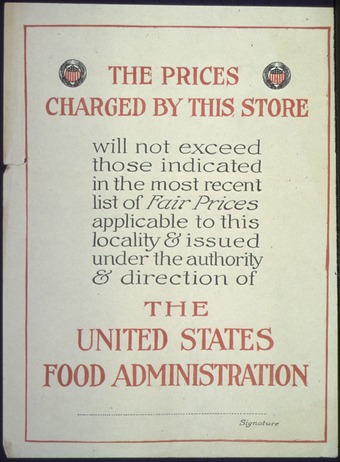
USFA Depression Price Fixing Poster
During the depression the US government fixed prices on basic staples, such as food, to ensure people would be able to obtain their basic necessities.
Well designed price controls can do three things. First, these regulations can ensure that a basic staple, such as food, remains affordable to most of a country’s citizens. Second, regulation can protect the producers of a good and ensure that they get sufficient revenue. This in turn limits the possibility of shortages, which benefits consumer. Finally, when shortages occur, price controls can prevent producers from gouging their customers on price.
Generally price controls are used in combination with other forms of government economic intervention, such as wage controls and other regulatory elements.
While price controls may appear to be a sound decision in theory, most economists believe these controls should be used sparingly. By keeping prices artificially low through price ceilings, consumers demand a higher quantity than producers are willing to supply, leading to a shortage in the controlled product. As Nobel Prize winner Milton Friedman said, “We economists do not know much, but we do know how to create a shortage. If you want to create a shortage of tomatoes, for example, just pass a law that retailers can’t sell tomatoes for more than two cents per pound. Instantly you’ll have a tomato shortage. “
Price floors often lead to surpluses, which can be just as detrimental as a shortage. One of the best known price floors in the minimum wage, which establishes a base line per hour wage that must be paid for work. As a result, employers hire fewer employees than they would if they could pay workers lower than the minimum wage. As a result the supply of workers is greater than the amount of work, which creates higher unemployment.
3.4.8: Taxes
Governments use its tax systems to raise funds for its programs and influence its citizens’ economic actions.
Learning Objective
Categorize types of taxes into ad valorem taxes and excise taxes
Key Points
- A good tax system should be efficient, understandable and equitable. It should also allocate the costs of public services to those who use it, although that principle is hard to execute in practice.
- A direct tax is assessed on a person’s income. Indirect taxes are assessed on an individual’s participation in certain activities, such as making a purchase.
- The three types of tax systems are proportional, progressive, and regressive.
- Ad valorem and excise taxes are two types of indirect taxes.
Key Terms
- progressive
-
Increasing in rate as the taxable amount increases
- regressive
-
Whose rate decreases as the amount increases.
Taxes are the primary means for governments to raise funds for its programs and to pay off its debts. It can also be used to influence its citizens’ financial behavior. . Choosing the right set of rules that have all of the elements of a good tax system can be a challenge for any government.
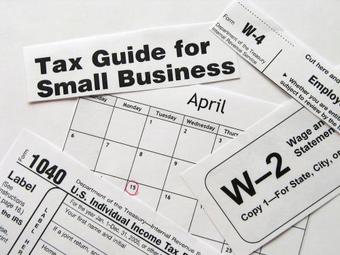
tax
Taxes are a tool used by governments to raise money and influence their citizens’ economic choices.
Elements of a Good Tax System
- Efficient: A tax system should raise the necessary revenues without unduly burdening the taxpayer.
- Understandable: A tax system should be easily understandable by the average citizen who has to pay the tax.
- Equitable:The tax burden should be distributed equitably among a nation’s citizens. Generally, this means that those that are wealthier should pay more.
- Benefit Principle: Generally, the people who use public services should pay for them with higher taxes. However this principle is difficult to enforce in practice.
Two Types of Tax Systems
- Direct Taxation: A direct tax is assessed on the income of the taxpayer and is generally collected before the taxpayer collects his wages.
- Indirect Taxation: An indirect tax is an avoidable tax assessed on certain activities, such as purchasing goods or services. Examples of an indirect tax include sales tax and VAT (value added tax).
Types of Tax Structures
- Proportional Tax: Otherwise known as a flat tax, a flat tax rate is applied to all earned income regardless of how much the taxpayer earns. So a person making $20,000 would pay the same rate as a person making $120,000, but would pay significantly less in real dollars.
- Progressive Tax: The more a person earns, the higher the tax rate. Generally in a progressive tax system, income is divided into “brackets. ” For example, assume a tax system divides earners into people two groups. Those who earn less than $100,000 pay 10% and people who earn $100,000 or more pay 20%. A person earning $20,000 would have to pay 10%, or $2,000, while a person who earns $120,000 would have to pay 20%, or $24,000.
- Regressive Tax:In a regressive tax system, poorer families pay a higher tax rate. Although a regressive tax system is never explicitly used, some claim a sales tax is a type of regressive tax. Since high income earners spend a lower proportion of their income on goods and services in comparison to low income earners, the rich tend to pay proportionally less sales tax.
Ad Valorem vs Excise Tax
Ad Valorem (or Value Added) and Excise Taxes are types of indirect taxes. Both are generally assessed on the sale of goods. These two taxes differ in three ways:
- An excise tax typically applies to a narrower range of products, such as gasoline, tobacco, and alcohol.
- An excise tax is typically heavier than an ad valorem, accounting for a higher fraction of a product’s retail price.
- Excise taxes are typically a fixed fee per unit, meaning that the government earns its revenue based on volume sold. Ad valorem taxes are proportional to the price of the good, so the government earns revenue based on the value of the good or service being sold.
3.4.9: Taxation Impact on Economic Output
Tax incidence falls mostly upon the group that responds least to price, or has the most inelastic price-quantity curve.
Learning Objective
Analyze how changes in taxes affect the price of a good for sellers and buyers
Key Points
- When supply is inelastic and demand is elastic, the tax incidence falls on the producer.
- When supply is elastic and demand is inelastic, the tax incidence falls on the consumer.
- Tax incidence is the analysis of the effect a particular tax has on the two parties of a transaction; the producer that makes the good and the consumer that buys it.
- A marginal tax is an increase in a tax on a good that shifts the supply curve to the left, increases the consumer price, and decreases the price for the sellers.
Key Terms
- elastic
-
Sensitive to changes in price.
- Tax incidence
-
The effect a particular tax has on the two parties of a transaction.
Tax incidence is the effect a particular tax has on the two parties of a transaction; the producer that makes the good and the consumer that buys it. The burden of the tax is not dependent on whether the state collects the revenue from the producer or consumer, but on the price elasticity of supply and the price elasticity of demand. To understand how elasticities influence tax incidence, its important to consider the two extreme scenarios and how the tax burden is distributed between the two parties.
Inelastic supply, elastic demand
Because supply is inelastic, the firm will produce the same quantity no matter what the price. Because demand is elastic, the consumer is very sensitive to price. A small increase in price leads to a large drop in the quantity demanded. The imposition of the tax causes the market price to increase and the quantity demanded to decrease. Because consumption is elastic, the price consumers pay doesn’t change very much. Because production is inelastic, the amount sold changes significantly. The producer is unable to pass the tax onto the consumer and the tax incidence falls on the producer .

Tax Incidence of Producer
When supply is inelastic but demand is elastic, the majority of the tax is paid for by the consumer. Since quantity demanded drops significantly in this scenario, the producer is forced to sell less.
Elastic supply, inelastic demand
Consumption is inelastic, so the consumer will consume the same quantity no matter the price. The producer will be able to produce the same amount of the good, but will be able to increase the price by the amount of the tax. As a result, the entirety of the tax will be borne by the consumer.
Similarly elastic supply and demand
Generally consumers and producers are neither perfectly elastic or inelastic, so the tax burden is shared between the two parties in varying proportions. If one party is comparatively more inelastic than the other, they will pay the majority of the tax.
Increasing tax
If the government increases the tax on a good, that shifts the supply curve to the left, the consumer price increases, and sellers’ price decreases. A tax increase does not affect the demand curve, nor does it make supply or demand more or less elastic. This potential increase in tax could be called marginal, because it is a tax in addition to existing levies.
Chapter 2: The Market System
2.1: Introducing the Market System
2.1.1: Defining a Market System
A market system is a way to match buyers and sellers.
Learning Objective
Identify the characteristics of a market system
Key Points
- Publishing current prices is a key component with a market system.
- Competition is the primary regulatory mechanism in a market system.
- Economists recognize a number of different structures of market systems based on characteristics such as the level of competition.
Key Term
- price
-
The quantity of payment or compensation given by one party to another in return for goods or services.
In an economy, a market system is any systematic process that enables many market players to bid and ask. In other words, a market system is a place (virtual or physical) that facilitates the matching of buyers and sellers. Many markets exist, and each can be defined based on a number of characteristics, such as what is being exchanged in the market, the regulations, who is allowed to participate, and how transactions occur.
One defining component of markets is the medium of exchange, or the price. In most American markets, the medium of exchange is dollars. Both buyers and sellers look at the price to determine whether or not they want to trade. A seller has a certain minimum price at which s/he is willing to sell, though s/he would happily accept more. Likewise, a buyer has a certain maximum price at which s/he is willing to buy, though s/he would happily pay less. If the minimum the seller would accept is less than the maximum a buyer would pay, a transaction can occur. Markets help such buyers and sellers meet to trade.
In market systems, prices are discoverable; both buyers and sellers are capable of finding out the current price at which a transaction could occur. Publishing current prices is a key component with a market system. The chosen prices impact the immediate group of buyers and sellers, but also may impact long term supply and demand decisions within the market.
There are many examples of market systems. Perhaps the most famous is the stock market in which buyers and sellers trade stocks . The prices at which those sales occur is recorded, and is the basis for the stock price you may have seen in the newspaper or on TV. There are markets for many types of products other than stocks: the global oil market, your local farmers’ market, and eBay are all forms of markets with their own defining characteristics.
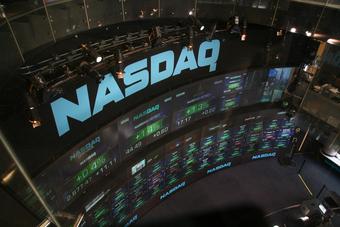
NASDAQ Stock Market Display
The NASDAQ is a stock market where buyers and sellers of stocks can meet and trade.
Another important component of market systems is that there is competition, which serves as the main regulatory mechanism. Based on the level of competition in a market system, economists have identified a number of different types of structures, such as monopoly, oligopoly, and perfect competition. We will go into more detail on different market structures later in the book.
2.1.2: Gains from Markets
Gains in a market are referred to as total welfare or economic surplus.
Learning Objective
Explain how to calculate total welfare
Key Points
- Within total welfare, economists look at consumer surplus and producer surplus.
- Consumer surplus is the monetary gain that consumers receive when they purchase a good for less than the highest price they are willing to pay.
- Producer surplus is the amount that producers benefit by selling a good at a market price that is higher than the least that they would be willing to sell it for.
- In order to calculate the total welfare, the supply and demand of the good must be used to determine the economic gain.
- When the supply of a good increases, the price falls which increases consumer surplus. When the demand for a good increases, the price increases and the supply decreases resulting in producer surplus.
Key Term
- welfare
-
Health, safety, happiness and prosperity; well-being in any respect.
Gains within a market are referred to as total welfare or economic surplus. Within total welfare, economists look at consumer surplus and producer surplus . A surplus is defined as the excess of a good or service when the quantity supplied exceeds the quantity demanded; this occurs when the price is above the equilibrium price.

Economic Surpluses
The total welfare (or economic surplus) is the sum of the consumer surplus and the producer surplus.
Consumer surplus is the monetary gain that consumers receive when they purchase a good for less than the highest price they are willing to pay. For example, a customer is willing to pay $50 for a new pair of running shoes. They are able to purchase the pair for $35 and consumer surplus is $15.
Producer surplus is the amount that producers benefit by selling a good at a market price that is higher than the least that they would be willing to sell it for. An example would be a manufacturer that makes jeans. The lowest price the producer is willing to sell a pair of jeans for is $40, but the jeans actually sell for $50. The producer surplus is $10.
In order to calculate the total welfare, the supply and demand of the good must be used to determine the economic gain. On a demand and supply curve graph, the consumer surplus is located under the demand curve and above a horizontal line that shows the actual price of a good (equilibrium price).
When the supply of a good increases, the price falls which increases consumer surplus. When the demand for a good increases, the price increases and the supply decreases resulting in producer surplus. When a good is in high demand, consumers are willing to pay more in order to obtain the good.
2.1.3: Production Possibility Frontier
A production-possibility frontier (PPF) graphs the combinations for the production of two commodities with which the same amounts are used.
Learning Objective
Explain the benefits of trade and exchange using the production possibilities frontier (PPF)
Key Points
- A PPF graph shows the maximum production level for one commodity for any production level of the other commodity.
- If a point on the graph is above the curve it indicates efficiency, while a point below the curve signifies inefficiency.
- The PPF graph shows how resources must be shared among goods during the production process.
- Within an economy, if the capacity to produce both goods increases which results in economic growth.
Key Terms
- commodity
-
Raw materials, agricultural and other primary products as objects of large-scale trading in specialized exchanges.
- marginal
-
Of, relating to, or located at or near a margin or edge; also figurative usages of location and margin (edge).
Within a market system, economists use the production possibility frontier (PPF) to graph the combinations of the amounts of two commodities that can be produced using the same amount of each factor of production. A PPF graph chooses specific input quantities. As a result, it shows the maximum production level for one commodity for any production level of the other commodity . PPF is used to define production efficiency.

A common PPF
A common PPF where there is an increase in opportunity cost.
Within a PPF graph, the use of a curve or line acts as a benchmark for measuring efficiency. If a point on the graph is above the curve it indicates efficiency, while a point below the curve signifies inefficiency. For further analysis, additional information is always supplied with a PPF including the period of time taken for the observation, production technologies, and the amounts of inputs that were available.
Economists can use a PPF to illustrate a number of economic concepts including scarcity, opportunity cost, productive efficiency, allocative efficiency, and economies of scale.
When an economy is operating on the PPF curve it is efficient. It is not possible to produce more of one good without decreasing the amount produced for the other good. Likewise, if the economy is operating below the PPF curve, it is inefficient. In this case, the economy can reallocate resources and produce more of both the goods.
The PPF graph shows how resources must be shared among goods during the production process. The points of the graph show the trade-off that takes place between two goods. For example, if more of Good A needs to be produced, the amount of resources in use by Good B must be reduced and transferred to Good A. The sacrifice in production of Good B is called opportunity cost. When graphing PPF there are three types: the common, the straight line, and the inverted PPF . All three of the PPF graphs are directly influenced by the opportunity cost.

An inverted PPF
An inverted PPF where the opportunity cost is decreasing.

A straight line PPF
A straight line PPF where the opportunity cost is constant.
The slope of the PPF shows the rate at which the production of one good can be transferred to another. The slope is called the marginal rate of transformation (MRT).
Within an economy, if the capacity to produce both goods increases, the result is economic growth. Factors that influence economic capacity include technology, an increase in the supply of factors of production, and production interactions such as trade and exchange. When any of these factors are used it allows for an increase in capacity so that the production of neither good has to be sacrificed.
PPF graphs help economists study the current state of production as well as possible production scenarios. The output of the economy is impacted by many factors. When production can be graphed and monitored it allows adjustments to be made to work towards attaining economic growth and stability.
2.1.4: The Circular Flow Model
In economics, a circular flow model is a diagram that is used to represent the monetary transactions in an economy.
Learning Objective
State the function of the circular flow diagram and the production possibilities frontier
Key Points
- There are two flows present within the model including flows of physical things (goods or labor) and flows of money (what pays for physical things).
- The circular flow of income follows a specific pattern: Production → Income → Expenditure → Production.
- The production possibility frontier can be used to illustrate the circular flow model.
- Economists use data, statistics, and natural experiments in order to make economic “laws” that explain general patterns.
Key Terms
- expenditure
-
Act of expending or paying out.
- Factors of production
-
In economics, factors of production are inputs. They may also refer specifically to the primary factors, which are stocks including land, labor, and capital goods applied to production.
In economics, a circular flow model is a diagram that is used to represent the monetary transactions in an economy. There are two flows present within the model including flows of physical things (goods or labor) and flows of money (what pays for physical things). A circular flow model depicts the inner workings of a market system and specific portions of the economy.
The basic circular flow model consists of two sectors that determine income, expenditure, and output. A state of equilibrium is reached when there is no tendency for the levels of income (
), expenditure (
), and output (
) to change (
). This equation means that the expenditure of buyers (households) becomes income for sellers (firms). The firms spend the income on factors of production, which “transfers” the income to the factor owners. The factor owners spend the income on goods which leads to the circular flow of payments .
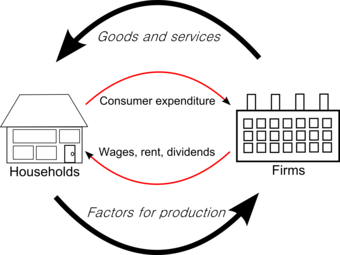
Circular flow of goods income
The circular flow model shows the flow of payments between households and firms.
The circular flow of payments is important within an economy because it 1) measures the national income, 2) provides knowledge of interdependence, 3) illustrates the unending nature of economic activities, and 4) shows injections and leakages.
The circular flow of income follows a specific pattern: Production → Income → Expenditure → Production. This circular flow is ongoing between households and firms.
The circular flow of income can also be analyzed using the production possibility frontier (PPF). The PPF is a graph that shows the various combinations of amounts of two commodities that could be produced using the same fixed total amount of each of the factors of production. The graph shows the maximum possible production level of one commodity for any production level of the other, based on the state of technology. The PPF defines production efficiency. A point of the frontier line indicates the efficient use of available inputs, while a point beneath the curve shows inefficiency. A PPF graphs shows opportunity cost, actual output, potential output, and economic growth.

Production Possibilities Frontier Curve
The graph illustrates a typical production possibilities frontier curve. When a market is operating on the PPF it is said to be efficient.
Chapter 1: Principles of Economics
1.1: The Study of Economics
1.1.1: The Magic of the Economy
The study of economics makes individuals cognizant of their environment and better decision makers.
Learning Objective
Explain how the study of economics provides knowledge to understand the system and policies that guide life.
Key Points
- Economics also allows individual agents to balance expectations.
- Economics provides distilled frameworks to analyze complex societal interactions, as in the case of consumer and firm behavior.
- Being knowledgable about economics foundations allows an individual to be an active and aware participant rather than a passive economic agent.
Key Terms
- circular flow
-
A model of market economy that shows the flow of dollars between households and firms.
- externality
-
An impact, positive or negative, on any party not involved in a given economic transaction or act.
Economics is a social science. This means that economics has two important attributes. Economics studies human activities and constructions in environments with scarce resources, and uses the scientific method and empirical evidence to build its base of knowledge.
The evaluation of human interactions as it relates to preferences, decision making, and constraints is a significant foundation of economic theory. The complexity of the dynamics of human motivation and systems has led to the establishment of assumptions that form the basis of the theory of consumer and firm behavior, both of which are used to model circular flow interactions within the economy .
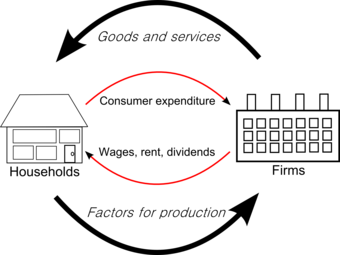
Circular Flow of the Economy
Economics provides an accessible foundation for understanding the complexity of the interactions in the world. For example, the circular flow diagram displays the economic framework related to the dynamic interconnectedness of economic agents. In the graph above the display is limited to households and firms but other depictions of circular flow incorporate the government and international trading partners.
Economics provides distilled frameworks to analyze complex societal interactions, as in the case of consumer and firm behavior. An understanding of how wages and consumption flow between consumers and producers provides agents with an ability to understand the symbiosis of the relationship rather than fixating on the contentious components that surface from time to time.
Economics also allows individual agents to balance expectations. An understanding of the ebb and flow of the economy through the boom and bust of the business cycles, creates the potential for emotional balance by reminding agents to limit desperation in downturns and exuberance in expansions.
By developing an understanding of the foundations of economics, individuals can become better decision makers with respect to their own lives and maintain a balance with respect to an externality that has the potential to supplement or deter their plans. Since economic theories are a basis of decision making and regulatory policy, being knowledgable about economics foundations allows an individual to be an active and aware participant rather than a passive economic agent.
1.1.2: Is Economics a Science?
Economics is a social science that has diverse applications.
Learning Objective
Explain how economic theory and analysis can be applied throughout society
Key Points
- Economics incorporates both qualitative and quantitative assessment.
- Economics is divided into two broad areas: microeconomics and macroeconomics.
- Economics can be applied throughout society from business to individual behavior with further application in the study of crime, family and other social institutions and interactions.
Key Term
- social science
-
A branch of science that studies the society and human behavior in it, including anthropology, communication studies, criminology, economics, geography, history, political science, psychology, social studies, and sociology.
Example
- Market interaction between buyers and sellers is an evaluation of social behavior in an activity where each agent is seeking to maximize return and minimize cost. This is a classic scenario of economics, involving social interaction (qualitative) with optimization (quantitative).
Economics is a social science that assesses the relationship between the consumption and production of goods and services in an environment of finite resources. A focus of the subject is how economic agents behave or interact both individually (microeconomics) and in aggregate (macroeconomics).
Microeconomics examines the behavior individual consumers and firms within the market, including assessment of the role of preferences and constraints. Macroeconomics analyzes the entire economy and the issues affecting it. Primary focus areas are unemployment, inflation, economic growth, and monetary and fiscal policy.
The discipline of economics evolved in the mid-19th century through the combination of political economy, social science and philosophy and gained entrenchment with the increased scrutiny of the asymmetric financial and welfare distribution attributed to sovereign rule. Early writings are attributable to Jeremy Bentham, David Ricardo, John Stuart Mill and his son John Mill and are focused on human welfare and benefits rather than capitalism and free markets .
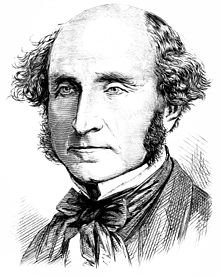
Founders of Economics
John Stuart Mill, along with David Ricardo, Jeremy Bentham and other political and social philosophers of the mid-nineteenth century are credited with the founding of the social-political theory that has evolved to be the discipline of economics.
As in other social sciences, economics does incorporate mathematics in the theoretical and analytics framework of the discipline. Formal economic modeling began in the 19th century with the use of differential calculus to represent and explain economic behavior, such as utility maximization, an early economic application of mathematical optimization in microeconomics. Economics utilizes mathematics to assess the relationships between economic actors in environments in which resources are finite.
The use of mathematics in economics increased the quantitative analysis inherent in the discipline; however, given the discipline’s essentially social science roots, many economists from John Maynard Keynes to Robert Heilbroner and others criticized the broad use of mathematical models for human behavior, arguing that some human choices can not be modeled or evaluated in a mathematical equation.
Economic theory and analysis may be applied throughout society, including business, finance, health care, and government. The underlying components of economic theory can also be applied to variety of other subjects, such as crime, education, the family, law, politics, religion, social institutions, war, and science.
1.2: Individual Decision Making
1.2.1: Scarcity Leads to Tradeoffs and Choice
When scarce resources are used, actors are forced to make choices that have an opportunity cost.
Learning Objective
Give examples of economic trade-offs.
Key Points
- Scarce resources diminish as they are used and almost all resources are scarce.
- In order to use a scarce resource, you are inherently using the resource for one purpose and not an alternative.
- The cost of using a resource is called the opportunity cost: the value of the next best alternative that you could be using the resource for instead.
Key Terms
- Scarce
-
Insufficient to meet demand.
- Opportunity cost
-
The value of the best alternative forgone.
A fundamental concept in economics is that of scarcity. In contrast to its colloquial usage, scarcity in economics connotes not that something is nearly impossible to find, but simply that it is not unlimited. For example, the number of available hours in a day is a scarce resource: there is a finite amount of time available to you to do work, hang out with friends, and relax. Most resources are scarce in most situations.
Since resources tend to be scarce, anyone that uses the resource has to make a decision about how to use it. Suppose, for example, that you are a drink manufacturer. To produce a beverage, you have to use some scarce resources: the plastic for the bottle, the workers’ time, a machine to fill the bottles, etc. If you choose to make one bottle of water, you have chosen to not make a bottle of soda . Your scarce resources force you to make a choice and a trade-off producing one product or another.
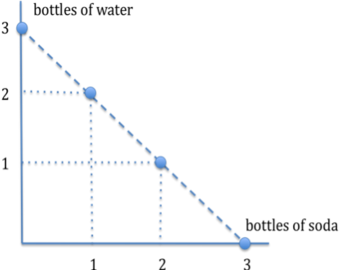
Tradeoffs
Since resources are scarce for a drink manufacturer, it must make a tradeoff between producing bottles of water and bottles of soda.
Like producers, consumers also have to make choices. Often, consumer must choose between current consumption (“I want to buy an ice cream”) and future consumption (“I should rather save my money so I can buy an ice cream tomorrow”). Since consumers’ resources such as time, attention, and money are limited, they must choose how to best allocate them by making tradeoffs.
The concept of trade-offs due to scarcity is formalized by the concept of opportunity cost. The opportunity cost of a choice is the value of the best alternative forgone. In other words, if you can only produce bottles of soda and water, the opportunity cost of producing a bottle of water is the value of producing a bottle of soda. Similarly, there is an opportunity cost in everything: the opportunity cost of you reading this is what you could be doing with your time instead (say, watching a movie). When scarce resources are used (and just about everything is a scarce resource), people and firms are forced to make choices that have an opportunity cost.
1.2.2: Individuals Face Opportunity Costs
Individuals face opportunity costs when they choose one course of action over another.
Learning Objective
Distinguish between explicit costs and opportunity costs
Key Points
- The opportunity cost is the value of the next best alternative foregone.
- Every decision necessarily means giving up other options, which all have a value.
- The opportunity cost is the value one could have derived from using the same resources another way, though this is not always easily quantifiable.
Key Term
- Opportunity Costs
-
The value of the best alternative forgone, in a situation in which a choice needs to be made between several mutually exclusive alternatives given limited resources.
When individuals make decisions, they are necessarily deciding between taking one course of action over another. In doing so, they are choosing both what to do and, by extension, what not to do. The value of the next best choice forgone is called the opportunity cost. In other words, the opportunity cost of a course of action is the value the of the option that the individual chose not to take.
Individuals face opportunity costs in both economic and non-economic decisions. One of the easiest way to imagine an individual’s opportunity costs is to imagine a student who decides to study. By choosing to study, the student is implicitly choosing to not go to a party, hang out with friends, or catch up on some much-needed sleep . In this example, the opportunity cost is not easily expressed in dollars and cents, but is just as real.

Opportunity Cost
By choosing to go to spend time and money on things like classes and computers, you are necessarily choosing not to spend it on something else, like going on vacation. This is an opportunity cost.
Rational individuals will try to minimize their opportunity costs. By doing so, individuals are maximizing the amount that they can get out of their resources (time, money, effort, etc.). This makes sense: individuals should seek to get the most and give up the least.
As economic actors, individuals face opportunity costs as well. For example, suppose you decide to purchase a new computer. You could have chosen to spend your money on books or rent or a spring break trip; whichever one of those options is most valuable to you (beside purchasing a new computer) is the opportunity cost.
Such logic applies for every economic decision: purchasing one good means that an individual has chosen to spend resources one way instead of another. Opportunity costs are an important consideration for economists and business people, but are faced by individuals even when they are not making classically economic decisions.
1.2.3: Individuals Make Decisions at the Margins
Individuals will choose the option that yields the greatest net marginal benefit.
Learning Objective
Apply the concepts of marginal analysis and utility to decision-making
Key Points
- The marginal cost or benefit is the amount that a decision will change the total cost or benefit from where it is currently.
- Individuals will make choice that maximizes the net marginal benefit (marginal benefit – marginal cost).
- While total or average cost and benefit are important, provided enough resources, individuals will look only at the net marginal benefit.
Key Terms
- marginal cost
-
The additional cost from taking a course of action.
- marginal benefit
-
The additional benefit from taking a course of action.
When individuals make decisions, they do so by looking at the additional cost and benefit of the decision. The cost or benefit of the single decision is called the marginal cost or the marginal benefit. This is different from the total or average: net marginal benefit (marginal benefit minus marginal cost) is the amount that total benefit will change due to the single decision. For example, if the cost of making 9 pieces of pizza is $90 and the cost of making 10 pieces is $110, the marginal cost of producing the tenth piece of pizza is $20. In theory, individuals will only choose an option if marginal benefit exceeds marginal cost.

Marginal and Total Utility
Marginal utility is the amount that a certain action will change total utility. Individuals use net marginal utility to make decisions.
Let’s take an example. Suppose you are buying a car and have three choices:
- Car A, which costs $10,000
- Car B, which costs $12,000
- Car C, which costs $15,000
The prices represent the marginal costs of each car; purchasing the car will add the cost of the car to your total costs. Also suppose Car A provides you $15,000 worth of utility, Car B provides $15,000, and Car C provides $25,000. Those utilities, in dollar terms, are the marginal benefit of each car.
In order to make the decision, you look at the marginal cost and marginal benefit of each car. By subtracting the cost from the benefit, Car A offers $5,000 of marginal benefit, Car B offers $3,000, and Car C offers $10,000. Obviously, Car C is the best choice because, at the margins, it offers the most benefit to you.
Note that you are concerned not with your total or average cost and benefit (assuming no resource or other external restrictions), but with the marginal cost and benefit. As a decision maker, you want to know how much the decision will change your current state, so you look at the margins, not the overall picture. That is not to say that things like the total cost are unimportant, but that, assuming there are enough resources, individuals will look at the marginal change each option will provide to his/her life or to the firm and chose the one with the greatest net marginal benefit.
Marginal Benefits and Costs for Pollution
The tools of marginal analysis can illustrate the marginal costs and the marginal benefits of reducing pollution. When the quantity of environmental protection is low (quantity
) and pollution is extensive, there are cheap and easy ways to reduce pollution, and the marginal benefits of doing so are quite high. At
, it makes sense to allocate more resources to fight pollution.
However, as environmental protection increases, the cheap and easy ways of reducing pollution decrease, and pollution can only be reduced with costly methods. In other words, the largest marginal benefits are achieved first, followed by decreasing marginal benefits. As the quantity of environmental protection increases to
, the gap between marginal benefits and marginal costs decreases. At point , the marginal costs will exceed the marginal benefits. At this level of environmental protection, society is not allocating resources efficiently, because too many resources are being given up to reduce pollution.
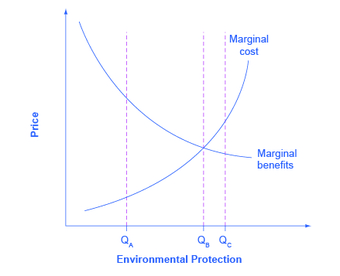
Marginal Costs and Marginal Benefits of Environmental Protection
Reducing pollution is costly—resources must be sacrificed. The marginal costs of reducing pollution are generally increasing, because the least expensive and easiest reductions can be made first, leaving the more expensive methods for later. The marginal benefits of reducing pollution are generally declining, because the steps that provide the greatest benefit can be taken first, and steps that provide less benefit can wait until later.
1.2.4: Individuals Respond to Incentives
Incentives are ways to encourage or discourage certain behaviors or choices.
Learning Objective
Predict how pay incentives will influence a person’s work performance
Key Points
- Price is one of the main incentives studied in economics. Price incentivizes producers to supply a certain amount, and consumers to purchase a certain amount.
- Economics is mainly concerned with studying remunerative incentives (those that concern material reward).
- Individuals, firms, and governments all change incentives in hopes of encouraging desired outcomes.
Key Terms
- Incentive Structure
-
The cumulative set of promised rewards and/or punishments that encourage actors to make a set of decisions.
- incentive
-
Something that motivates an individual to perform an action.
An incentive is something that motivates an individual to perform an action. The study of incentive structures is central to the study of all economic activities (both in terms of individual decision-making and in terms of cooperation and competition within a larger institutional structure).
Perhaps the most notable incentive in economics is price. Price acts as a signal to suppliers to produce and to consumers to buy. For example, a sale is nothing more than a store providing an incentive to potential customers to buy. The lowering of the price makes the purchase a better idea for some customers; the sale seeks to persuade individuals to change their actions (namely, to buy the product).

Sales are Incentives
Sales are incentives for consumers to buy, because firms know consumers generally respond to lower prices by purchasing more.
Similarly, the increase in price acts as an incentive to suppliers to produce more of a good. If suppliers think they can sell their products for more, they will be inclined to produce more. The price acts, therefore, as an incentive to customers to buy and suppliers to produce.
Types of Incentives
Incentives come in many other forms, however. Broadly, most incentives can be grouped into one of four categories:
- Remunerative incentives: The incentive comes in the form of some sort of material reward – especially money – in exchange for acting in a particular way. Wages, prices, and bribery are all examples of remunerative incentives. This is the type of incentive that is typically associated with economics.
- Moral incentives: This occurs when a certain choice is widely regarded as the right thing to do, or as particularly admirable, or where the failure to act in a certain way is condemned as indecent. Societies and cultures are two main sources of moral incentives.
- Coercive incentives: The incentive is a promise of some sort of punishment if the wrong decision is made. For example, the promise of imprisonment is a coercive incentive for people to not steal.
- Natural Incentives: Things such as curiosity, mental or physical exercise, admiration, fear, anger, pain, joy, the pursuit of truth, and a sense of control of people or oneself can cause individuals to make certain decisions.
Economics is mainly concerned with remunerative incentives, though when discussing government regulations, coercive incentives often come into play. By manipulating incentives, individuals (as well as businesses and governments) hope to encourage some behaviors and discourage others.
Incentives and Performance
Companies leverage incentives-based strategies to drive performance and optimize employee decision-making and behaviors through meaningful reward systems. While there are both advantages and drawbacks to this type of approach, remunerative (financial) incentives are highly attractive options for employers in a variety of industries and businesses. Providing incentives such as variable income, where an individual can obtain more personal rewards for successfully creating a product or making a sale, often drives up production for highly motivated employees.
An example of this would be a manufacturing facility making widgets. The floor manager shifts the wage system from an hourly wage perspective to a straight piece rate system. The more widgets a worker creates, the higher his or her prospective income will be. Under this incentive system less productive workers may stay the same, but highly productive workers will respond by increasing their production.
1.3: Interaction of Individuals, Firms, and Societies
1.3.1: Introducing the Firm
Firms allow an economy to operate more efficiently and reduce the transaction costs of coordinating production.
Learning Objective
Explain the importance of private companies and firms in the economy
Key Points
- Firms generally appear and become prevalent as an alternative to individual trade when it is more efficient to produce in a non-market environment.
- Limited liability separates the management of a firm from its ownership, allowing companies to raise money easily because owners do not need to risk everything in the case of bankruptcy.
- Most industries experience increasing returns to scale up to a point, which means that more goods can be produced using fewer resources.
- According to Ronald Coase, the main reason to establish a firm is to avoid some of the transaction costs of using the price mechanism.
Key Terms
- increasing returns to scale
-
The characteristic of production in which output increases by more than the proportional increase in inputs.
- firm
-
A business enterprise, however organized.
“Firm” is simply another word for company or business. The basic economic marketplace consists of transactions between households and firms. Firms use factors of production – land, labor, and capital – to produce goods that are consumed by households. They may be organized in many different ways – corporations, partnerships, sole proprietorships, and collectives are all examples of firms. Economists who study the theory of the firm attempt to describe, explain, and predict the nature of a firm, including its existence, behavior, structure, and relationship to the market.
The Evolution of the Firm
Not all markets and societies involve firms. In many medieval cities, most production was done by individual craftsmen who were loosely organized into guilds, or by tenant farmers who rented family-sized plots of land. Transactions took place primarily between individuals.
Firms generally appear and become prevalent as an alternative to individual trade when it is more efficient to produce in a non-market environment. For example, in a labor market, it might be too difficult or costly for firms or organizations to engage in production when they have to hire and fire their workers depending on demand/supply conditions. While the advantages of consolidation for efficiency are potentially many and varied, the underlying concept is that integrating operational paradigms enables potential synergy via the construct of a firm.
Firms also allow economic growth, not only for the firm but for the broader society in which it resides. Through separating the business from the individual(s) who starts it, the funding, insurance and liability of a firm can function independently of a person. The separation of a firm from the individual also allows more specifically applicable regulations and laws, broader accumulation of investment capital and more complex strategic alliances. While the detailed implications of a firm and it’s relationship with individuals and society are complex, the important takeaway is that firms play an integral role in economic structure.
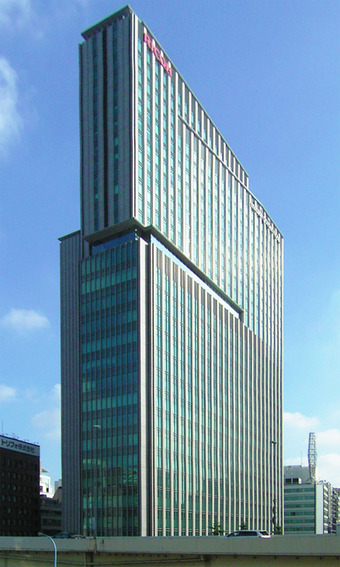
The Firm
Organizing production under firms reduces the transaction costs of coordinating production in the market.
The Transaction Theory of the Firm
According to Ronald Coase, people begin to organize their production in firms when the transaction cost of coordinating production through the market exchange is greater than within the firm. He notes that a firm’s interactions with the market may not be under its control (for instance because of sales taxes), but its internal allocation of resources are: “Within a firm, … market transactions are eliminated and in place of the complicated market structure with exchange transactions is substituted the entrepreneur … who directs production.” He asks why alternative methods of production (such as the price mechanism and economic planning), could not either achieve all production, so that either firms use internal prices for all their production, or one big firm runs the entire economy.
For Coase the main reason to establish a firm is to avoid some of the transaction costs of using the price mechanism. These include discovering relevant prices (which can be reduced but not eliminated by purchasing this information through specialists), as well as the costs of negotiating and writing enforceable contracts for each transaction (which can be large if there is uncertainty). Moreover, contracts in an uncertain world will necessarily be incomplete and have to be frequently re-negotiated. The costs of haggling about division of surplus, particularly if there is asymmetric information and asset specificity, may be considerable. Organization into a firm can considerably reduce these costs.
1.3.2: Trade Leads to Gains
Producers and consumers trade because the exchange makes both parties better off.
Learning Objective
Explain why parties trade.
Key Points
- The benefit of exchange to producers is measured by the profit the producer makes. The benefit of exchange to a consumer is measured by net utility gained.
- Consumer surplus is the monetary gain obtained by consumers because they are able to purchase a product for a price that is less than the highest price that they would be willing to pay.
- Producer surplus is the amount that producers benefit by selling at a market price that is higher than the least that they would be willing to sell for.
- An allocation of resources is Pareto efficient when it is impossible to make any one individual better off without making at least one individual worse off.
Key Terms
- utility
-
The ability of a commodity to satisfy needs or wants; the satisfaction experienced by the consumer of that commodity.
- consumer surplus
-
The difference between the maximum price a consumer is willing to pay and the actual price they do pay.
- producer surplus
-
The amount that producers benefit by selling at a market price that is higher than the lowest price at which they would be willing to sell.
Producers and consumers trade because the exchange makes both parties better off. The benefit of exchange to producers is measured by the amount of profit – that is, the difference between the average cost of producing an item and the price received for that item. The benefit of exchange to a consumer is measured by net utility gained. This is measured by taking the difference between the maximum price a consumer is willing to pay and the actual price they do pay. To understand this, imagine purchasing a car. You would be willing to pay up to $15,000 for a car in good condition, but you are able to buy one for only $12,000. Since you value the car at $3,000 more than you paid for it, $3,000 is the benefit that you gained from the transaction.
Economists refer to these benefits from exchange as producer and consumer surplus. Consumer surplus is the monetary gain obtained by consumers because they are able to purchase a product for a price that is less than the highest price that they would be willing to pay. Producer surplus is the amount that producers benefit by selling at a market price that is higher than the least that they would be willing to sell for.
The amount of consumer and producer surplus that is gained from a transaction can be seen on a standard supply and demand graph. Consumer surplus is the area (triangular if the supply and demand curves are linear) above the equilibrium price of the good and below the demand curve. This reflects the fact that consumers would have been willing to buy a single unit of the good at a price higher than the equilibrium price, a second unit at a price below that but still above the equilibrium price, etc., yet they in fact pay just the equilibrium price for each unit they buy.
Likewise, in the supply-demand diagram, producer surplus is the area below the equilibrium price but above the supply curve. This reflects the fact that producers would have been willing to supply the first unit at a price lower than the equilibrium price, the second unit at a price above that but still below the equilibrium price, etc., yet they in fact receive the equilibrium price for all the units they sell. The sum of consumer and producer surplus is called economic, or social, surplus, and reflects the total amount of benefit received by society when consumers and producers trade.

Consumer and Producer Surplus
Consumer surplus is the area between the demand line and the equilibrium price, and producer surplus is the area between the supply line and the equilibrium price.
Exchange and Pareto Optimality
An allocation of resources is Pareto efficient when it is impossible to make any one individual better off without making at least one individual worse off. For example, imagine that two individuals prefer peanut butter and jelly sandwiches to a sandwich with only peanut butter or only jelly. A distribution in which Individual A has all of the peanut butter and individual B has all of the jelly is not Pareto efficient, because both parties would be better off if they shared their resources.
Similarly, an action that makes at least one party better off without making any individual worse off is called a Pareto improvement. Any transaction in a free market always produces a Pareto improvement because it makes consumers and/or producers better off without making either party worse off (if this were not the case, the consumer and/or the producer would refuse to participate in the transaction in the first place). It is commonly assumed that outcomes that are not Pareto efficient are to be avoided, and if a Pareto improvement is possible it should always be implemented.
One way to look at whether a transaction is a Pareto improvement is to ask whether it increases consumer or producer surplus without decreasing either party’s surplus. Lowering an item’s price without changing the quantity sold, for example, may increase consumer surplus, but is not a Pareto improvement because producers suffer negative consequences.
1.3.3: Thinking about Efficiency
An efficient market maximizes total consumer and producer surplus.
Learning Objective
Define economic efficiency.
Key Points
- Economists assume that firms seek to maximize their profits – defined as the difference between total revenue and total cost – while consumers seek to maximize their utility – which is roughly defined as the total satisfaction gained from goods, services, or actions.
- An efficient allocation of resources maximizes total consumer and producer surplus.
- Because they produce efficient outcomes, the seemingly haphazard workings of the marketplace can promote the common good.
- Efficiency is but one of many vying goals in an economic system, and different notions of efficiency may be complementary or may be at odds.
Key Terms
- producer surplus
-
The amount that producers benefit by selling at a market price that is higher than the lowest price at which they would be willing to sell.
- consumer surplus
-
The difference between the maximum price a consumer is willing to pay and the actual price they do pay.
Every economic transaction has a buyer and a seller who will only participate is she is receiving at least a minimum benefit. These benefits are represented as consumer surplus and producer surplus, respectively. In , both types of surpluses are displayed graphically. An efficient market maximizes total consumer and producer surplus.

Consumer and Producer Surplus
Consumer and producer surplus are maximized at the market equilibrium – that is, where supply and demand intersect.
The market shown in is one without any distortions such as regulations, taxes, or an inability for buyers to meet sellers. It is subject to what Adam Smith described as the invisible hand: if the price is anything except the equilibrium price, market forces will eventually return the market price to equilibrium .
Not all markets are efficient. There are a number of reasons why a market may be inefficient. Perhaps most well known is inefficiency caused by government intervention. Governments can institute any number of policies that prevent markets from achieving the free market equilibrium price and quantity: taxes raise prices, quotas limit the quantity sold, and regulations affect the supply and demand curves. Market inefficiency can also be caused by things such as irrational market actors and barriers to transactions, such as an inability for buyers and sellers to find one another.
Economists often seek to maximize efficiency, but it is important to contextualize such aims. Efficiency is but one of many vying goals in an economic system, and different notions of efficiency may be complementary or may be at odds. Most commonly, efficiency is contrasted or paired with morality, particularly liberty, and justice. Some economic policies may be seen as increasing efficiency at a cost to other goals or values, though this is certainly not a universal tradeoff. For example, taxation will always cause some inefficiency in markets, but many individuals believe that the benefits of programs such as Social Security and public schooling are worth the loss in efficiency.
1.3.4: The Function and Nature of Markets
In a free market, the price and quantity of an item are determined by the supply and demand for that item.
Learning Objective
Summarize the defining characteristics of a free market economy
Key Points
- A market is defined as a system or institution whereby parties engage in exchange. A market economy is an economy in which decisions regarding investment, production, and distribution are based on supply and demand, and prices of goods and services are determined in a free price system.
- In a perfectly competitive market there are many buyers and sellers so no individual actor may affect a good’s price; there are no barriers to exit or entry; products are homogeneous; and all actors in the economy have perfect information.
- Changes to the market supply and market demand will cause changes in the equilibrium price and quantity of the good produced.
- When markets are perfectly competitive, the equilibrium outcome of trade in the market is economically efficient. This means that the market is producing the largest net gain possible for society, given consumers’ utility functions and producers’ production functions.
Key Terms
- equilibrium
-
The condition of a system in which competing influences are balanced, resulting in no net change.
- market economy
-
An economy in which goods and services are exchanged in a free market, as opposed to a state-controlled or socialist economy; a capitalistic economy.
In economics, a market is defined as a system or institution whereby parties engage in exchange. A market economy is an economy in which decisions regarding investment, production, and distribution are based on supply and demand, and prices of goods and services are determined in a free price system. The major defining characteristic of a market economy is that decisions on investment and the allocation of producer goods are mainly made through markets. This is the opposite of a planned economy, where investment and production decisions are embodied in a plan of production.
A free market is a market structure that is not controlled by a designated authority. Free markets may have different structures: perfect competition, oligopolies, monopolistic competition, and monopolies are all types of markets that may exist in a capitalist economy. The most basic models in economics assume that markets are free and experience perfect competition – there are many buyers and sellers so no individual actor may affect a good’s price; there are no barriers to exit or entry; products are homogeneous; and all actors in the economy have perfect information.
Market Equilibrium
In a free market, the price and quantity of an item is determined by the supply and demand for that item. The market demand function describes the amount of a good that all consumers will purchase at a given price, while the market supply function expresses the amount that producers will supply at a given price. Consider the market for computers. At a price of $1,200, the market may demand 8,000 computers, while producers are willing to supply 15,000 computers. This is not the equilibrium price because at $1,200, supply exceeds demand. In order to reach equilibrium, the price must drop, causing demand to rise and supply to fall until the two are equal. This can be expressed graphically by drawing the market supply function and the market demand function and finding the point where the two curves intersect .

Market Supply and Demand
The market equilibrium exists where the market demand curve and the market supply curve intersect.
Changes to the market supply and market demand will cause changes in the equilibrium price and quantity of the good produced. For example, if a new technology is invented that allows producers to manufacture cars more efficiently, supply will rise and the market supply curve will shift to the right. The new market equilibrium will have a higher number of cars sold at a lower price. When markets are perfectly competitive, the equilibrium outcome of trade in the market is economically efficient. This means that the market is producing the largest net gain possible for society, given consumers’ utility functions and producers’ production functions.
1.3.5: Markets are Typically Efficient
A perfectly competitive market with full property rights is typically efficient.
Learning Objective
Define efficient markets.
Key Points
- A market has productive efficiency when units of goods are being supplied at the lowest possible average cost.
- A market has allocative efficiency if the price of a product that the market is supplying is equal to the value consumers place on it.
- It is important to note that achieving economic efficiency is not always the most important goal for a society. A market can be perfectly efficient but highly unequal.
- A smoothly functioning market requires that producers possess property rights to the goods and services they produce and that consumers possess property rights to the goods and services they buy.
Key Term
- Pareto efficiency
-
The state in which no one can be made better off by making another worse off.
An efficient market maximizes total consumer and producer surplus; there is no deadweight loss . An economic system is said to be more efficient than another (in relative terms) if it can provide more goods and services for society without using more resources. In absolute terms, a situation can be called economically efficient if:

Economic Inefficiency
A sign of economic inefficiency in a market is the presence of deadweight loss.
- No one can be made better off without making someone else worse off (commonly referred to as Pareto efficiency),
- No additional output can be obtained without increasing the amount of inputs, and
- Production proceeds at the lowest possible per-unit cost.
Economists refer to two types of market efficiency. A market has productive efficiency when units of goods are being supplied at the lowest possible average cost. This condition is satisfied if the equilibrium quantity is at the minimum point of the average total cost curve. For example, if a farm can produce 10,000 bushels of corn with 20 employees, but is currently producing 10,000 bushels with 25 employees, it is not achieving productive efficiency.
A market has allocative efficiency if the price of a product that the market is supplying is equal to the value consumers place on it. This is equivalent to saying that the marginal cost of an item is equal to its price. If a market is not allocatively efficient, then it is creating too much of something that consumers value less than other goods, or not enough of something that consumers value more. A market that produces 500 loaves of bread but only one gallon of milk is probably not allocatively efficient.
As you study economics further, it is usually safe to assume that markets are efficient unless you’re dealing with a distortion (e.g. regulations, imperfect information sharing).
It is important to note that achieving economic efficiency is not always the most important goal for a society. A market can be perfectly efficient but highly unequal, for example. If 1% of the population controls virtually all the income, then the market will efficiently allocate virtually all of its production to those same people. While this is economically efficient, many would argue that it is not desirable. Efficient markets may have negative effects on those that exist outside of the market; for example, the energy market may cause environmental harm that is not captured in the economic notion of efficiency.
1.3.6: Government Intervention May Fix Inefficient Markets
Governments can intervene to make a market more efficient when a market failure, such as externalities or asymmetric information, exists.
Learning Objective
Discuss the role of government in addressing common market failures
Key Points
- Economic efficiency occurs under the following conditions: competitive markets with accurate exchange of information and mobile resources, in which individuals bear the full costs and benefits of their transactions.
- The criteria for economic efficiency are rarely fully met.
- If a transaction affects individuals not involved in the transaction (either positively or negatively), that transaction is said to have an externality.
- Governments can intervene by taxing negative externalities or subsidizing positive externalities.
- Free markets will generally produce less than the optimal amount when a good is nonexcludable and nonrivalrous, which means that a government can make the market more efficient by producing the public good itself.
Key Terms
- public good
-
A good that is both non-excludable and non-rivalrous in that individuals cannot be effectively excluded from use and where use by one individual does not reduce availability to others.
- externality
-
An impact, positive or negative, on any party not involved in a given economic transaction or act.
- free rider
-
One who obtains benefit from a public good without paying for it directly.
In an efficient market, firms can produce goods at the lowest possible cost while individuals can access the goods and services they desire, all while utilizing the least resources possible. A market can be said to be economically efficient if it has certain qualities:
- perfectly competitive
- mobile resources
- accurate and freely available information
- individuals directly receive the costs and benefits of their transactions
Market failure is the name for when a market is not efficient; that is, when it deviates from one or more of the above conditions. However, in reality no market is perfectly efficient. In general, minor inefficiencies do not dramatically affect society. But when society is adversely affected by economic inefficiency, such as when a monopoly firm raises prices to a point where people cannot afford a basic good, the government will sometimes intervene.
Consider the problem of externalities, the phenomenon of when a transaction occurs that affects people who were not directly involved. For example, when a coal plant producing electricity causes pollution, there is a transaction between the company and the resident who purchases the product. But if you live near the coal plant and suffer from asthma due to the smog it produces, you are encountering a negative externality. You had no choice in the transaction, but are experiencing its effects.
Externalities are an example of economic inefficiency, since those involved in the economic transaction do not bear the full costs of the transaction. In this case, governments can intervene by taxing the transaction and using the money to negate the harmful effects or to compensate those affected by the negative externality. Similarly, when a transaction produces positive externalities, efficiency is achieved when the government subsidizes the transaction. Education is an example of a transaction that has a positive effect on society.
Another case in which markets do not operate efficiently on their own is the market for public goods. Public goods are nonrival, which means that more than one (and sometimes many!) individual can use the good at one time. They are also nonexcludable, which means that their use cannot be prevented. For example, consider a beautiful fountain in a public park. The company that built the fountain cannot force people to pay money in order to enjoy it, since its in a public area; and since one person looking at the fountain doesn’t prevent others from looking at it, it is a nonrival good.
Free markets will generally produce less than the optimal amount when a good is nonexcludable and nonrivalrous, which means that a government can make the market more efficient by producing the public good itself. By using tax revenue, governments can avoid the problem of free riders and produce an efficient quantity of public goods even when the free market cannot.

National Defense as a Public Good
National defense is a classic example of a good that is nonexcludable and nonrivalrous. It will be under-produced unless the government provides it.
1.3.7: Full Economy Interactions
Variables that describe the full economy, such as GDP and unemployment, are determined by the decisions of individual economic actors.
Learning Objective
Explain how the macroeconomy is the sum of many individual economic actors’ decisions.
Key Points
- Macroeconomists combine the demand of all consumers in a market (aggregate demand) and the supply from all producers in a market (aggregate supply) to look at the way these groups interact on a large scale.
- Just as the choices made by individual consumers and producers can be aggregated to describe an entire industry, their combined effects can also influence a nation’s overall economic activity.
- GDP is measured by adding together all the production undertaken by a nation’s firms. Individual firms affect GDP every time they choose to produce more or less. Consumers affect GDP whenever they increase or decrease demand for goods.
Key Terms
- inflation
-
An increase in the general level of prices or in the cost of living.
- aggregate
-
A mass, assemblage, or sum of particulars; something consisting of elements but considered as a whole.
In the most basic economic model, the economy consists of interactions between households, which provide labor and purchase goods, and firms, which employ labor and produce goods . Macroeconomics studies the aggregate effects of the actions of many individual households and firms. While microeconomists might study how a market with one producer and one consumer reaches equilibrium, macroeconomists combine the demand of all consumers in a market (aggregate demand) and the supply from all producers in a market (aggregate supply) to look at the way these groups interact on a large scale.
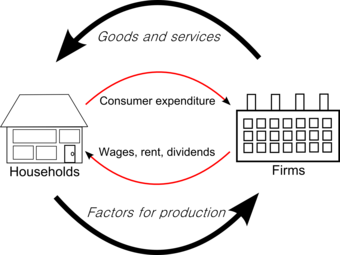
Circular Flow
The economy consists of interactions between firms and households.
Consider the market for CDs. Each individual consumer has a demand function for CDs that determines how many he will buy at a particular price – for example, one consumer may only buy a single album if they cost $15 each, but would buy two if the price dropped to $10 each. Likewise, each producer has a production function that determines how many CDs it will produce at a given price; it may produce 10,000 CDs if they can be sold for $10, but will increase production to 12,000 if the price rises to $15. In order to understand the entire market for CDs, economists add the demand of all consumers at each possible price, creating an aggregate demand curve, and the total quantity supplied by producers at each possible price, creating an aggregate supply curve. The point at which these two curves intersect shows the market equilibrium for CDs.
The Macroeconomy
Just as the choices made by individual consumers and producers can be aggregated to describe an entire industry, their combined effects can also influence a nation’s overall economic activity. Macroeconomists study a variety of these effects, but three are central to macroeconomic research:
- Gross domestic product (GDP) – the size of an entire economy’s output – is measured by adding together all the production undertaken by a nation’s firms. Individual firms affect GDP every time they choose to produce more or less. Consumers affect GDP whenever they increase or decrease demand for goods.
- Inflation occurs when many individual consumers increase demand for a good, raising the equilibrium price for the economy as a whole.
- Unemployment rises when firms choose to produce less or when consumers decrease their demand at a given price.
1.4: Basic Economic Questions
1.4.1: Production Outputs
A firm’s production outputs are what it creates using its resources: goods or services.
Learning Objective
Identify how suppliers determine what and how much to supply
Key Points
- The profit-maximizing amount of output occurs when the marginal cost of producing another unit equals the marginal revenue received from selling that unit.
- Output are the quantity of goods or services produced in a given time period, by a firm, industry or country.
- There are four types of market scenario that a firm may encounter when making a production decision: economic profit, normal profit, loss-minimizing condition, and shutdown. The firm should always produce unless it encounters a shutdown scenario.
Key Terms
- fixed costs
-
A cost of business which does not vary with output or sales; overheads.
- average total cost
-
Average cost or unit cost is equal to total cost divided by the number of goods produced (the output quantity, Q). It is also equal to the sum of average variable costs (total variable costs divided by Q) plus average fixed costs (total fixed costs divided by Q).
- variable cost
-
A cost that changes with the change in volume of activity of an organization.
- marginal cost
-
The increase in cost that accompanies a unit increase in output; the partial derivative of the cost function with respect to output. Additional cost associated with producing one more unit of output.
Production outputs are the goods and services created in a given time period, by a firm, industry or country. These goods can either be consumed or used for further production. Production outputs can be anything from crops to technological devices to accounting services. Producing these outputs incur costs which must be considered when determining how much of a good should be produced.
Determining what to produce and how much to produce can be difficult. Microeconomics assumes that firms and businesses are profit-seeking. This means that above all else they will produce goods and services to the degree that maximizes their profits. In economic theory, the profit-maximizing amount of output in occurs when the marginal cost of producing another unit equals the marginal revenue received from selling that unit . When the product’s marginal costs exceeds marginal revenue, the firm should stop production.

Production Conditions
A firm will seek to produce such that its marginal cost (MC) is equal to marginal revenue (MR, which is equal to the price and demand). It is not produced based on average total cost (ATC).
Once a firm has established what its profit-maximizing output is, the next step it must consider is whether to produce the good given the current market price. There are several key terms to be familiar with prior to addressing this question.
- Fixed costs are those expenses that remain constant regardless of the amount of good that is produced. For example, no matter how much of a good you produce, you will still have to pay the same amount of rent for your factory or storage units.
- Variable costs are only those expenses that are directly tied to the production of more units; fixed costs are not included.
- Opportunity costs are the cost of an opportunity forgone (and the loss of the benefits that could be received from that opportunity); the cost equals the most valuable forgone alternative.
- Average total cost is the all expenses incurred to produce the product, including fixed costs and opportunity costs, divided by the number of the units of the good produced.
There are four different types of conditions that generally describe a firm’s profit as described in :
- Economic Profit: The firm’s average total cost is less than the price of each additional product at the profit-maximizing output. The economic profit is equal to the quantity output multiplied by the difference between the average total cost and the price.
- Normal Profit: The average total cost equals the price at the profit-maximizing output. In this case, the economic profit equals zero. In this scenario, the firm should produce of the product.
- Loss-minimizing condition: The firm’s product price is between the average total cost and the average variable cost. The firm should still continue to produce because additional sales would offset a portion of fixed costs. If the manufacturer stopped production, it would sustain all the fixed costs as a loss.
- Shutdown: The price is below average variable cost at the profit-maximizing output. Production should be shutdown because every unit produced increases loss. The revenue gained from sales of these products do not offset variable and fixed costs. If it does not produce goods, the firm suffers a loss due to fixed costs, but it does not incur any variable costs.
1.4.2: Production Inputs and Process
Labor, capital, and land are the three necessary inputs for any production process.
Learning Objective
Explain the use of capital and labor in production
Key Points
- Capital, otherwise known as capital assets, are manufactured goods that are used in production of goods or services.
- Cash is not included in capital in terms of a production input. Homes and personal automobiles are also not included in capital because these items are not directly tied to the production of goods or services.
- Labor is a measure of the work done by human beings to create a manufactured output.
Key Terms
- labor
-
The workers used to manufacture the output.
- capital
-
Already-produced durable goods available for use as a factor of production, such as steam shovels (equipment) and office buildings (structures).
- input
-
Something fed into a process with the intention of it shaping or affecting the outputs of that process.
The process of production generates output, otherwise referred to as good and services. Production processes require three inputs: land, capital and labor. Land is simply the place where you produce your product, whether it is a factory or a farm, and may included capital if the output being created is a service. In most scenarios, the inputs in the production process are primarily capital and labor.
Capital
Capital, otherwise known as capital assets, are manufactured goods that are used in production of goods or services. Control of these assets are the primary means of creating wealth. Included in capital is anything that has been manufactured that can be used to enhance a person’s ability to perform economically useful work. For a caveman, a stick or a stone would have been considered capital. For a post-industrial worker, a laptop, computer, and cellphone would be considered capital .
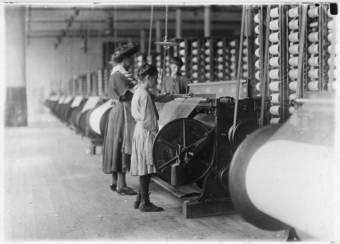
Girls running warping machines in Loray Mill, Gastonia, N.C. by Lewis Hine, 1908.
Any tool or machine that could be used to improve someone’s ability to work would be included in capital.
In regards to production, it also is important to know what capital is not. While capital may refer to funds invested in a business in other disciplines such as accounting, cash is not included in capital in terms of a production input in economics. Homes and personal automobiles are also not included in capital because these items are not directly tied to the production of goods or services.
Labor
Labor is a measure of the work done by human beings to create a manufactured output. Producers demand labor because it aids in producing output which can then be sold. In production, a worker will only be hired when the marginal revenue s/he brings in exceeds or equals the marginal cost of hiring that worker. The cost of one worker is the wage.
The value of labor varies based on the skills and talents that the individual worker brings to that job. If the job involves designing and building a computer, an engineer’s labor is more valuable than a tailor. If the job requires the manufacture of a suit, an employer would prefer the tailor. Other elements that influence the perception of the value of a specific type of labor in production include the amount of training necessary to execute the task and the barriers to conducting that type of work.
1.4.3: Production Recipients
The process of producing and distributing a good or service is called a supply chain, and it is composed of many economic actors.
Learning Objective
Identify the market actors involved in taking a product from the original producer to the consumer
Key Points
- Supply chains vary based on industry, the resources of the manufacturer, and market conditions.
- The purpose of a supply chain is to act as an integrating function that links major business functions and processes into a cohesive business model.
- Typical steps in a supply chain include: extraction of raw materials; acquisition of components; production; inventory; transportation; wholesaler; and retailer.
Key Term
- supply chain
-
A system of organizations, people, technology, activities, information and resources involved in moving a product or service from supplier to customer.
A supply chain is a system of organizations, people, activities, information and resources involved in moving a product or service from supplier to customer. The company’s supply chain illustrates the total process of transforming raw materials into a finished product, and then selling that finished product to consumers .
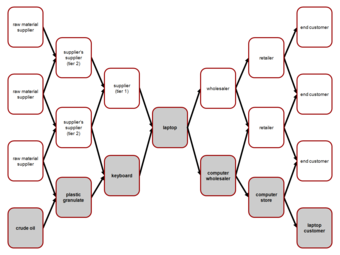
Supply Chain
This represents the typical supply chain for a computer. The right half of the chart represents the steps it takes from producing the final product to the consumers.
The purpose of a supply chain is to act as an integrating function that links major business functions and processes into a cohesive business model. When designed well, a supply chain is able to respond to shifts in demand and changes in the marketplace. Based on these shifts, the supply chain is able to alter production levels accordingly so that supply can meet demand so that the firm is able to maximize its profit.
Supply chains vary based on industry, the resources of the manufacturer, and market conditions. Some typical elements and actors in a supply chain include:
- Extraction/Acquisition of Raw Materials or Components. Before the production of a good can be initiated, you need to have all of the necessary elements. These elements could be unrefined raw materials that the company transforms into components or pre-assembled parts. A firm may have subsidiaries or divisions that obtain raw materials or it might acquire those elements from a third party.
- Production. This is the process that transforms the elements acquired from the prior step into the finished good. Economic actors involved in this step include product designers, assembly-line workers, and floor management.
- Inventory. Once the good is completed, it is generally placed into a centralized inventory location while decisions are made by inventory managers and a firm’s sales division.
- Transportation. Finished goods must be transported to stores and other locations where consumers can obtain the good. Depending on the type of business, goods may be transferred to smaller regional inventory depots, merchants, or directly to a consumer.
- Wholesaler. A wholesaler is someone who sells a good to smaller stores, who in turn sells the good to consumers.
- Retailer. The retailer buys the product in bulk and sells individual or smaller groups of units to the end consumer.
1.4.4: Differences Between Centrally Planned and Market Economies
The key difference between centrally planned and market economies is the degree of individual autonomy.
Learning Objective
Compare the characteristics of capitalist and socialist economic systems
Key Points
- A pure planned economy has one person or group who controls what is produced; all businesses work together to produce goods and services that are planned and distributed by the government.
- Planned economies have several advantages. Ideally, there is no unemployment, and needs never go unfulfilled; because the government knows how much food, medicine, and other goods is needed, it can produce enough for all.
- Realistically, these systems tend to suffer from large inefficiencies and are overall not as successful as other types of economic systems.
- A pure market economy is one perfectly free of external control. Individuals are left up to themselves to decide what to produce, who to work for, and how to get the things they need.
- Because there is no regulation ensuring equality and fairness, market economies are burdened with unemployment, and even those with jobs can never be certain that they will make enough to provide for all of their needs.
- Because they do not need to wait for word from the government before changing their output, companies under market economies can quickly keep up with fluctuations in the economy, tending to be more efficient than regulated markets.
Key Terms
- Centrally planned economy
-
When the government is responsible for setting the amount produced.
- autonomy
-
Self-government; freedom to act or function independently.
- market economy
-
An economy in which goods and services are exchanged in a free market, as opposed to a state-controlled or socialist economy; a capitalistic economy.
While there are many different variations of national economies, the two dominant economic coordination mechanisms are centrally planned and market based. Before you can analyze any national economy, you need to understand these two opposing viewpoints on how to run an economy. The key difference between the two is the amount of individual autonomy within the two systems.
Centrally Planned Economy
A pure planned economy has one person or group who controls what is produced; all businesses work together to produce goods and services that are planned and distributed by the government. These economies are also called command economies because everyone must follow specific guidelines set up by the controlling authority. The reason behind this type of planning is to make sure that everything needed is produced and that everyone’s needs are fulfilled. Since most peoples’ needs are provided for in a centrally planned economy, compensation is primarily morally based. Most assets are owned by the state.
Planned economies have several advantages. Ideally, there is no unemployment and needs never go unfulfilled. Because the government knows how much food, medicine, and other goods is needed, it can produce enough for all. But achieving these outcomes depends on the group that organizes production and distribution to accurately identify what the consumers will need, determine what it would take to meet those goals, and anticipate all possible situations. This means there are a lot of opportunities to make a mistake. Realistically, these systems tend to suffer from large inefficiencies and are overall not as successful as other types of economic systems.

V.I. Lenin
The Soviet Union, as established by V.I. Lenin, is an example of a country that tried to establish a pure centrally planned economy.
Market Based Economy
A pure market economy, or capitalist system, is one perfectly free from external control. Individuals may decide what to produce, who to work for, and how to get the things they need. They are compensated with material goods for their work, and most assets are privately owned. This type of economy, though it may be chaotic at times, allows people to change along with the shifting market conditions to maximize their profits. Although they avoid many of the inadequacies of planned economies, market economies are not free of their own problems and downfalls. Perhaps the greatest problem is that business firms may refuse to produce goods that unprofitable for them. For instance, in 2000 there was a shortage of tetanus vaccine in the United States. Because it was expensive to make, most companies were unwilling to start production themselves, leaving only one firm struggling to keep up with demand. In a planned economy, this shortage would not happen because the government would boost production of the vaccine if it were needed.
Because there is no regulation to ensure equality and fairness, market economies may be burdened with unemployment and even those with jobs can never be certain that they will make enough to provide for all of their needs. Despite these and other problems, market economies come with many advantages, chief among which is speed. Because they do not need to wait for word from the government before changing their output, companies under market economies can quickly keep up with fluctuations in the economy, tending to be more efficient than regulated markets. Also, individuals have more freedom and opportunities to do the jobs they want and to profit by them.
1.4.5: Mixed Economies
A mixed economy is a system that embraces elements of centrally planned and free market systems.
Learning Objective
Explain the characteristics of a mixed economy
Key Points
- Most of the means of production in a mixed economy are privately owned in a mixed economy.
- The government strongly influences the economy through direct intervention in a mixed economy, such as through subsidies and regulation of the markets.
- Most government intervention in mixed economy is limited to minimizing the negative consequences of economic events, such as unemployment in recessions, to promote social welfare.
Key Terms
- mixed economy
-
A system in which both the state and private sector direct the economy, reflecting characteristics of both market economies and planned economies.
- monopoly
-
A market where one company is the sole supplier.
A mixed economy is a system that embraces elements of centrally planned and free market systems. While there is no single definition of a mixed economy, it generally involves a degree of economic freedom mixed with government regulation of markets. Most modern economies are mixed, including the United States and Cuba. Countries hope that by embracing elements of both systems they can gain the benefits of both while minimizing the systems disadvantages.
In general, most of the means of production in a mixed economy are privately owned. There are some exceptions to this general rule, such as some hospitals and businesses. The mostly private ownership of all means of production allows the market to quickly respond to changing circumstances and economic factors. As a result, the market is generally the dominant form of economic coordination. However, to mitigate the negative influence that a pure market economy has on fairness and distribution, the government strongly influences the economy through direct intervention in a mixed economy. Different ways a government directly intervenes in an economy include:
- granting a business a monopoly,
- granting a subsidy to a sector,
- creating and enforcing regulation,
- direct participation in the market , or
- providing money and other resources segments of its populations, such as through a welfare program.
Most government intervention in mixed economy is limited to minimizing the negative consequences of economic events, such as unemployment in recessions, to promote social welfare.
While mixed economies vary based on their degree of government intervention, some elements are consistent. Generally, individuals in mixed economies are able to:
- participate in managerial decisions,
- travel,
- buy and sell items privately,
- hire and fire employees,
- organize organizations,
- communicate, and
- protest peacefully.
However, the government in mixed economies generally subsidizes public goods, such as roads and libraries, and provide welfare services such as social security. These governments also regulate labor and protect intellectual property.
1.5: Economic Models
1.5.1: Math Review
Mathematical economics uses mathematical methods, such as algebra and calculus, to represent theories and analyze problems in economics.
Learning Objective
Review basic algebra and calculus’ concepts relevant in introductory economics
Key Points
- Using mathematics allows economists to form meaningful, testable propositions about complex subjects that would be hard to express informally.
- Algebra is the study of operations and their application to solving equations. It provides structure and a definite direction for economists when they are analyzing complex data.
- Concepts in algebra that are used in economics include variables and algebraic expressions.
- Calculus is the mathematical study of change. Economists use calculus in order to study economic change whether it involves the world or human behavior.
- In economics, calculus is used to study and record complex information – commonly on graphs and curves.
Key Terms
- variable
-
something whose value may be dictated or discovered.
- quantitative
-
Of a measurement based on some number rather than on some quality.
As a social science, economics analyzes the production, distribution, and consumption of goods and services. The study of economics requires the use of mathematics in order to analyze and synthesize complex information.
Mathematical Economics
Mathematical economics is the application of mathematical methods to represent theories and analyze problems in economics. Using mathematics allows economists to form meaningful, testable propositions about complex subjects that would be hard to express informally. Math enables economists to make specific and positive claims that are supported through formulas, models, and graphs. Mathematical disciplines, such as algebra and calculus, allow economists to study complex information and clarify assumptions.
Algebra
Algebra is the study of operations and their application to solving equations. It provides structure and a definite direction for economists when they are analyzing complex data. Math deals with specified numbers, while algebra introduces quantities without fixed numbers (known as variables). Using variables to denote quantities allows general relationships between quantities to be expressed concisely. Quantitative results in science, economics included, are expressed using algebraic equations.
Concepts in algebra that are used in economics include variables and algebraic expressions. Variables are letters that represent general, non-specified numbers. Variables are useful because they can represent numbers whose values are not yet known, they allow for the description of general problems without giving quantities, they allow for the description of relationships between quantities that may vary, and they allow for the description of mathematical properties. Algebraic expressions can be simplified using basic math operations including addition, subtraction, multiplication, division, and exponentiation.
In economics, theories need the flexibility to formulate and use general structures. By using algebra, economists are able to develop theories and structures that can be used with different scenarios regardless of specific quantities.
Calculus
Calculus is the mathematical study of change. Economists use calculus in order to study economic change whether it involves the world or human behavior.
Calculus has two main branches:
- Differential calculus is the study of the definition, properties, and applications of the derivative of a function (rates of change and slopes of curves) . By finding the derivative of a function, you can find the rate of change of the original function.
- Integral calculus is the study of the definitions, properties, and applications of two related concepts, the indefinite and definite integral (accumulation of quantities and the areas under curves) .
Calculus is widely used in economics and has the ability to solve many problems that algebra cannot. In economics, calculus is used to study and record complex information – commonly on graphs and curves. Calculus allows for the determination of a maximal profit by providing an easy way to calculate marginal cost and marginal revenue. It can also be used to study supply and demand curves.
Common Mathematical Terms
Economics utilizes a number of mathematical concepts on a regular basis such as:
- Dependent Variable: The output or the effect variable. Typically represented as
, the dependent variable is graphed on the
-axis. It is the variable whose change you are interested in seeing when you change other variables. - Independent or Explanatory Variable: The inputs or causes. Typically represented as , ,
, etc., the independent variables are graphed on the
-axis. These are the variables that are changed in order to see how they affect the dependent variable. - Slope: The direction and steepness of the line on a graph. It is calculated by dividing the amount the line increases on the
-axis (vertically) by the amount it changes on the
-axis (horizontally). A positive slope means the line is going up toward the right on a graph, and a negative slope means the line is going down toward the right. A horizontal line has a slope of zero, while a vertical line has an undefined slope. The slope is important because it represents a rate of change. - Tangent: The single point at which two curves touch. The derivative of a curve, for example, gives the equation of a line tangent to the curve at a given point.
1.5.2: Assumptions
Economists use assumptions in order to simplify economics processes so that they are easier to understand.
Learning Objective
Assess the benefits and drawbacks of using simplifying assumptions in economics
Key Points
- Neo-classical economics employs three basic assumptions: people have rational preferences among outcomes that can be identified and associated with a value, individuals maximize utility and firms maximize profit, and people act independently on the basis of full and relevant information.
- An assumption allows an economist to break down a complex process in order to develop a theory and realm of understanding. Later, the theory can be applied to more complex scenarios for additional study.
- Critics have stated that assumptions cause economists to rely on unrealistic, unverifiable, and highly simplified information that in some cases simplifies the proofs of desired conclusions.
- Although simplifying can lead to a better understanding of complex phenomena, critics explain that the simplified, unrealistic assumptions cannot be applied to complex, real world situations.
Key Terms
- simplify
-
To make simpler, either by reducing in complexity, reducing to component parts, or making easier to understand.
- assumption
-
The act of taking for granted, or supposing a thing without proof; a supposition; an unwarrantable claim.
As a field, economics deals with complex processes and studies substantial amounts of information. Economists use assumptions in order to simplify economic processes so that it is easier to understand. Simplifying assumptions are used to gain a better understanding about economic issues with regards to the world and human behavior .

Simple indifference curve
An indifference curve is used to show potential demand patterns. It is an example of a graph that works with simplifying assumptions to gain a better understanding of the world and human behavior in relation to economics.
Economic Assumptions
Neo-classical economics works with three basic assumptions:
- People have rational preferences among outcomes that can be identified and associated with a value.
- Individuals maximize utility (as consumers) and firms maximize profit (as producers).
- People act independently on the basis of full and relevant information.
Benefits of Economic Assumptions
Assumptions provide a way for economists to simplify economic processes and make them easier to study and understand. An assumption allows an economist to break down a complex process in order to develop a theory and realm of understanding. Good simplification will allow the economists to focus only on the most relevant variables. Later, the theory can be applied to more complex scenarios for additional study.
For example, economists assume that individuals are rational and maximize their utilities. This simplifying assumption allows economists to build a structure to understand how people make choices and use resources. In reality, all people act differently. However, using the assumption that all people are rational enables economists study how people make choices.
Criticisms of Economic Assumptions
Although, simplifying assumptions help economists study complex scenarios and events, there are criticisms to using them. Critics have stated that assumptions cause economists to rely on unrealistic, unverifiable, and highly simplified information that in some cases simplifies the proofs of desired conclusions. Examples of such assumptions include perfect information, profit maximization, and rational choices. Economists use the simplified assumptions to understand complex events, but criticism increases when they base theories off the assumptions because assumptions do not always hold true. Although simplifying can lead to a better understanding of complex phenomena, critics explain that the simplified, unrealistic assumptions cannot be applied to complex, real world situations.
1.5.3: Hypotheses and Tests
Economics, as a science, follows the scientific method in order to study data, observe patterns, and predict results of stimuli.
Learning Objective
Apply the steps of the scientific method to economic questions
Key Points
- The scientific method involves identifying a problem, gathering data, forming a hypothesis, testing the hypothesis, and analyzing the results.
- A hypothesis is simply a prediction.
- In economics, extensive testing and observation is required because the outcome must be obtained more than once in order to be valid.
- Cause and effect relationships are used to establish economic theories and principles. Over time, if a theory or principle becomes accepted as universally true, it becomes a law. In general, a law is always considered to be true.
- The scientific method provides the framework necessary for the progression of economic study.
Key Term
- hypothesis
-
An assumption taken to be true for the purpose of argument or investigation.
Economics, as a science, follows the scientific method in order to study data, observe patterns, and predict results of stimuli.
There are specific steps that must be followed when using the scientific method . Economics follows these steps in order to study data and build principles:

Scientific Method
The scientific method is used in economics to study data, observe patterns, and predict results.
- Identify the problem – in the case of economics, this first step of the scientific method involves determining the focus or intent of the work. What is the economist studying? What is he trying to prove or show through his work?
- Gather data – economics involves extensive amounts of data. For this reason, it is important that economists can break down and study complex information. The second step of the scientific method involves selecting the data that will be used in the study.
- Hypothesis – the third step of the scientific method involves creating a model that will be used to make sense of all of the data. A hypothesis is simply a prediction. What does the economist think the overall outcome of the study will be?
- Test hypothesis – the fourth step of the scientific method involves testing the hypothesis to determine if it is true. This is a critical stage within the scientific method. The observations must be tested to make sure they are unbiased and reproducible. In economics, extensive testing and observation is required because the outcome must be obtained more than once in order for it to be valid. It is not unusual for testing to take some time and for economists to make adjustments throughout the testing process.
- Analyze the results – the final step of the scientific method is to analyze the results. First, an economist will ask himself if the data agrees with the hypothesis. If the answer is “yes,” then the hypothesis was accurate. If the answer is “no,” then the economist must go back to the original hypothesis and adjust the study accordingly. A negative result does not mean that the study is over. It simply means that more work and analysis is required.
Observation of data is critical for economists because they take the results and interpret them in a meaningful way. Cause and effect relationships are used to establish economic theories and principles. Over time, if a theory or principle becomes accepted as universally true, it becomes a law. In general, a law is always considered to be true. The scientific method provides the framework necessary for the progression of economic study. All economic theories, principles, and laws are generalizations or abstractions. Through the use of the scientific method, economists are able to break down complex economic scenarios in order to gain a deeper understanding of critical data.
1.5.4: Economic Models
A model is simply a framework that is designed to show complex economic processes.
Learning Objective
Recognize the uses and limitations of economic models
Key Points
- Many models use mathematical techniques in order to investigate, theorize, and fit theories into economic situations.
- Economic models have two functions: 1) to simplify and abstract from observed data, and 2) to serve as a means of selection of data based on a paradigm of econometric study.
- Creating a model has two basic steps: 1) generate the model, and 2) checking the model for accuracy – also known as diagnostics.
- Examples of the uses of economic models include: professional academic interest, forecasting economic activity, proposing economic policy, presenting reasoned arguments to politically justify economic policy, as well as economic planning and allocation.
Key Terms
- deductive
-
Based on inferences from general principles.
- diagnostics
-
The process of determining the state of or capability of a component to perform its function(s).
- qualitative
-
Based on descriptions or distinctions rather than on some quantity.
Economic Models
In economics, a model is defined as a theoretical construct that represents economic processes through a set of variables and a set of logical or quantitative relationships between the two. A model is simply a framework that is designed to show complex economic processes. Most models use mathematical techniques in order to investigate, theorize, and fit theories into economic situations.
Uses of an Economic Model
Economists use models in order to study and portray situations. The focus of a model is to gain a better understanding of how things work, to observe patterns, and to predict the results of stimuli . Models are based on theory and follow the rules of deductive logic.

Economic model diagram
In economics, models are used in order to study and portray situations and gain a better understand of how things work.
Economic models have two functions: 1) to simplify and abstract from observed data, and 2) to serve as a means of selection of data based on a paradigm of econometric study. Economic processes are known to be enormously complex, so simplification to gain a clearer understanding is critical. Selecting the correct data is also very important because the nature of the model will determine what economic facts are studied and how they will be compiled.
Examples of the uses of economic models include: professional academic interest, forecasting economic activity, proposing economic policy, presenting reasoned arguments to politically justify economic policy, as well as economic planning and allocation.
Constructing a Model
The construction and use of a model will vary according to the specific situation. However, creating a model does have two basic steps: 1) generate the model, and 2) checking the model for accuracy – also known as diagnostics. The diagnostic step is important because a model is only useful if the data and analysis is accurate.
Limitations of a Model
Due to the complexity of economic models, there are obviously limitations that come into account. First, all of the data provided must be complete and accurate in order for the analysis to be successful. Also, once the data is entered, it must be analyzed correctly. In most cases, economic models use mathematical or quantitative analysis. Within this realm of observation, accuracy is very important. During the construction of a model, the information will be checked and updated as needed to ensure accuracy. Some economic models also use qualitative analysis. However, this kind of analysis is known for lacking precision. Furthermore, models are fundamentally only as good as their founding assumptions.
The use of economic models is important in order to further study and understand economic processes. Steps must be taken throughout the construction of the model to ensure that the data provided and analyzed is correct.
1.5.5: Normative and Positive Economics
Positive economics is defined as the “what is” of economics, while normative economics focuses on the “what ought to be”.
Learning Objective
Contrast normative and positive statements about economic policy
Key Points
- Positive economics is a branch of economics that focuses on the description and explanation of phenomena, as well as their casual relationships.
- Positive economics clearly states an economic issue and normative economics provides the value-based solution for the issue.
- Normative economics is a branch of economics that expresses value or normative judgments about economic fairness. It focuses on what the outcome of the economy or goals of public policy should be.
- Positive economics does impact normative economics because it ranks economic polices or outcomes based on acceptability (normative economics).
Key Terms
- normative economics
-
Economic thought in which one applies moral beliefs, or judgment, claiming that an outcome is “good” or “bad”.
- positive economics
-
The description and explanation of economic phenomena and their causal relationships.
Positive and normative economic thought are two specific branches of economic reasoning. Although they are associated with one another, positive and normative economic thought have different focuses when analyzing economic scenarios.
Positive Economics
Positive economics is a branch of economics that focuses on the description and explanation of phenomena, as well as their casual relationships. It focuses primarily on facts and cause-and-effect behavioral relationships, including developing and testing economic theories. As a science, positive economics focuses on analyzing economic behavior. It avoids economic value judgments. For example, positive economic theory would describe how money supply growth impacts inflation, but it does not provide any guidance on what policy should be followed. “The unemployment rate in France is higher than that in the United States” is a positive economic statement. It gives an overview of an economic situation without providing any guidance for necessary actions to address the issue.
Normative Economics
Normative economics is a branch of economics that expresses value or normative judgments about economic fairness. It focuses on what the outcome of the economy or goals of public policy should be. Many normative judgments are conditional. They are given up if facts or knowledge of facts change. In this instance, a change in values is seen as being purely scientific. Welfare economist Amartya Sen explained that basic (normative) judgments rely on knowledge of facts.
An example of a normative economic statement is “The price of milk should be $6 a gallon to give dairy farmers a higher living standard and to save the family farm. ” It is a normative statement because it reflects value judgments. It states facts, but also explains what should be done. Normative economics has subfields that provide further scientific study including social choice theory, cooperative game theory, and mechanism design.
Relationship Between Positive and Normative Economics
Positive economics does impact normative economics because it ranks economic policies or outcomes based on acceptability (normative economics). Positive economics is defined as the “what is” of economics, while normative economics focuses on the “what ought to be. ” Positive economics is utilized as a practical tool for achieving normative objectives. In other words, positive economics clearly states an economic issue and normative economics provides the value-based solution for the issue .
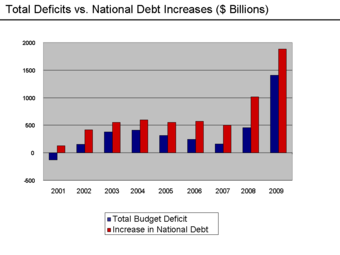
Debt Increases
This graph shows the debt increases in the United States from 2001-2009. Positive economics would provide a statement saying that the debt has increased. Normative economics would state what needs to be done in order to work towards resolving the issue of increasing debt.
1.6: Differences Between Macroeconomics and Microeconomics
1.6.1: Macroeconomics
Macroeconomics is the study of the performance, structure, behavior and decision-making of an economy as a whole.
Learning Objective
Define macroeconomics and identify the main users of macroeconomics
Key Points
- For most macroeconomists, the purpose of this discipline is to maximize national income and provide national economic growth.
- The most common macroeconomic topics of study for national entities are sustainability, full employment, price stability, external balance, equitable distribution of income and wealth, and increasing productivity.
- Macroeconomists hope that their models help address two key areas of research: the causes and consequences of short-run fluctuations in national income (otherwise known as the business cycle) and what determines long-run economic growth.
Key Terms
- Macroeconomics
-
The study of the performance, structure, behavior, and decision-making of an economy as a whole, rather than individual markets.
- deflation
-
A decrease in the general price level, that is, in the nominal cost of goods and services.
- inflation
-
An increase in the general level of prices or in the cost of living.
Macroeconomics is the study of the performance, structure, behavior and decision-making of an economy as a whole . Macroeconomists focus on the national, regional, and global scales. For most macroeconomists, the purpose of this discipline is to maximize national income and provide national economic growth. Economists hope that this growth translates to increased utility and an improved standard of living for the economy’s participants. While there are variations between the objectives of different national and international entities, most follow the ones detailed below:

Circulation in Macroeconomics
Macroeconomics studies the performance of national or global economies and the interaction of certain entities at the these level.
- Sustainability occurs when an economy achieves a rate of growth which allows an increase in living standards without undue structural and environmental difficulties.
- Full employment occurs when those who are able and willing to have a job can get one. Most economists believe that there will always be a certain amount of frictional, seasonal and structural unemployment (referred to as the natural rate of unemployment). As a result, full employment does not mean zero unemployment.
- Price stability occurs when prices remain largely stable and there is not rapid inflation or deflation. Price stability is not necessarily zero inflation; steady levels of low-to-moderate inflation is often regarded as ideal.
- External balance occurs when exports roughly equal imports over the long run.
- Equitable distribution of income and wealth among the economy’s participants. This does not, however, mean that income and wealth are the same for everyone.
- Increasing Productivity over time throughout the national economy.
To achieve these goals, macroeconomists develop models that explain the relationship between factors such as national income, output, consumption, unemployment, inflation, savings, investment and international trade. These models rely on aggregated economic indicators such as GDP, unemployment, and price indices.
On the national level, macroeconomists hope that their models help address two key areas of research:
- the causes and consequences of short-run fluctuations in national income, otherwise known as the business cycle, and
- what determines long-run economic growth.
1.6.2: Microeconomics
Microeconomics deals with the economic interactions of a specific person, a single entity or a company; it is the study of markets.
Learning Objective
Define Microeconomics, Identify the main users of microeconomics
Key Points
- One of the major goals of microeconomics is to analyze the market and determine the price for goods and services that best allocates limited resources among the different alternative uses.
- Microeconomics assumes businesses are rational and produce goods that maximize their profit.
- The science of microeconomics covers a variety of specialized areas of study including: industrial organization, labor economics, financial economics, public economics, political economy, health economics, urban economics, law and economics, and economic history.
Key Terms
- microeconomics
-
That field that deals with the small-scale activities such as that of the individual or company.
- Scarcity
-
an inadequate amount of something; a shortage
Microeconomics deals with the economic interactions of a specific person, a single entity, or a company. These interactions, which mainly are buying and selling goods, occur in markets. Therefore, microeconomics is the study of markets. The two key elements of this economic science are the interaction between supply and demand and scarcity of goods .

Supply and Demand Graph
Microeconomics is based on the study of supply and demand at the personal and corporate level.
One of the major goals of microeconomics is to analyze the market and determine the price for goods and services that best allocates limited resources among the different alternative uses. This study is especially important for producers as they decide what to manufacture and the appropriate selling price. Microeconomics assumes businesses are rational and produce goods that maximizes their profit. If each firm takes the most profitable path, the principles of microeconomics state that the market’s limited resources will be allocated efficiently.
The science of microeconomics covers a variety of specialized areas of study including:
- Industrial Organization: the entry and exit of firms, innovation, and the role of trademarks.
- Labor Economics: wages, employment, and labor market dynamics.
- Financial Economics: topics such as optimal portfolios, the rate of return to capital, and corporate financial behavior.
- Public Economics:the design of government tax and expenditure policies.
- Political Economics: the role of political institutions in policy.
- Health Economics: the organization of health care system.
- Urban Economics: challenges faced by cities, such as sprawl, traffic congestion, and poverty.
- Law and Economics: applies economic principles to the selection and enforcement of legal regimes.
- Economic History: the history and evolution of the economy.
1.6.3: Key Differences
Microeconomics focuses on individual markets, while macroeconomics focuses on whole economies.
Learning Objective
Recognize questions addressed by microeconomics and macroeconomics
Key Points
- Microeconomics and macroeconomics both focus on the allocation of scarce resources. Both disciplines study how the demand for certain resources interacts with the ability to supply that good to determine how to best distribute and allocate that resource among many consumers.
- Microeconomics studies the behavior of individual households and firms in making decisions on the allocation of limited resources. Another way to phrase this is to say that microeconomics is the study of markets.
- Macroeconomics is generally focused on countrywide or global economics. It studies involves the sum total of economic activity, dealing with the issues such as growth, inflation, and unemployment.
- There are some economic events that are of great interest to both microeconomists and macroeconomists, but they will differ in how and why they analyze the events.
Key Terms
- Macroeconomics
-
The study of the performance, structure, behavior, and decision-making of an economy as a whole, rather than individual markets.
- microeconomics
-
The study of the behavior of individual households and firms in making decisions on the allocation of limited resources.
- inflation
-
An increase in the general level of prices or in the cost of living.
Stemming from Adam Smith’s seminal book, The Wealth of Nations, microeconomic and macroeconomics both focus on the allocation of scarce resources . Both disciplines study how the demand for certain resources interacts with the ability to supply that good to determine how to best distribute and allocate that resource among many consumers. Both disciplines are about maximization: microeconomics is about maximizing profit for firms, and surplus for consumers and producers, while macroeconomics is about maximizing national income and growth.

Adam Smith, Founding Father of Economics
Adam Smith’s book, Wealth of Nations, was the basis of both microeconomic and macroeconomic study.
The main difference between microeconomics and macroeconomics is scale. Microeconomics studies the behavior of individual households and firms in making decisions on the allocation of limited resources. Another way to phrase this is to say that microeconomics is the study of markets.
In contrast macroeconomics involves the sum total of economic activity, dealing with the issues such as growth, inflation, and unemployment. Macroeconomics is the study of economies on the national, regional or global scale.
This key difference alters how the two approach economic situations. Microeconomics does consider how macroeconomic forces impact the world, but it focuses on how those forces impact individual firms and industries. While macroeconomists study the economy as a whole, microeconomists are concerned with specific firms or industries.
Many economic events that are of great interest to both microeconomist and macroeconomists, though they differ in how they analyze those events. A shift in tax policy would interest economists in both disciplines. A microeconomist might focus on how the tax might shift supply in a specific market or influence a firm’s decision making, while the macroeconomist will consider whether the tax will translate into an improved standard of living for all of the economy’s participants.
